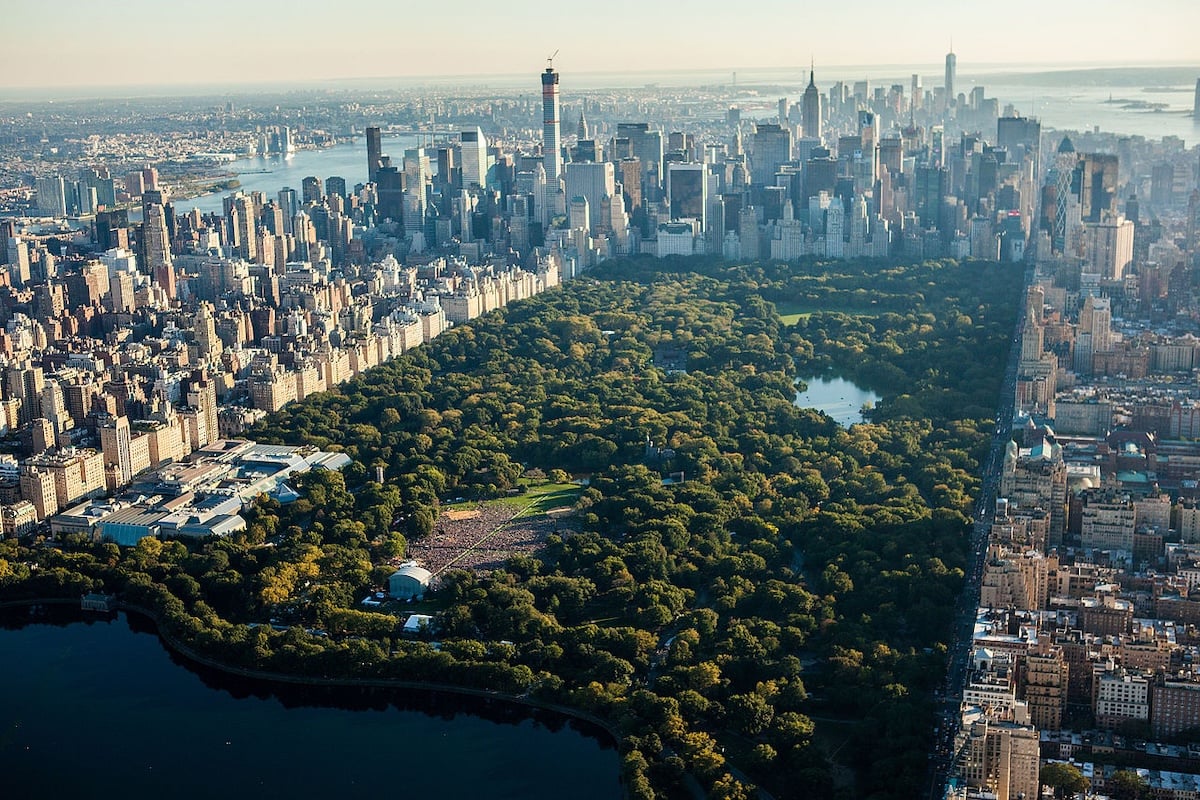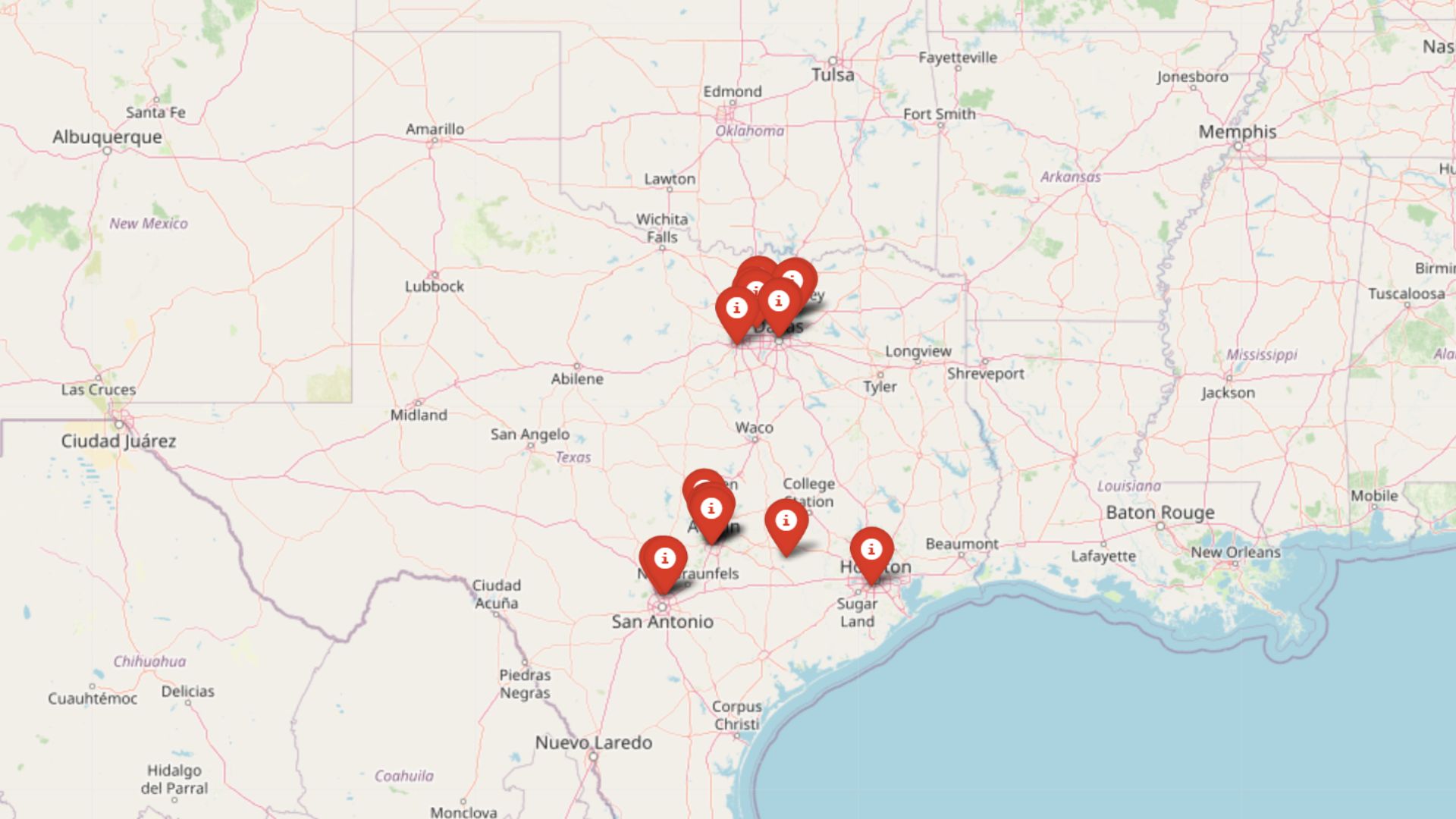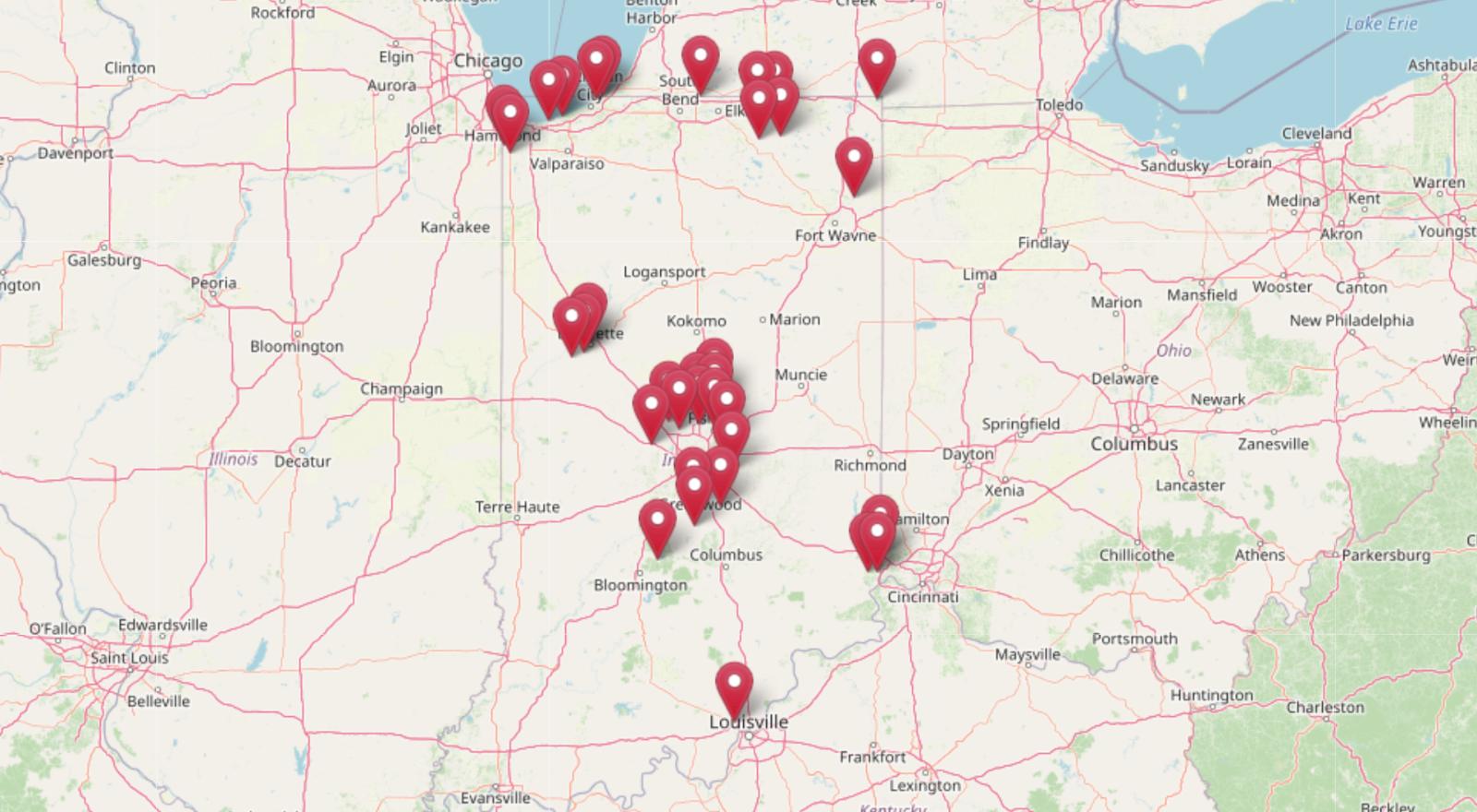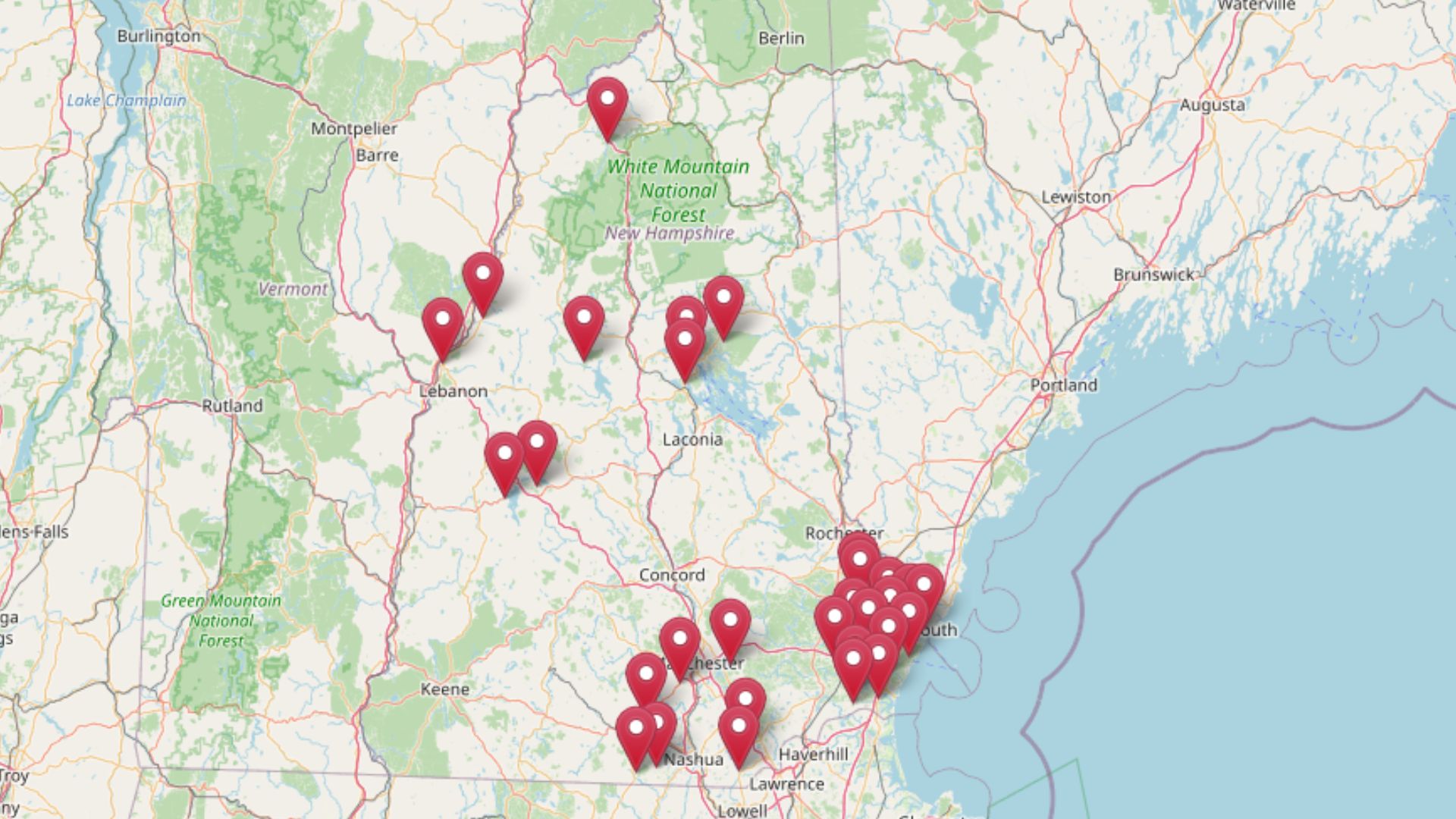
Using the latest Zillow Home Value Index data, we’ve ranked the 30 most expensive towns in New Hampshire based on current home prices. These coastal and mountain communities represent some of the strongest real estate markets in the Granite State. From historic seaports to college towns, each location shows why buyers continue to pay premium prices for a slice of New Hampshire living.
These aren’t just pricey places—they’re communities where natural beauty meets economic stability. Whether you’re tracking investment opportunities or curious about New Hampshire’s housing trends, this breakdown reveals where home values have climbed highest and what drives those sky-high price tags.
30. Franconia – 125% Home Price Increase Since 2016
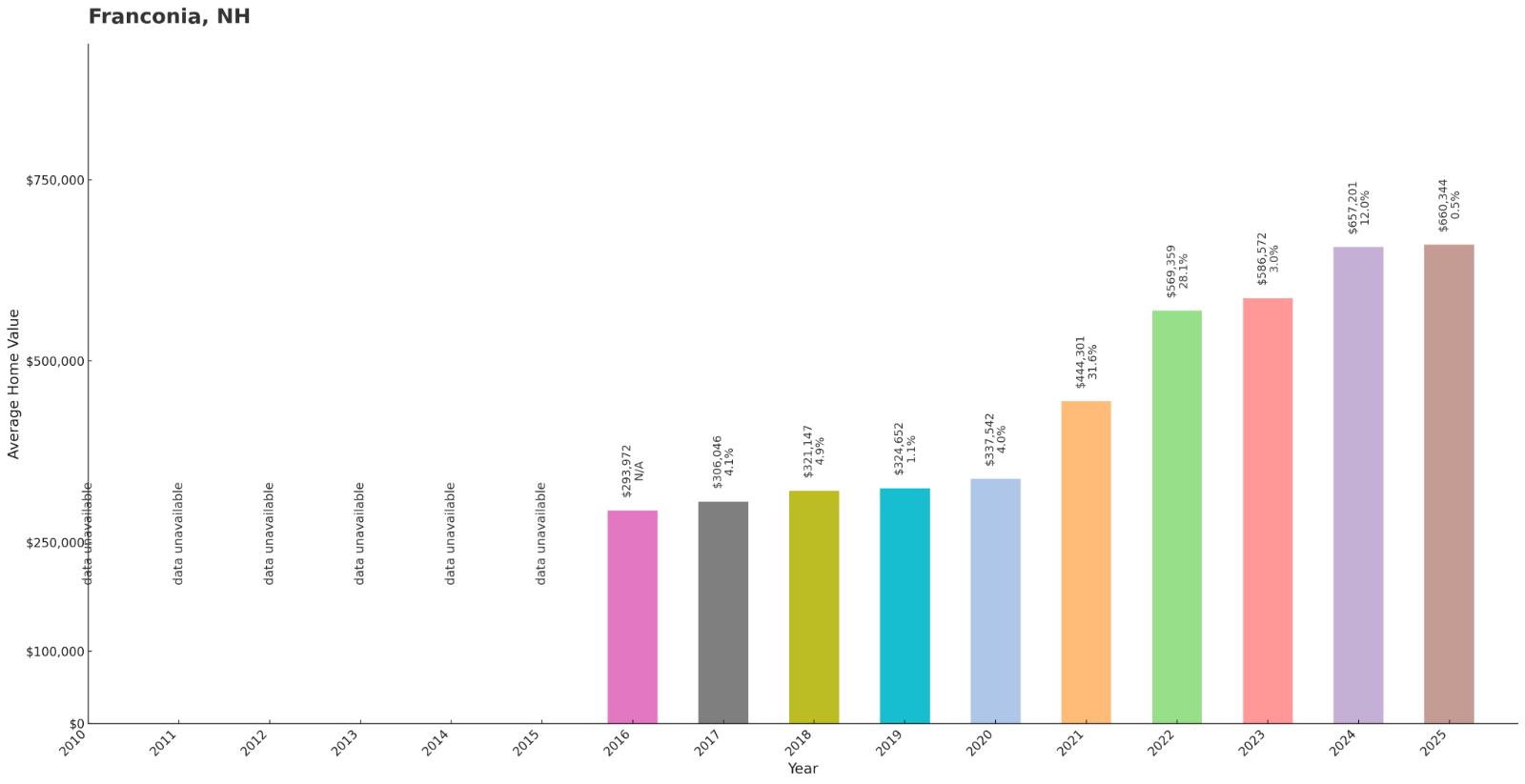
- 2010: N/A
- 2011: N/A
- 2012: N/A
- 2013: N/A
- 2014: N/A
- 2015: N/A
- 2016: $293,972
- 2017: $306,046
- 2018: $321,147
- 2019: $324,652
- 2020: $337,542
- 2021: $444,301
- 2022: $569,359
- 2023: $586,572
- 2024: $657,201
- 2025: $660,344
Franconia’s mountain setting in northern New Hampshire has pushed home prices up dramatically from 2016 to 2025. The town experienced its biggest jump between 2020 and 2021, when values increased by more than $100,000. Current median home values of $660,344 reflect strong demand for White Mountain properties.
Why Franconia?
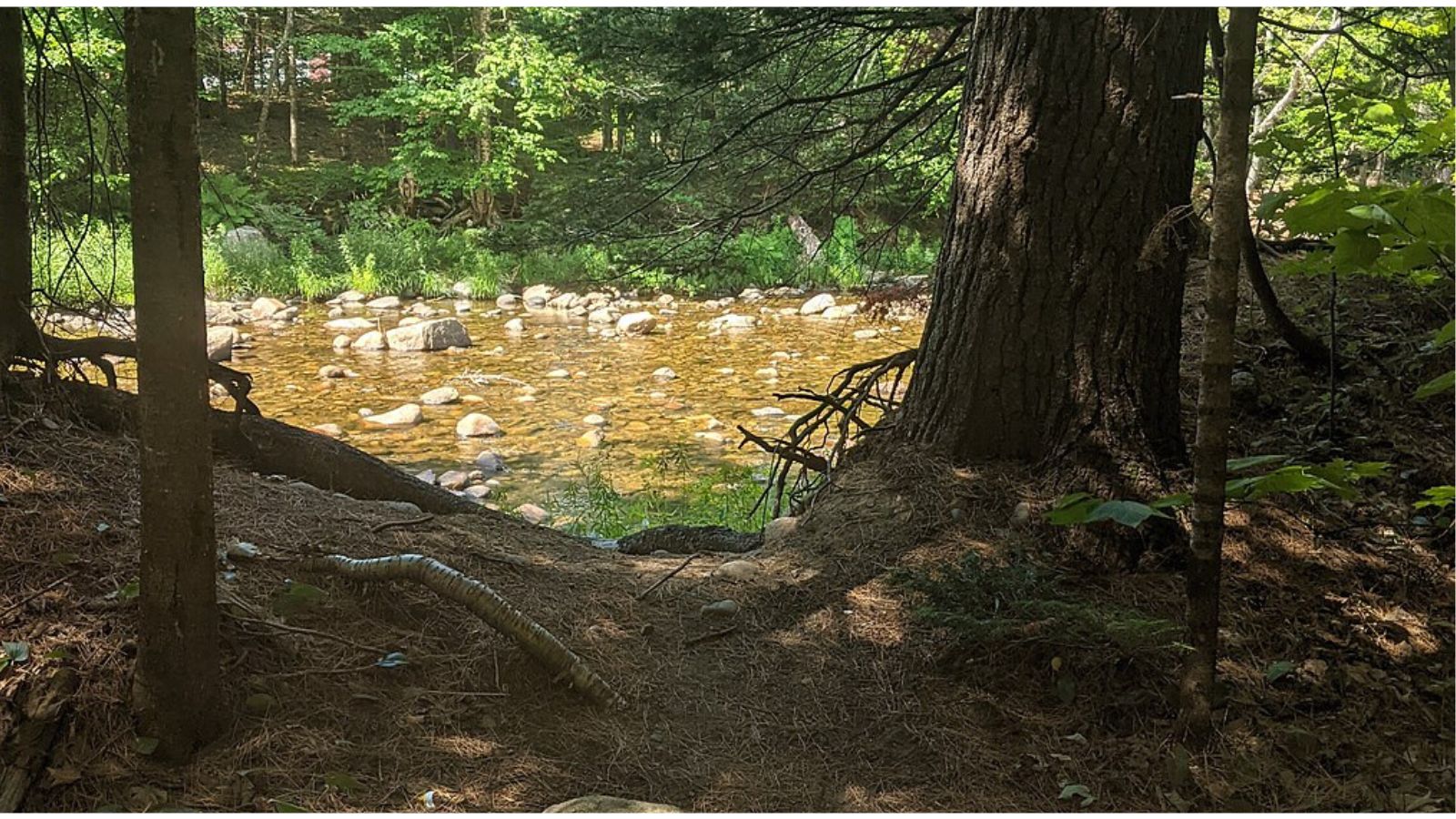
Why are people willing to pay so much to live here? What’s special about it?
Franconia sits at the heart of White Mountain recreation, offering year-round outdoor activities from skiing at Cannon Mountain to hiking the Appalachian Trail. The town provides small-community charm with easy access to mountain adventures and seasonal tourism opportunities. Buyers value the combination of scenic beauty, low crime rates, and proximity to both nature and Interstate 93 for commuting south.
Unlike more developed ski towns, Franconia maintains its rural character while offering modern amenities and strong property appreciation. The area’s tourism economy provides both rental income potential and seasonal employment opportunities for residents. Limited development and strict zoning help preserve the mountain views and natural setting that drive property values.
How Franconia Rose to Prominence
Franconia’s reputation grew from its position as a gateway to the White Mountains and home to the famous Old Man of the Mountain before its collapse in 2003. The town became a destination for tourists and outdoor enthusiasts drawn to Franconia Notch State Park and Cannon Mountain Ski Area. Railroad access in the 19th century first brought visitors to experience the mountain scenery.
The development of Interstate 93 in the 1960s made Franconia more accessible to Boston-area buyers seeking mountain retreats. Poet Robert Frost’s connection to the area, where he lived and wrote for many years, added cultural prestige to the community. Modern buyers are attracted by the same wilderness access and natural beauty that drew visitors over a century ago.
3 Interesting Tidbits
- Poetry Connection – Franconia was home to Robert Frost for several years, and many of his famous poems were inspired by the local landscape and changing seasons.
- Natural Landmark – The town was once home to the Old Man of the Mountain, New Hampshire’s state symbol, which drew millions of visitors before its collapse in 2003.
- Outdoor Paradise – Franconia offers direct access to both downhill skiing at Cannon Mountain and some of the best hiking in New England, including the Franconia Ridge Loop.
29. Amherst – 103% Home Price Increase Since 2010
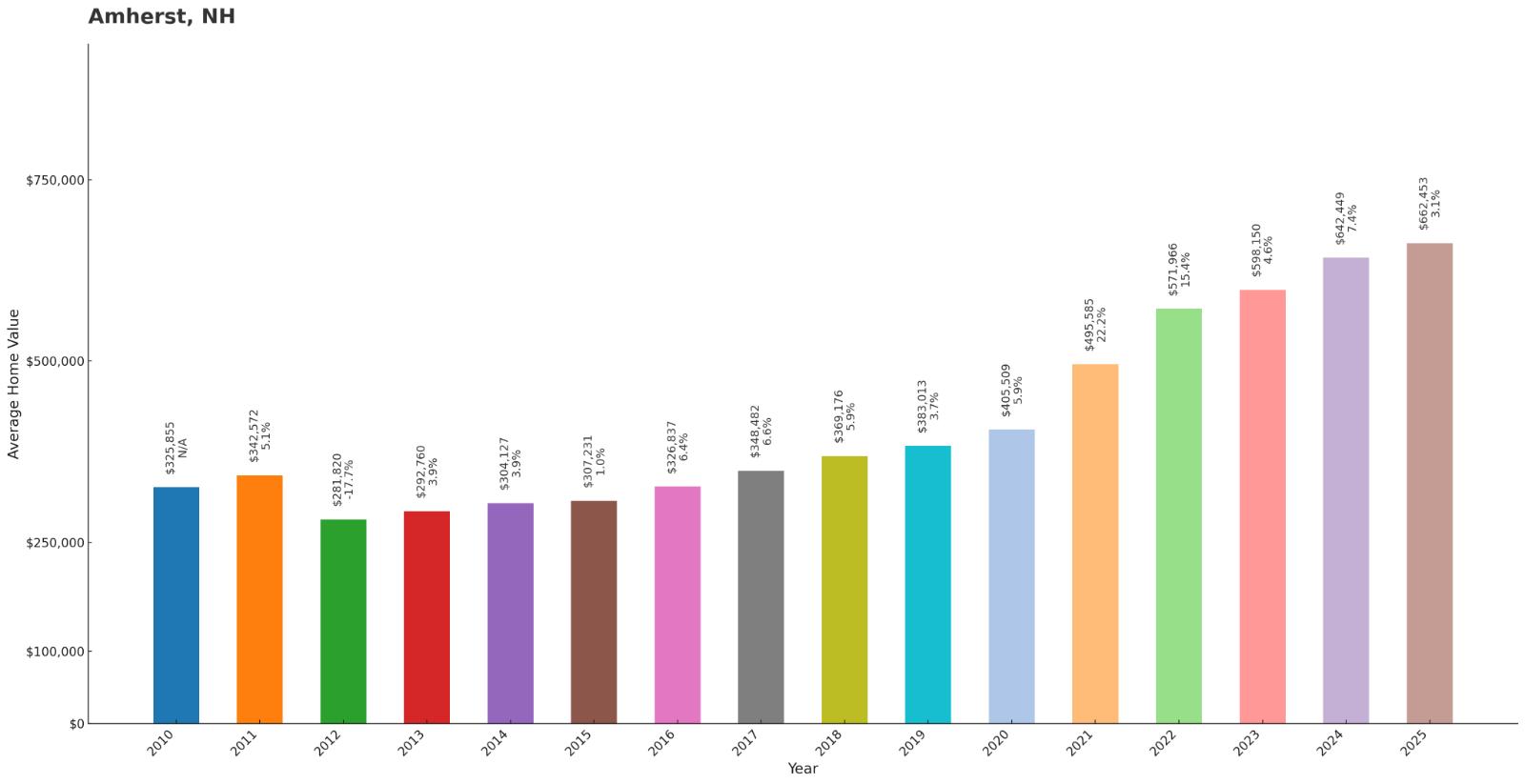
- 2010: $325,855
- 2011: $342,572
- 2012: $281,820
- 2013: $292,760
- 2014: $304,127
- 2015: $307,231
- 2016: $326,837
- 2017: $348,482
- 2018: $369,176
- 2019: $383,013
- 2020: $405,509
- 2021: $495,585
- 2022: $571,966
- 2023: $598,150
- 2024: $642,449
- 2025: $662,453
Amherst has doubled in value since 2010, with steady growth interrupted only by a dip in 2012. The town saw its strongest appreciation between 2020 and 2022, when values jumped by over $160,000. Current median home prices of $662,453 reflect the community’s desirability as an upscale suburb south of Manchester.
Why Amherst?
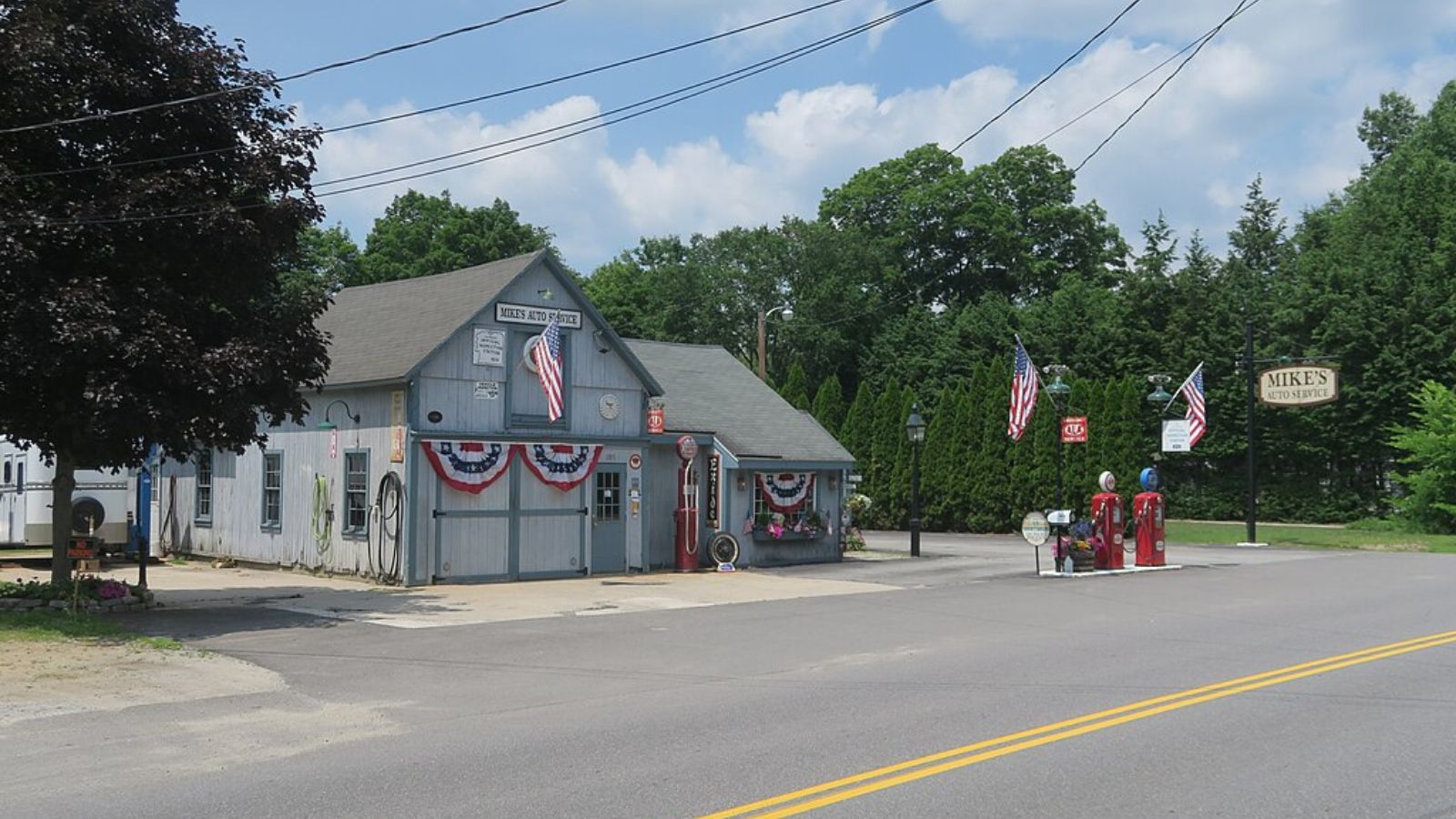
Why are people willing to pay so much to live here? What’s special about it?
Amherst offers the perfect suburban lifestyle for families seeking excellent schools, large lots, and easy access to both Boston and Manchester employment centers. The town consistently ranks among New Hampshire’s top school districts, making it highly attractive to parents. Low crime rates and well-maintained neighborhoods create a safe, stable environment for raising children.
The community balances rural character with suburban conveniences, offering walking trails, conservation land, and proximity to shopping centers. Buyers appreciate the town’s careful growth management and zoning that preserves property values. Amherst provides the benefits of small-town living while remaining within commuting distance of major job markets.
How Amherst Rose to Prominence
Amherst’s transformation began in the 1960s and 70s as suburban development spread south from Manchester along Route 101. Originally an agricultural community founded in the 18th century, the town attracted families seeking larger lots and newer homes than available in older cities. The construction of Route 101 as a major east-west corridor made commuting to Boston feasible.
The Souhegan High School’s reputation for academic excellence attracted families throughout the region, establishing Amherst as a premium school district. Careful planning and zoning decisions preserved the town’s rural feel while accommodating growth. The community’s commitment to maintaining large lot sizes and protecting green space helped establish its reputation as an upscale destination.
3 Interesting Tidbits
- School Excellence – Souhegan High School consistently ranks among New Hampshire’s top public high schools and has won national recognition for innovative education programs.
- Conservation Leader – Amherst has preserved more than 2,000 acres of conservation land through private donations and municipal purchases, maintaining its rural character.
- Revolutionary Roots – The town was named after General Jeffery Amherst and played a role in the Revolutionary War, with several historic sites still preserved today.
28. Meredith – 146% Home Price Increase Since 2010
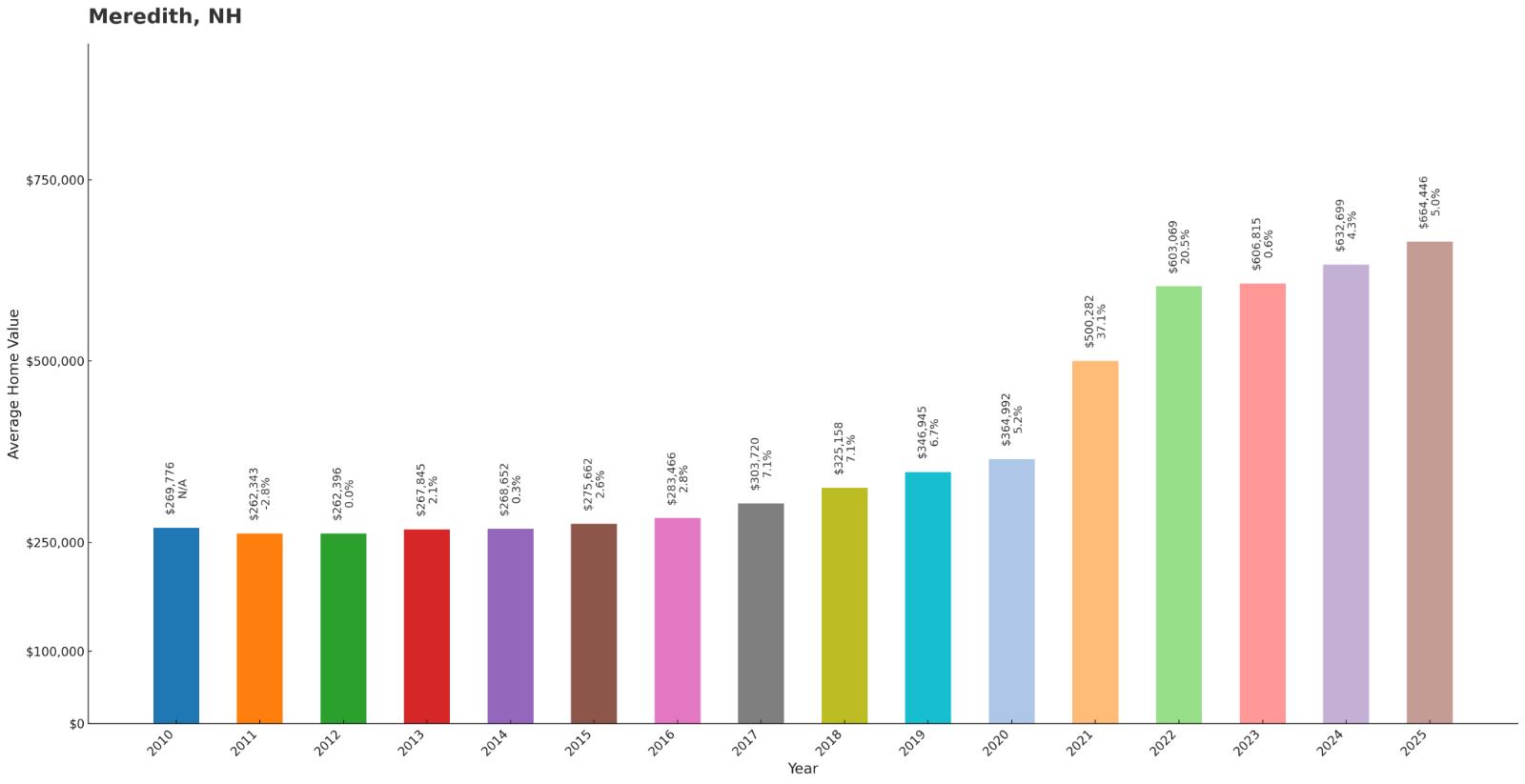
- 2010: $269,776
- 2011: $262,343
- 2012: $262,396
- 2013: $267,845
- 2014: $268,652
- 2015: $275,662
- 2016: $283,466
- 2017: $303,720
- 2018: $325,158
- 2019: $346,945
- 2020: $364,992
- 2021: $500,282
- 2022: $603,069
- 2023: $606,815
- 2024: $632,699
- 2025: $664,446
Meredith has experienced remarkable growth, more than doubling since 2010. The most dramatic increase occurred between 2020 and 2021, when values jumped by over $135,000 in a single year. Home prices reaching $664,446 reflect the community’s position as a premier Lakes Region destination.
Why Meredith?
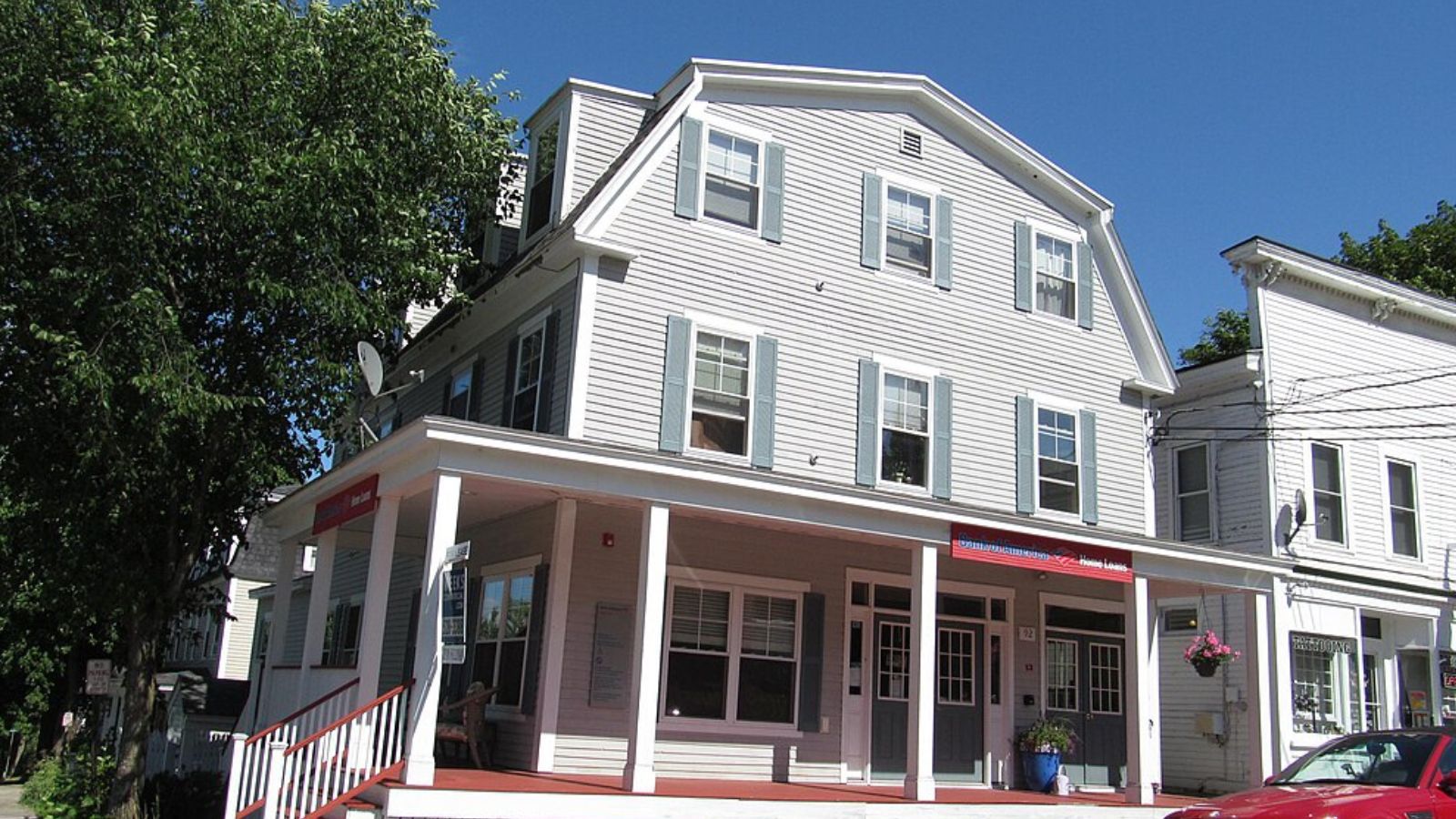
Why are people willing to pay so much to live here? What’s special about it?
Meredith sits on the shores of Lake Winnipesaukee, offering waterfront living and lake access that attracts both year-round residents and seasonal homeowners. The town provides a perfect blend of recreation, natural beauty, and small-town atmosphere that appeals to retirees and families alike. Boating, swimming, and fishing opportunities are available right outside residents’ doors.
The community offers excellent restaurants, shops, and cultural events while maintaining its charming New England character. Property owners enjoy strong rental income potential during tourist season and steady appreciation driven by limited lakefront inventory. Meredith’s location provides easy access to mountains, lakes, and coastal areas throughout the region.
How Meredith Rose to Prominence
Meredith’s development as a resort destination began in the mid-1800s when railroads brought wealthy Boston families to summer cottages along Lake Winnipesaukee. The town became known for its grand hotels and steamboat excursions, establishing a tradition of tourism and seasonal residents. Mills along the Winnipesaukee River provided early economic foundation beyond tourism.
The construction of Interstate 93 made the Lakes Region more accessible to urban populations, increasing demand for both vacation homes and year-round residences. Meredith’s position at the geographic center of the lake, combined with its well-maintained downtown and marina facilities, cemented its role as the region’s hub. Modern development has balanced growth with preservation of the town’s historic character and natural beauty.
3 Interesting Tidbits
- Steamboat Legacy – Meredith is home to the M/S Mount Washington, the largest cruise ship on Lake Winnipesaukee, continuing a tradition of passenger vessels dating back to 1872.
- Sculpture Walk – The town hosts an annual Sculpture Walk featuring large-scale outdoor art installations that attract visitors from across New England.
- Mill History – Historic mills along the Winnipesaukee River powered early industry, and several mill buildings have been converted into shops, restaurants, and housing.
27. Brookline – 165% Home Price Increase Since 2010
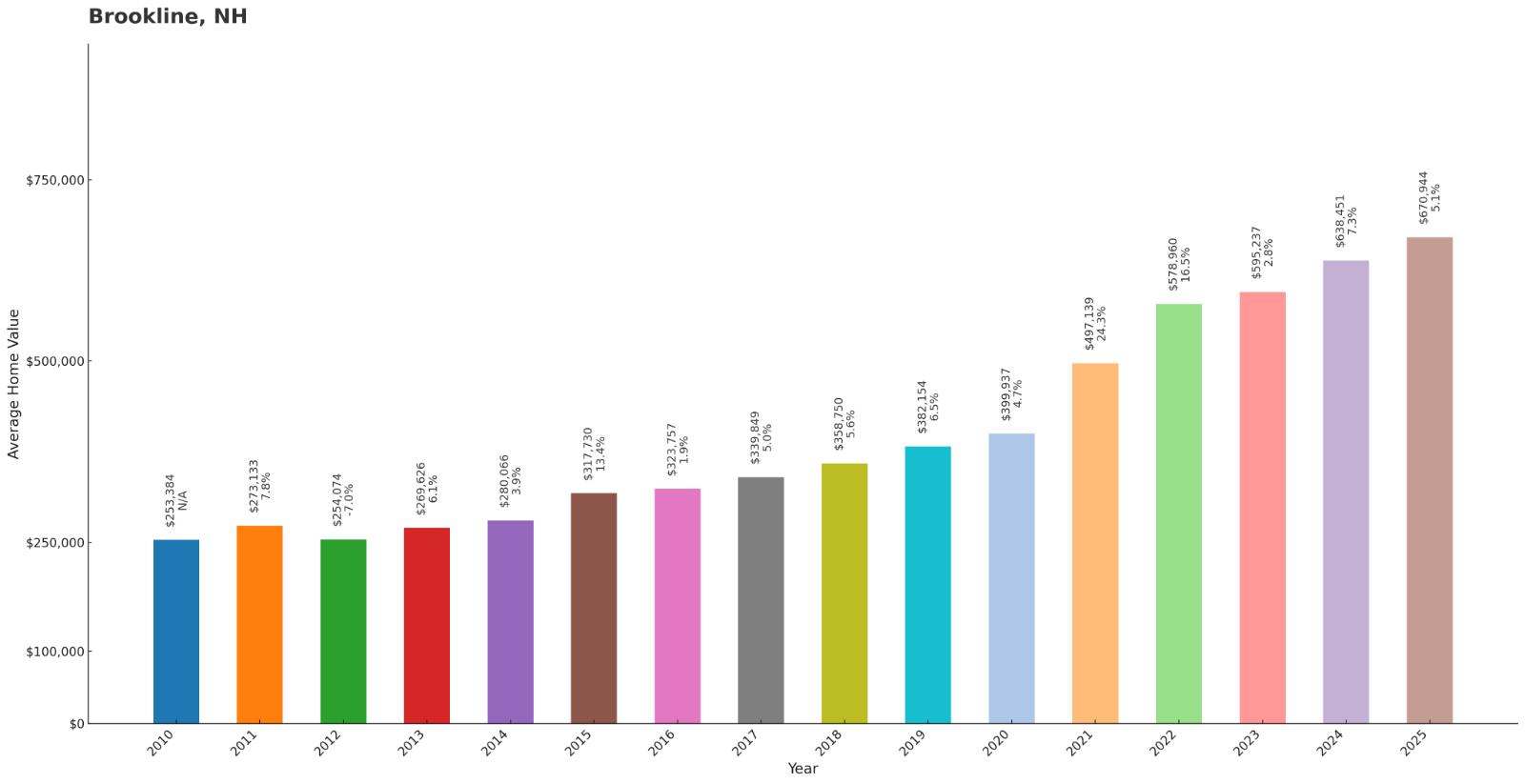
- 2010: $253,384
- 2011: $273,133
- 2012: $254,074
- 2013: $269,626
- 2014: $280,066
- 2015: $317,730
- 2016: $323,757
- 2017: $339,849
- 2018: $358,750
- 2019: $382,154
- 2020: $399,937
- 2021: $497,139
- 2022: $578,960
- 2023: $595,237
- 2024: $638,451
- 2025: $670,944
Brookline shows impressive growth, increasing by 165% since 2010 from a starting point of just over $253,000. The town experienced steady appreciation with a significant acceleration after 2020, reaching current median values of $670,944. This southern New Hampshire community benefits from proximity to Massachusetts employment centers.
Why Brookline?
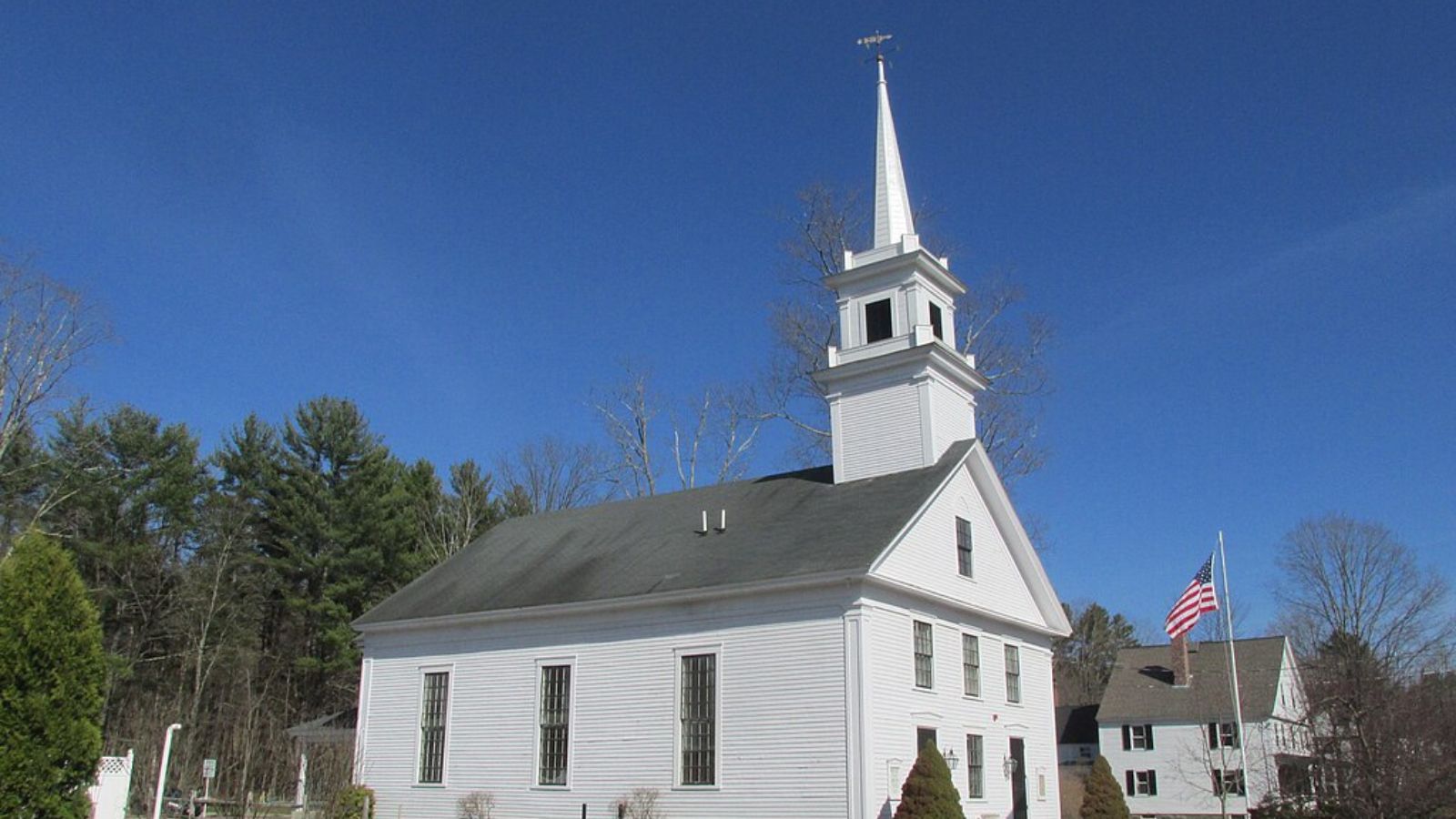
Why are people willing to pay so much to live here? What’s special about it?
Brookline provides the ideal combination of rural New Hampshire living with easy access to Boston-area job markets. The town offers large lots, excellent schools, and a strong sense of community that attracts families seeking space and safety. Low population density and careful development preserve the town’s rural character.
Residents enjoy significantly lower taxes than Massachusetts while maintaining reasonable commuting distances to major employment centers. The town’s location along Route 13 provides convenient access to both Nashua and Massachusetts highways. Brookline’s commitment to preserving open space and managing growth carefully protects property values and quality of life.
How Brookline Rose to Prominence
Brookline’s development accelerated in the 1970s and 80s as Boston-area professionals discovered they could live in rural New Hampshire while commuting to work in Massachusetts. Originally settled in the 1760s as an agricultural community, the town remained rural until suburban expansion reached southern New Hampshire. The construction of Route 3 and improvements to Route 13 made commuting feasible.
The town’s attractive rural setting, combined with New Hampshire’s tax advantages, drew families seeking larger properties than they could afford in Massachusetts. Careful planning and large minimum lot sizes helped preserve the community’s rural character while accommodating growth. Brookline’s strategic location between Nashua and the Massachusetts border made it a natural choice for cross-border commuters.
3 Interesting Tidbits
- Agricultural Heritage – Brookline still maintains working farms and agricultural traditions, including a popular annual Old Home Day celebration featuring local vendors and community activities.
- Conservation Success – The town has preserved significant portions of its landscape through conservation easements and land trusts, maintaining its rural character despite development pressure.
- School Pride – Brookline Elementary School consistently ranks among New Hampshire’s top elementary schools, attracting families throughout the region.
26. Lyme – 72% Home Price Increase Since 2019
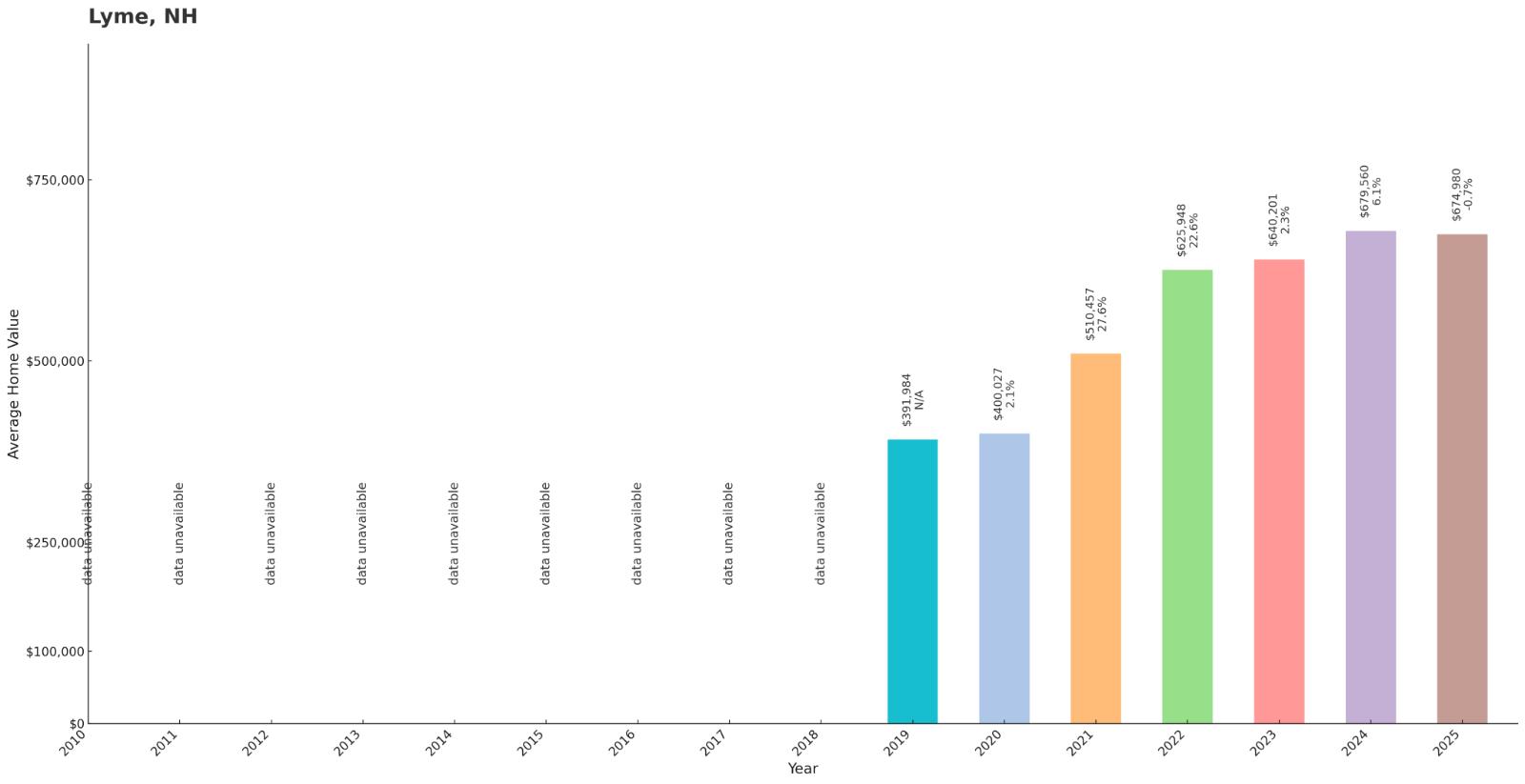
- 2010: N/A
- 2011: N/A
- 2012: N/A
- 2013: N/A
- 2014: N/A
- 2015: N/A
- 2016: N/A
- 2017: N/A
- 2018: N/A
- 2019: $391,984
- 2020: $400,027
- 2021: $510,457
- 2022: $625,948
- 2023: $640,201
- 2024: $679,560
- 2025: $674,980
Lyme demonstrates strong appreciation since 2019, increasing by 72% over six years. The town saw its biggest jump between 2020 and 2021, when values increased by over $110,000. Current median prices of $674,980 reflect the community’s appeal to buyers seeking rural Upper Valley living near Dartmouth College.
Why Lyme?
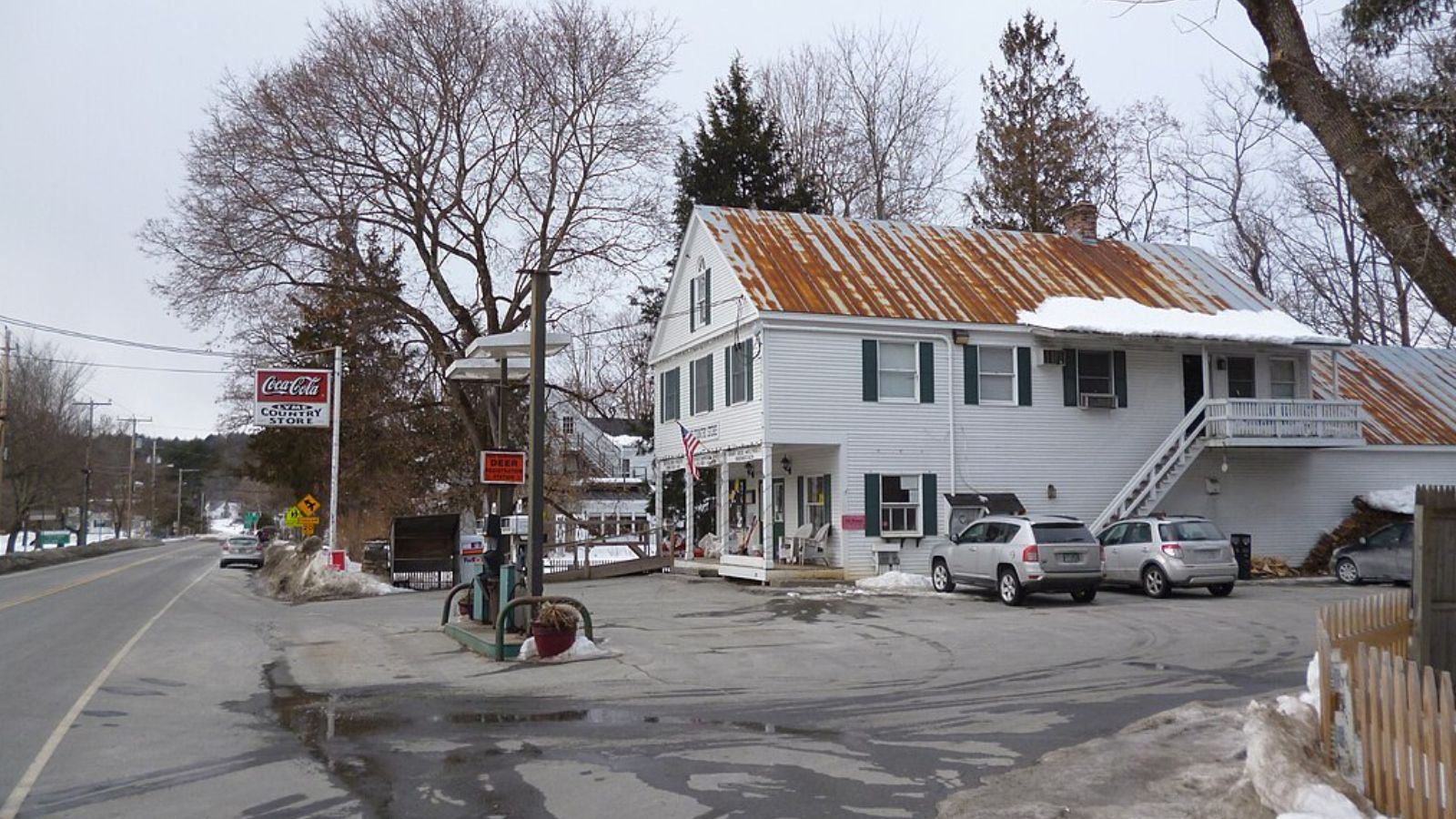
Why are people willing to pay so much to live here? What’s special about it?
Lyme offers sophisticated rural living in the Connecticut River Valley, attracting professionals, retirees, and Dartmouth College affiliates. The town provides exceptional natural beauty with rolling hills, forests, and river views that appeal to those seeking peaceful country living. High education levels and cultural awareness create an intellectually engaged community.
Residents enjoy outdoor recreation opportunities including hiking, cross-country skiing, and river activities while remaining close to Hanover’s cultural and shopping amenities. The town’s careful development and large lot requirements preserve its rural character and property values. Lyme attracts buyers who value privacy, natural beauty, and proximity to educational and cultural resources.
How Lyme Rose to Prominence
Lyme’s prominence grew from its location in the Connecticut River Valley and connection to Dartmouth College in nearby Hanover. Founded in 1761, the town developed as an agricultural community but gained prestige through its proximity to the college and the cultural influence that brought. The area attracted educated professionals and academics who appreciated both rural beauty and intellectual community.
The town’s position along the Connecticut River provided early transportation and trade opportunities, while later becoming valued for recreation and scenic beauty. Lyme maintained its rural character while attracting sophisticated residents drawn by the combination of natural setting and proximity to Dartmouth’s resources. Modern buyers continue to seek the same balance of rural tranquility and educational-cultural access.
3 Interesting Tidbits
- Historic Distinction – Lyme is home to the Lyme Hill Road Historic District, featuring well-preserved 18th and 19th-century architecture that reflects the area’s early prosperity.
- Dartmouth Connection – The town’s proximity to Dartmouth College makes it popular with professors, administrators, and alumni who want rural living near the campus.
- Conservation Focus – Lyme has preserved thousands of acres through conservation easements and land trusts, maintaining the scenic landscapes that attract high-end buyers.
25. Madbury – 134% Home Price Increase Since 2010
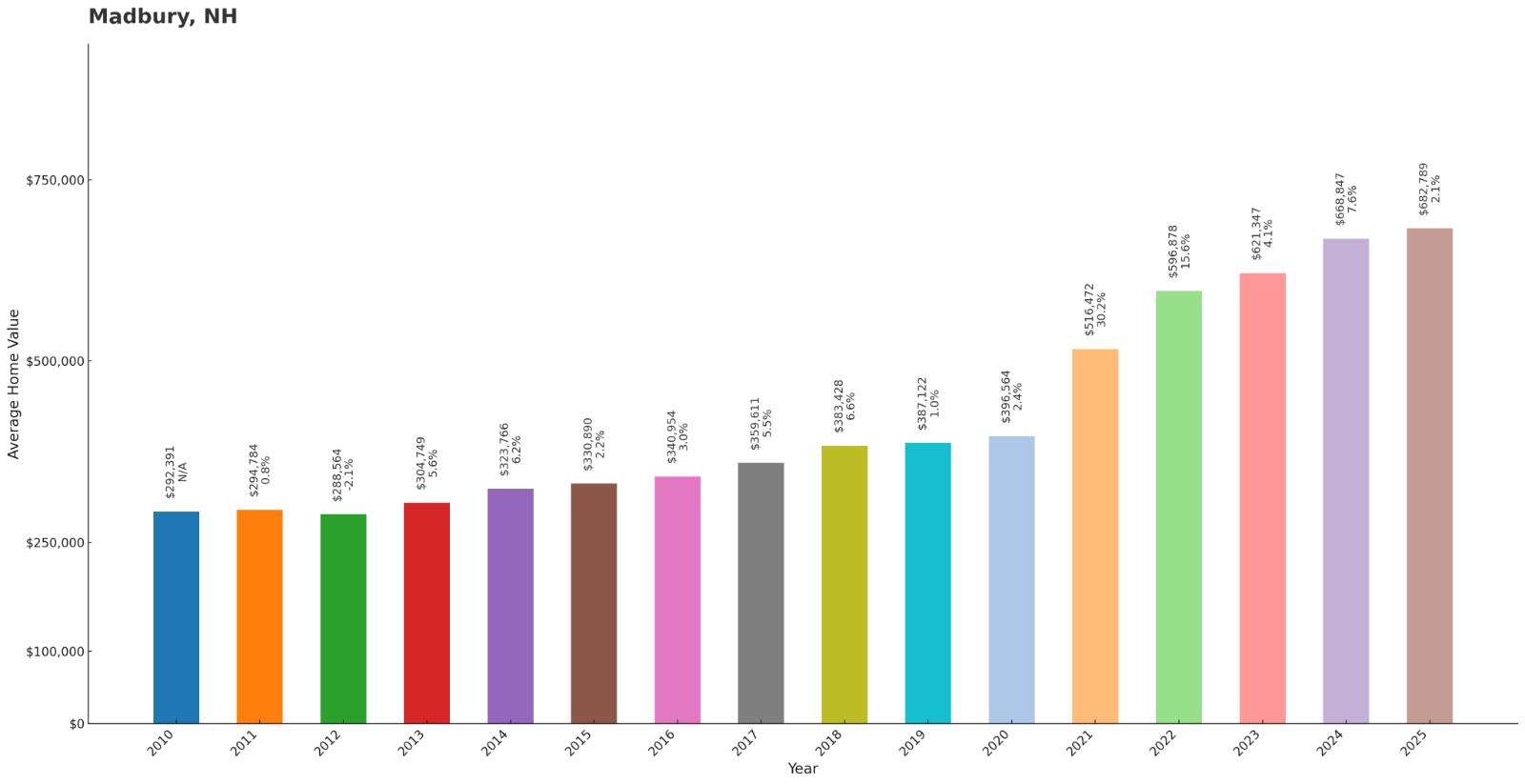
- 2010: $292,391
- 2011: $294,784
- 2012: $288,564
- 2013: $304,749
- 2014: $323,766
- 2015: $330,890
- 2016: $340,954
- 2017: $359,611
- 2018: $383,428
- 2019: $387,122
- 2020: $396,564
- 2021: $516,472
- 2022: $596,878
- 2023: $621,347
- 2024: $668,847
- 2025: $682,789
Madbury has more than doubled in value since 2010, showing consistent upward momentum. The most significant increase occurred between 2020 and 2021, when values jumped by nearly $120,000. Current median home values of $682,789 reflect strong demand for this small Seacoast community near the University of New Hampshire.
Why Madbury?
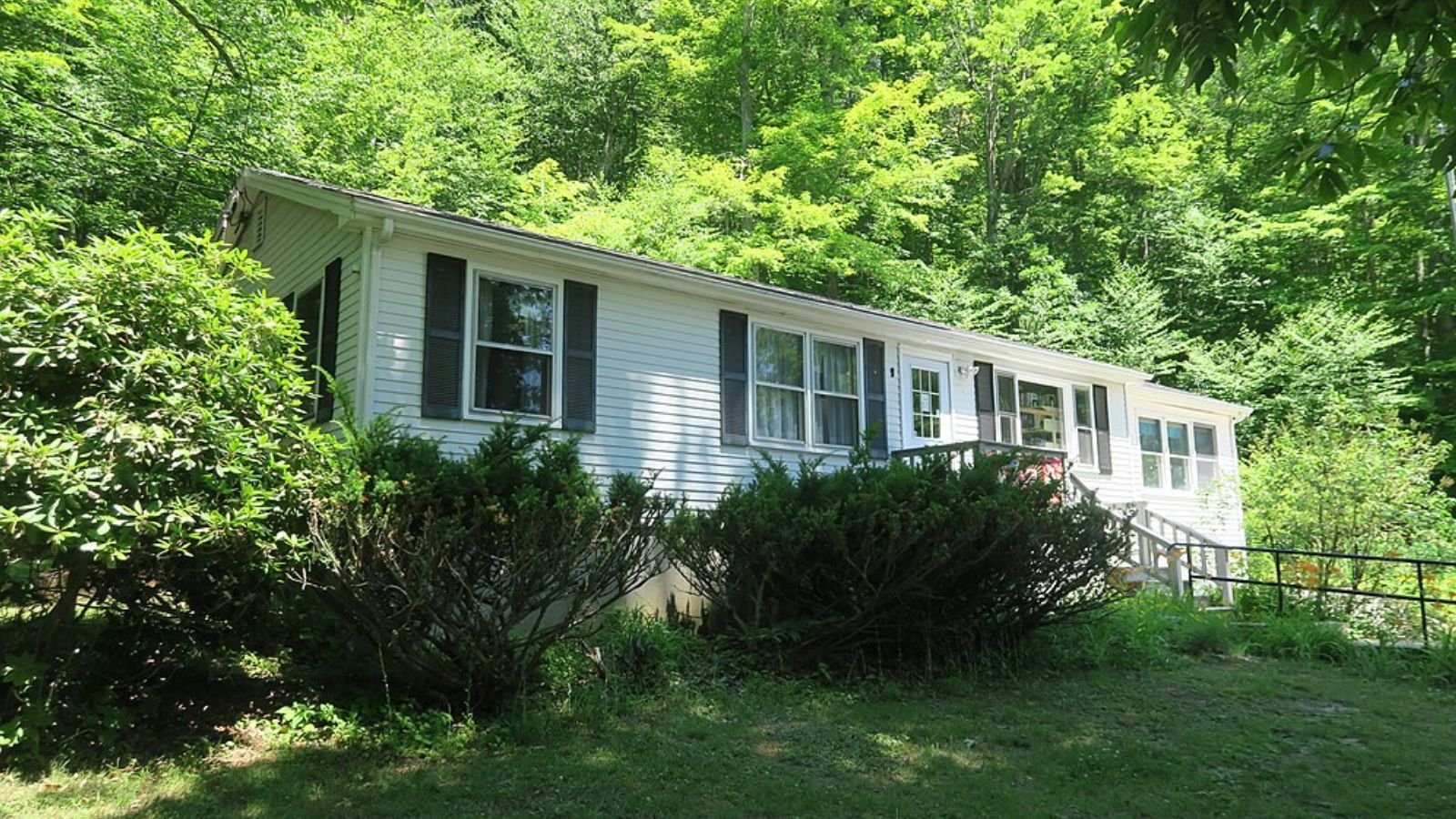
Why are people willing to pay so much to live here? What’s special about it?
Madbury provides rural tranquility within easy reach of Durham’s University of New Hampshire and Portsmouth’s employment opportunities. The small town offers large lots, wooded settings, and a strong sense of community that appeals to families and professionals. Residents enjoy low crime rates and excellent schools while remaining connected to Seacoast amenities.
The town’s strategic location provides access to both university resources and coastal recreation without the density of larger communities. Property owners benefit from the stability that comes with university proximity and the appreciation driven by limited housing inventory. Madbury attracts buyers seeking privacy and space while maintaining access to cultural and employment opportunities.
How Madbury Rose to Prominence
Madbury’s development as a desirable residential community grew from its proximity to the University of New Hampshire in Durham and the expanding Seacoast economy. Originally settled in 1735, the town remained agricultural until the 20th century when suburban growth reached the area. The university’s growth brought faculty, staff, and professionals seeking nearby housing.
The town’s rural character and large lot requirements attracted families wanting space and privacy while remaining within commuting distance of Portsmouth and other Seacoast employment centers. Careful planning helped preserve the community’s small-town atmosphere while accommodating selective growth. Madbury’s position between university and coast made it attractive to diverse buyers seeking the best of both environments.
3 Interesting Tidbits
- University Connection – Many Madbury residents work at or have connections to the University of New Hampshire, creating an educated, stable community base.
- Rural Character – Despite growth pressure, Madbury has maintained its rural atmosphere with dirt roads, stone walls, and forest preservation that appeal to buyers seeking country living.
- Small Scale – With fewer than 2,000 residents, Madbury maintains an intimate community feel where neighbors know each other and civic participation is high.
24. Sunapee – 118% Home Price Increase Since 2010
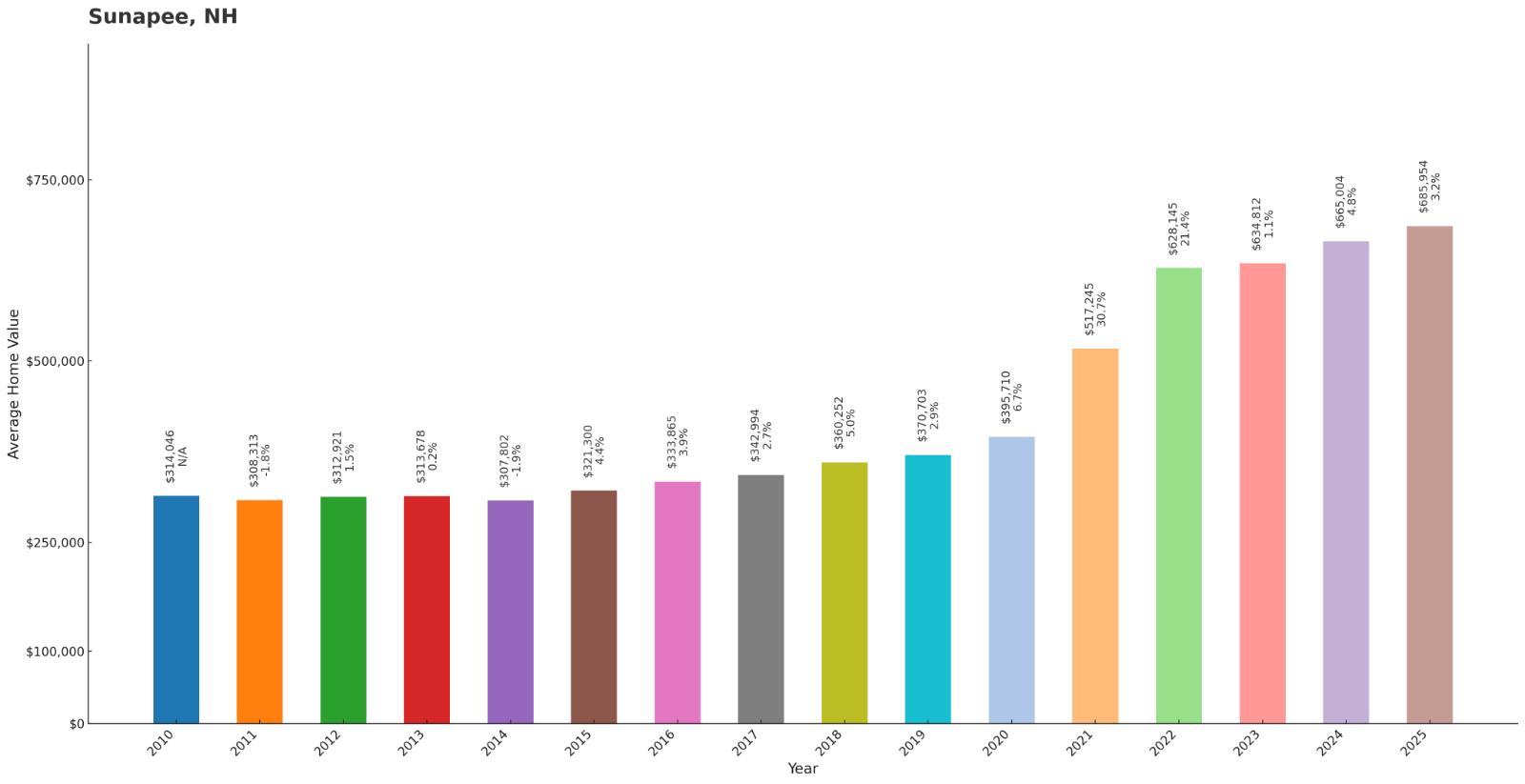
- 2010: $314,046
- 2011: $308,313
- 2012: $312,921
- 2013: $313,678
- 2014: $307,802
- 2015: $321,300
- 2016: $333,865
- 2017: $342,994
- 2018: $360,252
- 2019: $370,703
- 2020: $395,710
- 2021: $517,245
- 2022: $628,145
- 2023: $634,812
- 2024: $665,004
- 2025: $685,954
Sunapee has more than doubled since 2010, with the most dramatic growth occurring between 2020 and 2021 when values increased by over $121,000. The town experienced steady but modest growth through most of the 2010s before accelerating significantly. Current median values of $685,954 reflect the appeal of lake and mountain living in central New Hampshire.
Why Sunapee?
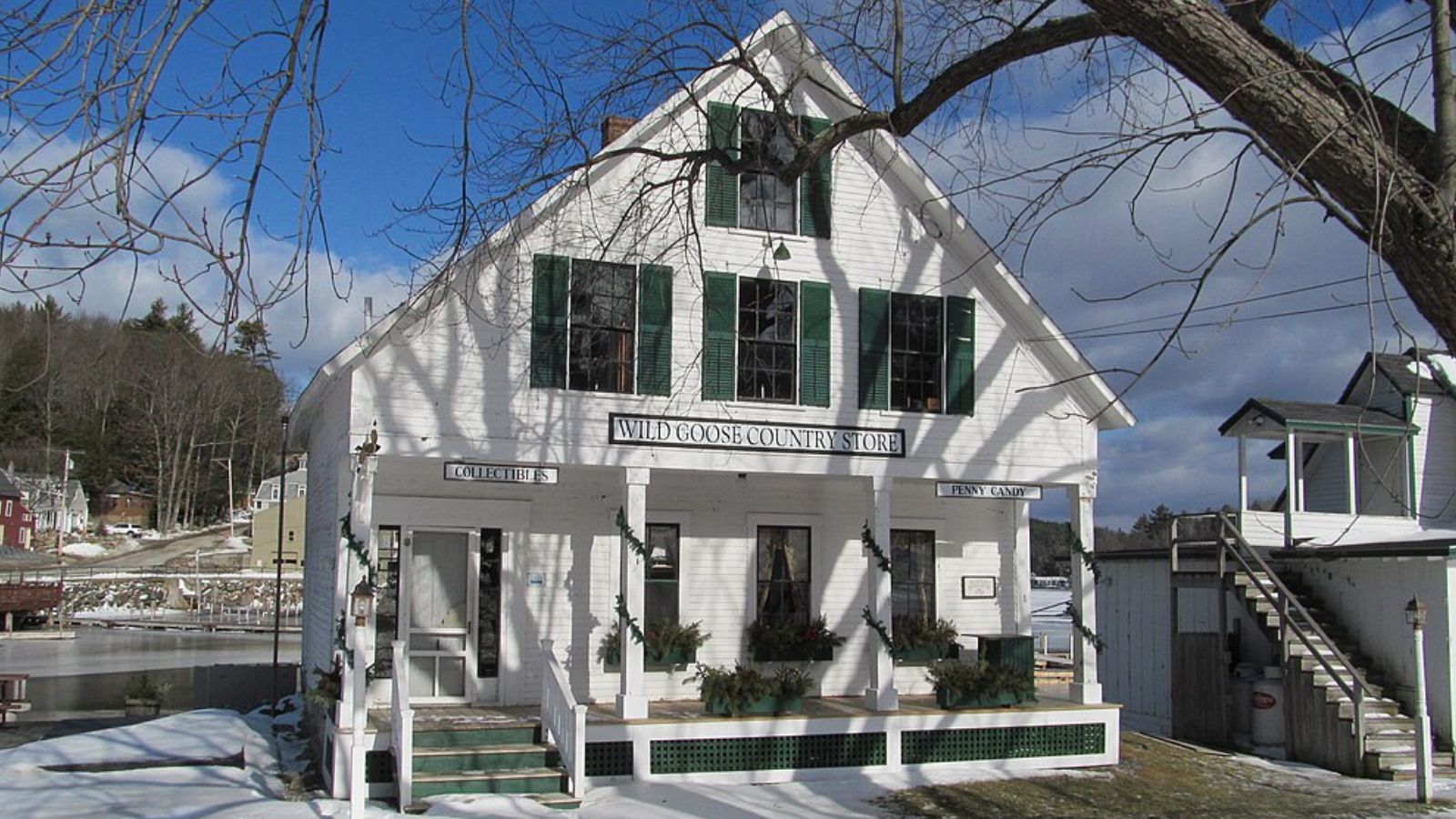
Why are people willing to pay so much to live here? What’s special about it?
Sunapee combines lake living with mountain recreation, offering year-round activities from water sports to skiing at Mount Sunapee. The town provides both natural beauty and resort amenities that attract seasonal residents and retirees seeking an active lifestyle. Lake Sunapee’s clear waters and mountain backdrop create one of New Hampshire’s most scenic settings.
The community offers upscale dining, shopping, and cultural events while maintaining small-town charm that appeals to affluent buyers. Property owners benefit from strong rental income potential during peak seasons and steady appreciation driven by limited lakefront inventory. Sunapee’s location provides easy access to both Vermont ski areas and New Hampshire’s White Mountains.
How Sunapee Rose to Prominence
Sunapee’s transformation from agricultural community to resort destination began in the late 1800s when railroads brought wealthy visitors to grand hotels along Lake Sunapee. The area became a popular summer retreat for affluent families from Boston and New York who built elaborate cottages and estates. Early tourism established the town’s reputation for natural beauty and recreational opportunities.
The development of Mount Sunapee State Park and ski area in the mid-20th century extended the tourist season and attracted winter sports enthusiasts. Modern improvements to highways made the area more accessible to urban populations seeking both seasonal retreats and year-round residences. Sunapee’s careful balance of development and conservation has preserved the natural beauty that continues to drive property values.
3 Interesting Tidbits
- Lake Quality – Lake Sunapee is one of New Hampshire’s cleanest lakes, with crystal-clear water maintained through careful environmental protection and limited development.
- Four-Season Resort – Mount Sunapee offers both winter skiing and summer activities, including chairlift rides, mountain biking, and concerts, extending the area’s appeal year-round.
- Historic Harbor – Sunapee Harbor features historic buildings and scenic beauty that have made it a popular location for weddings and special events throughout New England.
23. Pelham – 130% Home Price Increase Since 2010
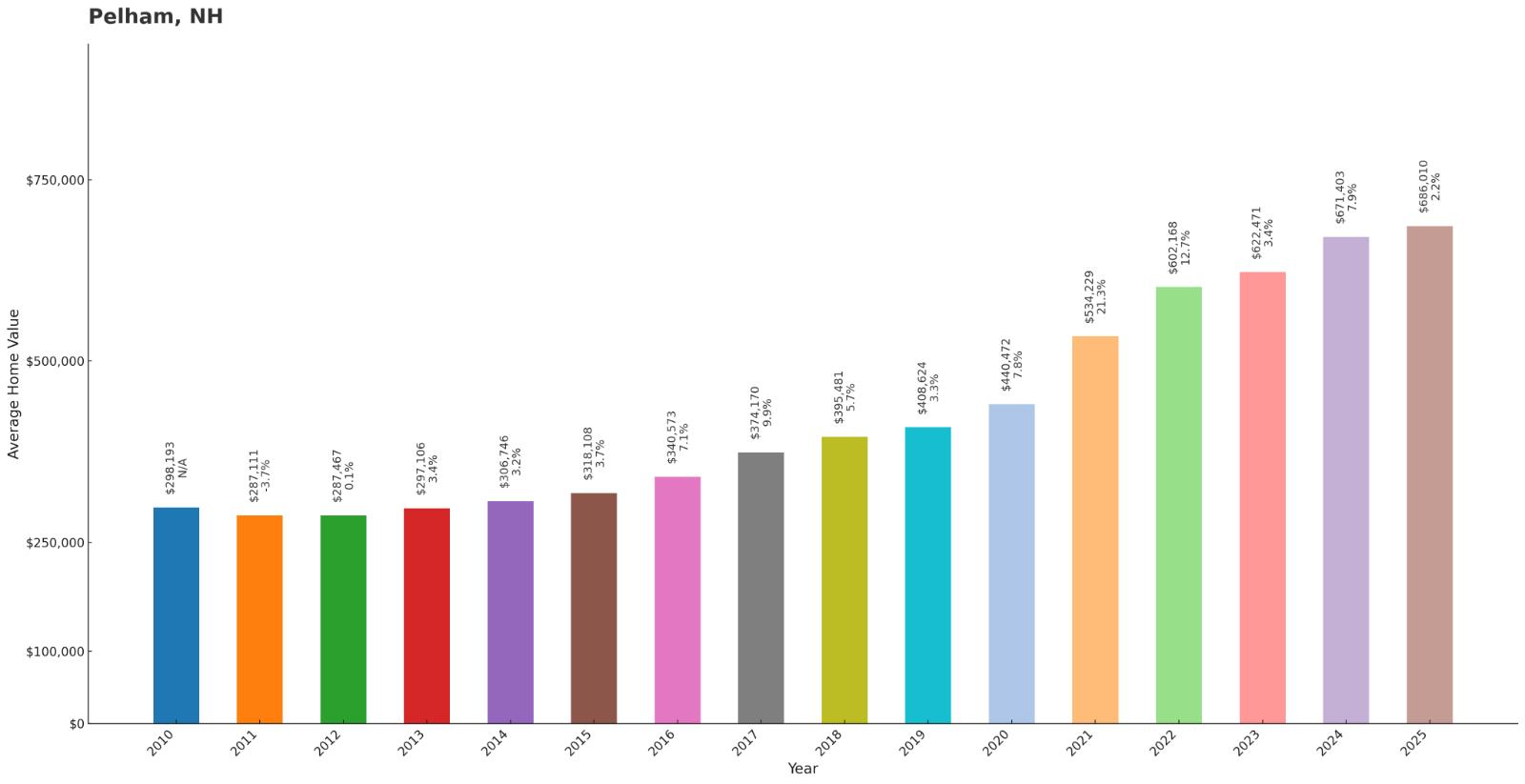
- 2010: $298,193
- 2011: $287,111
- 2012: $287,467
- 2013: $297,106
- 2014: $306,746
- 2015: $318,108
- 2016: $340,573
- 2017: $374,170
- 2018: $395,481
- 2019: $408,624
- 2020: $440,472
- 2021: $534,229
- 2022: $602,168
- 2023: $622,471
- 2024: $671,403
- 2025: $686,010
Pelham has grown steadily since recovering from an early 2010s dip, more than doubling from its 2010 starting point. The town showed consistent appreciation throughout the decade with acceleration after 2020, jumping from $440,472 to current values of $686,010. This southern New Hampshire location benefits from proximity to both Massachusetts employment and tax-free shopping.
Why Pelham?
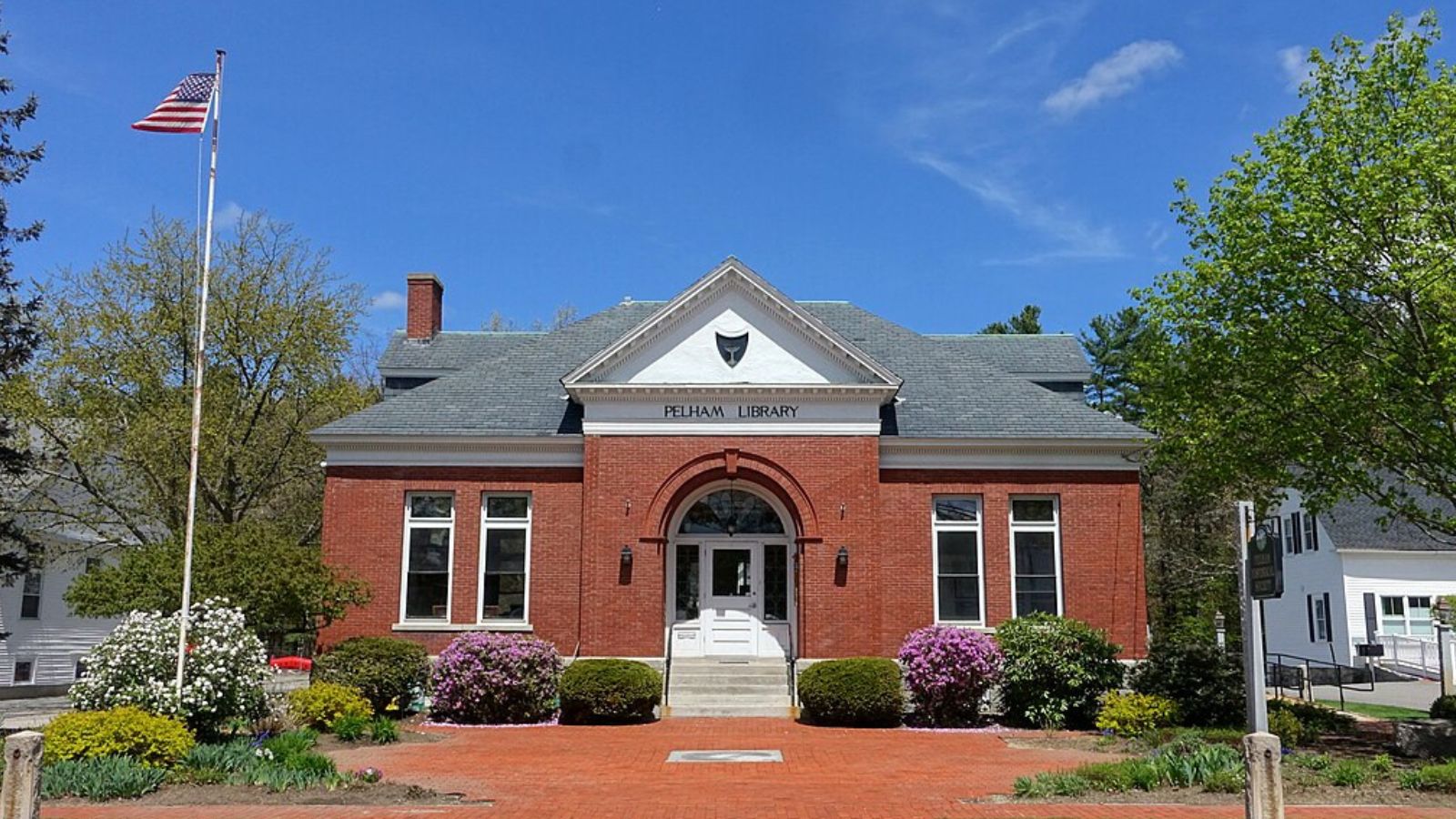
Why are people willing to pay so much to live here? What’s special about it?
Pelham offers the perfect compromise for families seeking New Hampshire’s tax benefits while maintaining access to Massachusetts employment centers. The town provides excellent schools, safe neighborhoods, and larger lots than available in more urban areas. Residents enjoy small-town atmosphere with easy access to shopping, dining, and cultural amenities in nearby Nashua and Lowell.
The community’s location along major highways makes commuting convenient while preserving rural character through careful zoning and development controls. Families appreciate the town’s strong sense of community, volunteer spirit, and recreational opportunities including conservation lands and recreational facilities. Pelham attracts buyers who want suburban amenities without sacrificing space or natural beauty.
How Pelham Rose to Prominence
Pelham’s growth accelerated in the 1960s and 70s as improved highways made commuting to Massachusetts feasible for families seeking larger properties and lower taxes. Originally settled in the 1740s as a farming community, the town remained largely rural until suburban expansion reached southern New Hampshire. The proximity to Massachusetts combined with New Hampshire’s tax advantages created strong appeal for cross-border families.
The town’s careful planning maintained rural character while accommodating growth, establishing large lot requirements and preserving open space. Pelham’s location near Salem’s tax-free shopping and easy highway access to Boston made it attractive to a wide range of buyers. The community’s commitment to excellent schools and recreational facilities strengthened its reputation as a family-friendly destination.
3 Interesting Tidbits
- Shopping Access – Pelham residents enjoy easy access to tax-free shopping at Pheasant Lane Mall and other New Hampshire retail centers while living in a rural setting.
- Conservation Success – The town has preserved hundreds of acres through conservation efforts, maintaining hiking trails and natural areas that enhance quality of life.
- Community Spirit – Pelham’s Old Home Day celebration and numerous community events reflect the strong volunteer spirit and civic engagement that characterize the town.
22. Hebron – 132% Home Price Increase Since 2010
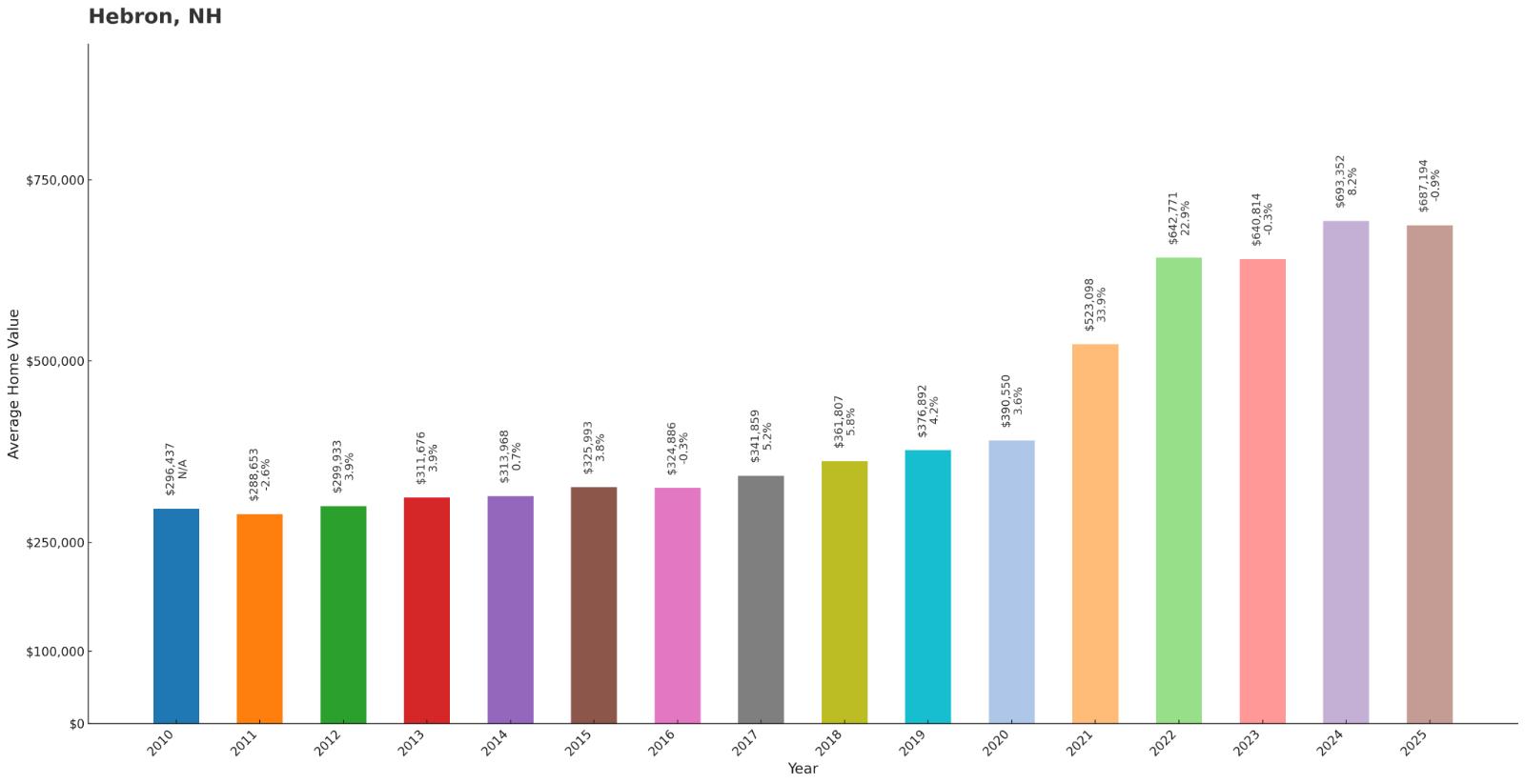
- 2010: $296,437
- 2011: $288,653
- 2012: $299,933
- 2013: $311,676
- 2014: $313,968
- 2015: $325,993
- 2016: $324,886
- 2017: $341,859
- 2018: $361,807
- 2019: $376,892
- 2020: $390,550
- 2021: $523,098
- 2022: $642,771
- 2023: $640,814
- 2024: $693,352
- 2025: $687,194
Hebron shows impressive growth of 132% since 2010, with the most dramatic increase between 2020 and 2021 when values jumped by over $132,000. The town experienced steady appreciation through the 2010s before accelerating significantly in recent years. Current median values of $687,194 reflect demand for this Lakes Region community near Newfound Lake.
Why Hebron?
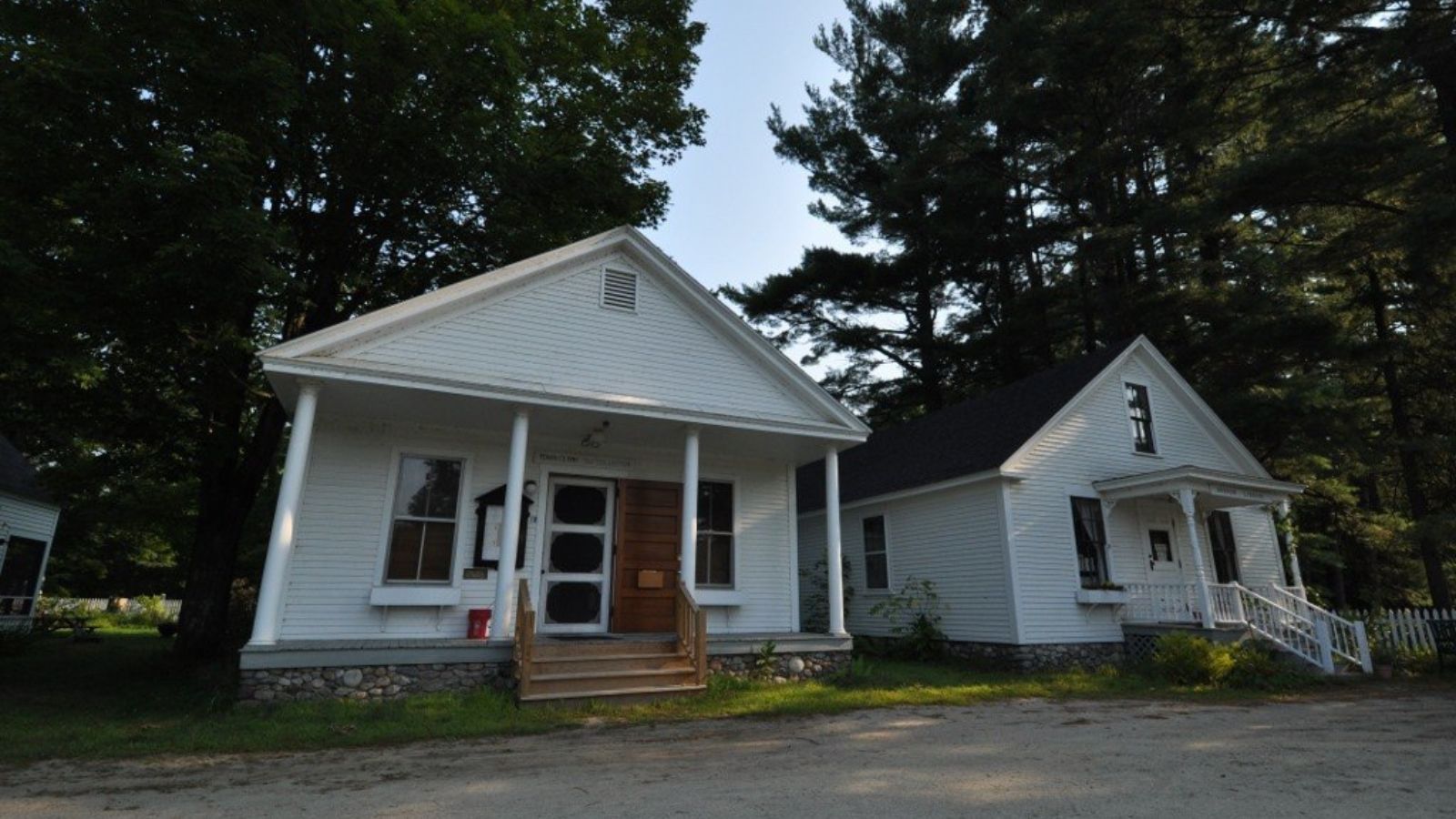
User:Magicpiano, CC BY-SA 4.0, via Wikimedia Commons
Why are people willing to pay so much to live here? What’s special about it?
Hebron provides access to pristine Newfound Lake, often called one of the cleanest lakes in the world, creating exceptional recreational opportunities and natural beauty. The town attracts families and retirees seeking a peaceful lakeside community with excellent water quality for swimming, boating, and fishing. Small-town atmosphere and low crime rates create a safe environment for raising children.
The community offers a perfect balance of natural beauty and convenience, with easy access to Plymouth for shopping and services while maintaining rural character. Property owners benefit from strong rental income potential during tourist season and steady appreciation driven by limited lake access. Hebron appeals to buyers who prioritize water recreation and natural beauty over urban amenities.
How Hebron Rose to Prominence
Hebron’s development as a desirable residential area grew from its location on Newfound Lake and the area’s reputation for exceptional water quality and natural beauty. Originally settled in 1792, the town remained agricultural until tourism and seasonal residents discovered the pristine lake environment. The lake’s crystal-clear waters and mountain views attracted visitors from urban areas seeking summer retreats.
The town’s commitment to environmental protection and careful development helped preserve the lake’s legendary water quality, enhancing its appeal to affluent buyers. Modern transportation improvements made the area more accessible while the community maintained strict environmental standards. Hebron’s position in the Lakes Region provides access to both mountain and lake recreation throughout central New Hampshire.
3 Interesting Tidbits
- Crystal Waters – Newfound Lake is renowned for having some of the purest water in the world, with visibility reaching depths of 30 feet or more.
- Sculptured Rocks – The town is home to Sculptured Rocks Natural Area, featuring spectacular granite formations carved by the Cockermouth River over thousands of years.
- Lake Heritage – Hebron Academy, a prestigious preparatory school, overlooks Newfound Lake and has been educating students in this scenic setting since 1804.
21. New London – 107% Home Price Increase Since 2010
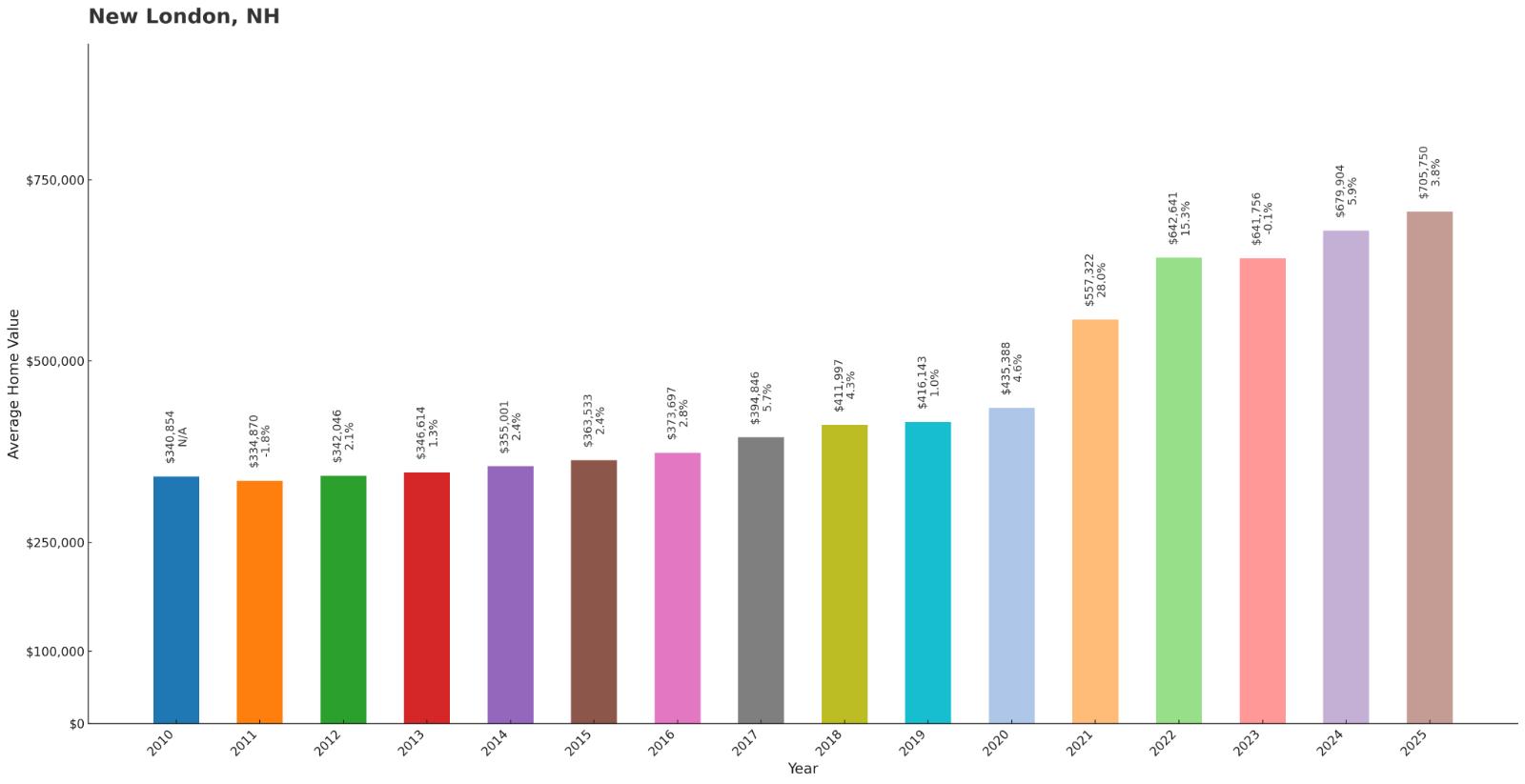
- 2010: $340,854
- 2011: $334,870
- 2012: $342,046
- 2013: $346,614
- 2014: $355,001
- 2015: $363,533
- 2016: $373,697
- 2017: $394,846
- 2018: $411,997
- 2019: $416,143
- 2020: $435,388
- 2021: $557,322
- 2022: $642,641
- 2023: $641,756
- 2024: $679,904
- 2025: $705,750
New London has doubled in value since 2010, showing steady growth with significant acceleration after 2020. The town experienced its biggest jump between 2020 and 2021, when values increased by over $121,000. Current median home values of $705,750 reflect the community’s appeal as both a college town and recreational destination.
Why New London?
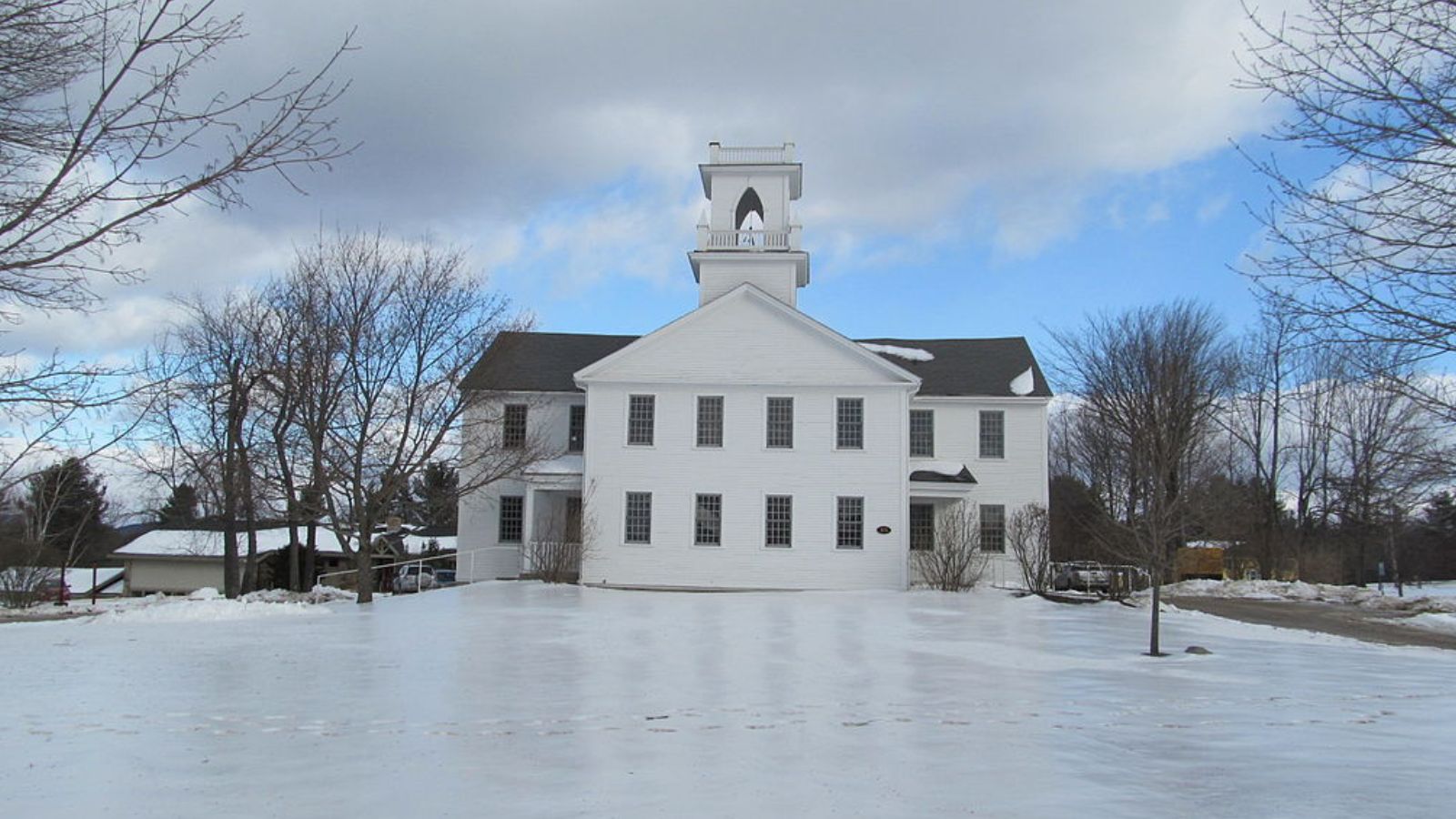
Why are people willing to pay so much to live here? What’s special about it?
New London combines the intellectual atmosphere of a college town with exceptional recreational opportunities in the Lake Sunapee region. Colby-Sawyer College provides cultural events, continuing education, and a stable economic base that appeals to retirees and professionals. The town offers sophisticated amenities while maintaining New England charm and natural beauty.
Residents enjoy year-round recreation from skiing and hiking to lake activities and cultural events that create an active, engaged community. The town’s location provides easy access to both Vermont ski areas and coastal New Hampshire while maintaining its own distinct character. Property values benefit from the stability of the college presence and limited housing inventory in this desirable region.
How New London Rose to Prominence
New London’s prominence grew from its establishment as home to Colby-Sawyer College in 1837 and its position in the scenic Lake Sunapee region. The college brought educated residents and cultural activity to what began as an agricultural community. Early railroad connections made the area accessible to visitors from Boston and other urban centers seeking mountain and lake recreation.
The town developed as both an educational center and summer resort destination, attracting seasonal residents who eventually became year-round community members. New London’s careful preservation of its historic village center while accommodating modern amenities helped maintain its appeal. The combination of college resources, natural beauty, and recreational opportunities continues to attract affluent buyers seeking an active lifestyle.
3 Interesting Tidbits
- College Connection – Colby-Sawyer College has been the heart of the community since 1837, providing cultural events, educational opportunities, and economic stability.
- Ski Heritage – New London is home to the historic Dartmouth Skiway, which has been training Olympic and collegiate ski racers for generations.
- Summer Theater – The town hosts the oldest continuously running summer theater in New Hampshire, attracting performers and audiences from throughout New England.
20. Moultonborough – 134% Home Price Increase Since 2010

- 2010: $301,113
- 2011: $294,628
- 2012: $294,812
- 2013: $291,228
- 2014: $298,623
- 2015: $305,491
- 2016: $320,933
- 2017: $341,041
- 2018: $367,993
- 2019: $395,671
- 2020: $414,177
- 2021: $557,172
- 2022: $693,925
- 2023: $688,208
- 2024: $728,259
- 2025: $705,929
Moultonborough has grown by 134% since 2010, with dramatic acceleration between 2020 and 2022 when values jumped from $414,177 to nearly $694,000. Despite some recent fluctuation, current median values of $705,929 reflect strong demand for this Lakes Region community on Lake Winnipesaukee.
Why Moultonborough?
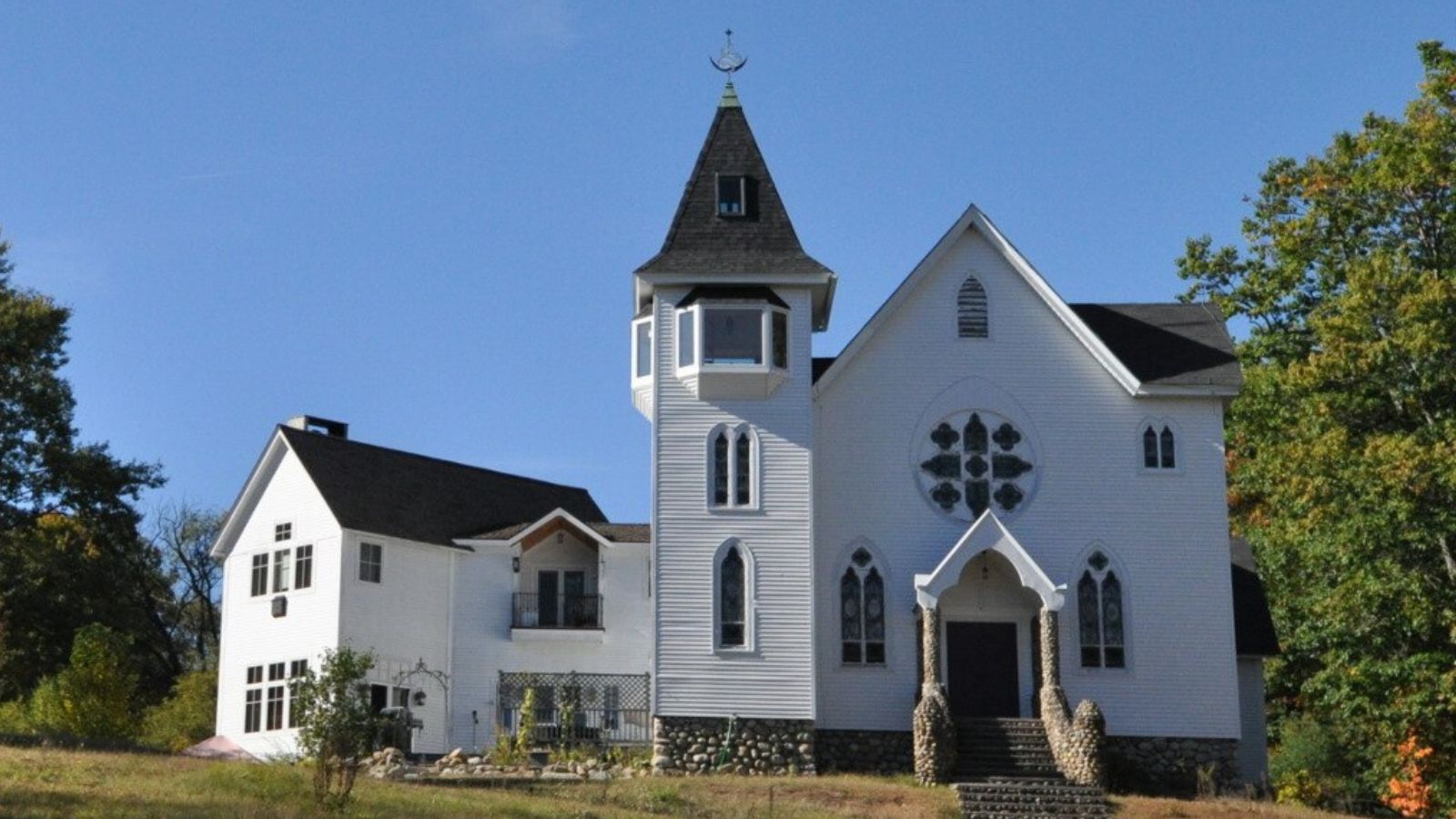
Why are people willing to pay so much to live here? What’s special about it?
Moultonborough offers extensive Lake Winnipesaukee frontage with some of the most desirable waterfront properties in New Hampshire. The town provides a perfect blend of lake recreation and mountain views that attracts affluent buyers seeking premium lakeside living. Residents enjoy boating, swimming, and fishing in New Hampshire’s largest lake while maintaining privacy and exclusivity.
The community features upscale neighborhoods, excellent town services, and easy access to regional amenities while preserving its rural character. Property owners benefit from strong appreciation and rental income potential in one of New England’s premier lake destinations. Moultonborough appeals to buyers who prioritize water access, natural beauty, and recreational lifestyle over urban convenience.
How Moultonborough Rose to Prominence
Moultonborough’s development as a premier lake community began with its extensive Lake Winnipesaukee shoreline and early tourism in the 1800s. The town attracted wealthy summer residents who built grand estates and cottages along the pristine lakefront. Railroad access brought visitors from Boston and New York, establishing the area’s reputation for natural beauty and recreation.
The town’s large size and varied topography allowed for diverse development while preserving significant natural areas and lake access. Careful zoning and planning helped maintain the community’s exclusive character while accommodating growth. Modern transportation improvements made Moultonborough accessible to urban professionals seeking lakefront retreats that eventually became year-round residences.
3 Interesting Tidbits
- Lake Dominance – Moultonborough has more Lake Winnipesaukee shoreline than any other community, offering diverse waterfront opportunities from secluded coves to open water views.
- Castle Legacy – The town is home to Castle in the Clouds, a historic mansion and estate that attracts visitors and adds to the area’s prestigious reputation.
- Island Access – Moultonborough provides access to several Lake Winnipesaukee islands, including some of the lake’s most exclusive private island properties.
19. Durham – 136% Home Price Increase Since 2010
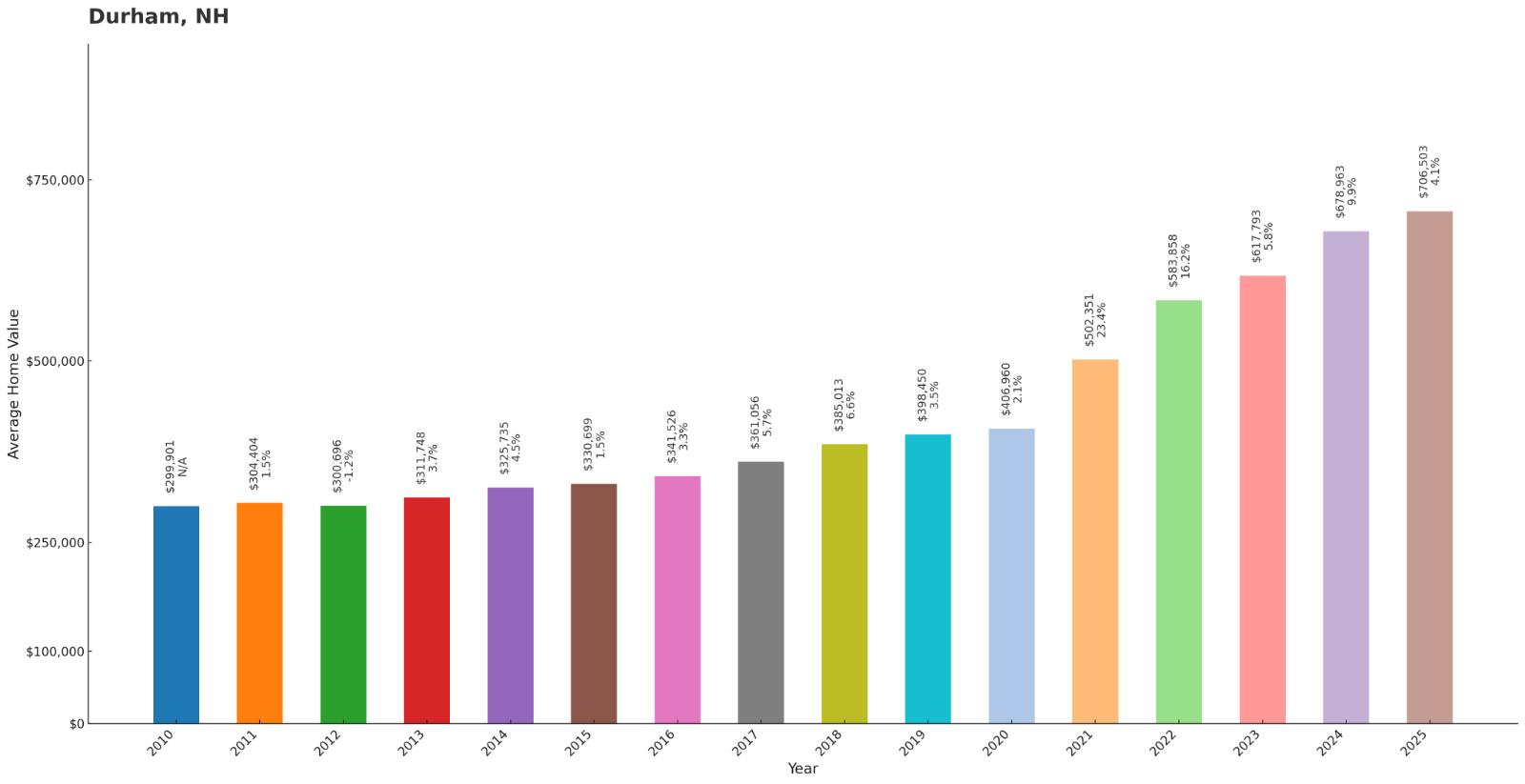
- 2010: $299,901
- 2011: $304,404
- 2012: $300,696
- 2013: $311,748
- 2014: $325,735
- 2015: $330,699
- 2016: $341,526
- 2017: $361,056
- 2018: $385,013
- 2019: $398,450
- 2020: $406,960
- 2021: $502,351
- 2022: $583,858
- 2023: $617,793
- 2024: $678,963
- 2025: $706,503
Durham has more than doubled since 2010, showing steady appreciation with significant acceleration after 2020. The town experienced consistent growth throughout the decade before jumping from $406,960 in 2020 to current values of $706,503. This Seacoast community benefits from University of New Hampshire presence and proximity to Portsmouth employment.
Why Durham?

Why are people willing to pay so much to live here? What’s special about it?
Durham combines university town sophistication with small-town charm, offering cultural events, continuing education, and intellectual community through the University of New Hampshire. The town provides excellent schools, safe neighborhoods, and easy access to both coastal recreation and employment centers. Residents enjoy the stability and amenities that come with university presence.
The community offers diverse housing options from historic downtown properties to rural estates while maintaining walkable downtown areas and extensive recreational opportunities. Property values benefit from consistent demand from university faculty, staff, and families seeking educational resources. Durham attracts buyers who value education, culture, and access to both university and coastal amenities.
How Durham Rose to Prominence
Durham’s transformation began when the University of New Hampshire relocated from Hanover in 1893, bringing educational prestige and economic stability to what was previously a rural farming community. The university’s growth throughout the 20th century attracted faculty, staff, and families who valued educational opportunities and cultural resources. The town developed as both a college community and suburban destination for Seacoast professionals.
The university’s research programs and agricultural extension services enhanced Durham’s reputation while attracting educated residents and businesses. Modern transportation improvements connected the town to Portsmouth and other employment centers while preserving its academic character. Durham’s balance of university resources, small-town atmosphere, and regional access continues to drive property demand.
3 Interesting Tidbits
- University Heart – The University of New Hampshire has been Durham’s economic and cultural center since 1893, providing stability and educational opportunities that enhance property values.
- Research Excellence – UNH’s research programs in agriculture, engineering, and marine sciences bring innovative companies and educated professionals to the area.
- Main Street Charm – Durham’s historic downtown features walkable streets, local shops, and restaurants that create authentic New England community atmosphere.
18. Center Harbor – 109% Home Price Increase Since 2010
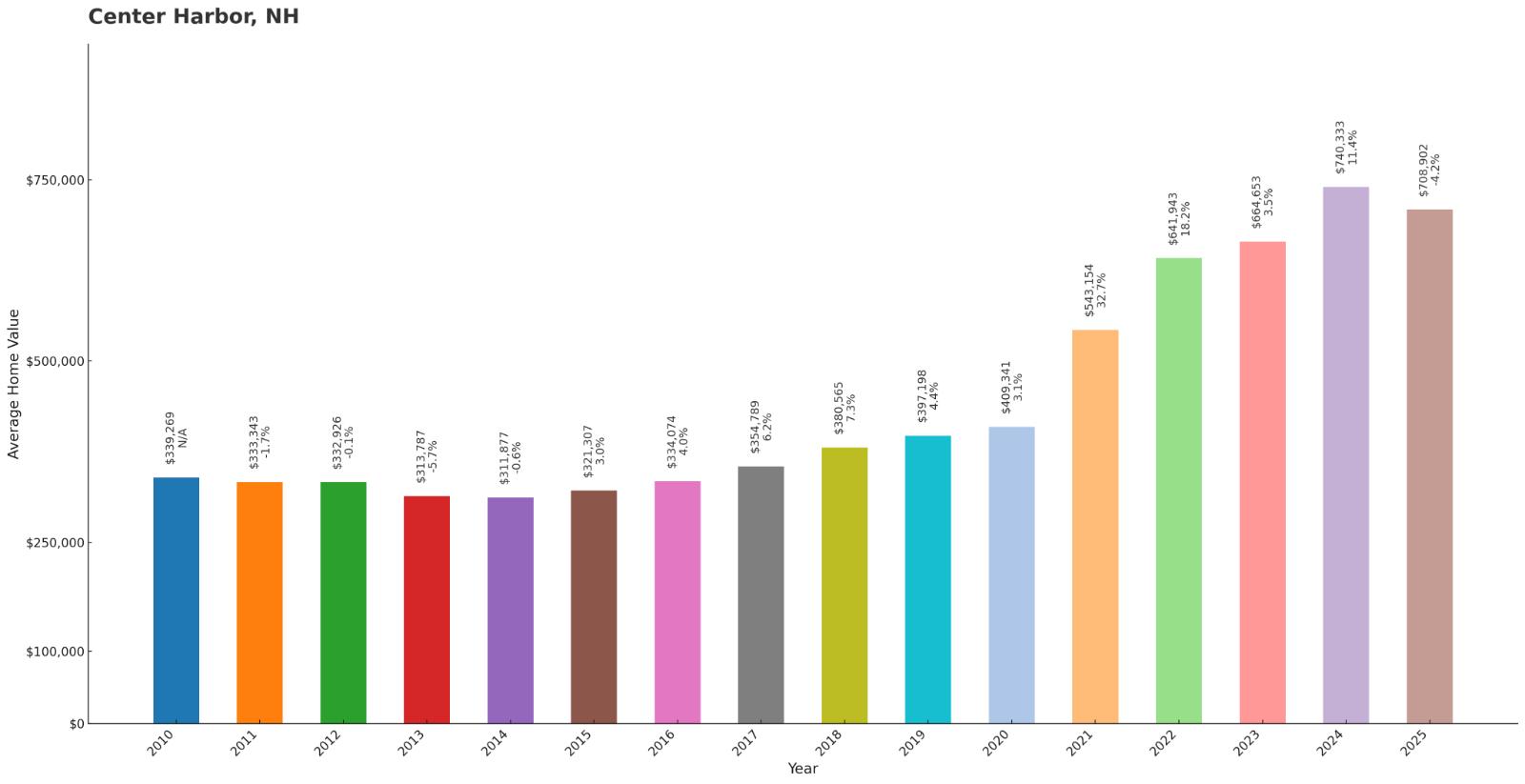
- 2010: $339,269
- 2011: $333,343
- 2012: $332,926
- 2013: $313,787
- 2014: $311,877
- 2015: $321,307
- 2016: $334,074
- 2017: $354,789
- 2018: $380,565
- 2019: $397,198
- 2020: $409,341
- 2021: $543,154
- 2022: $641,943
- 2023: $664,653
- 2024: $740,333
- 2025: $708,902
Center Harbor has more than doubled since 2010, with some volatility in the early 2010s before steady growth began around 2016. The town experienced dramatic acceleration between 2020 and 2021, jumping by over $133,000 in one year. Current median values of $708,902 reflect demand for this scenic Lakes Region location between Lake Winnipesaukee and Squam Lake.
Why Center Harbor?
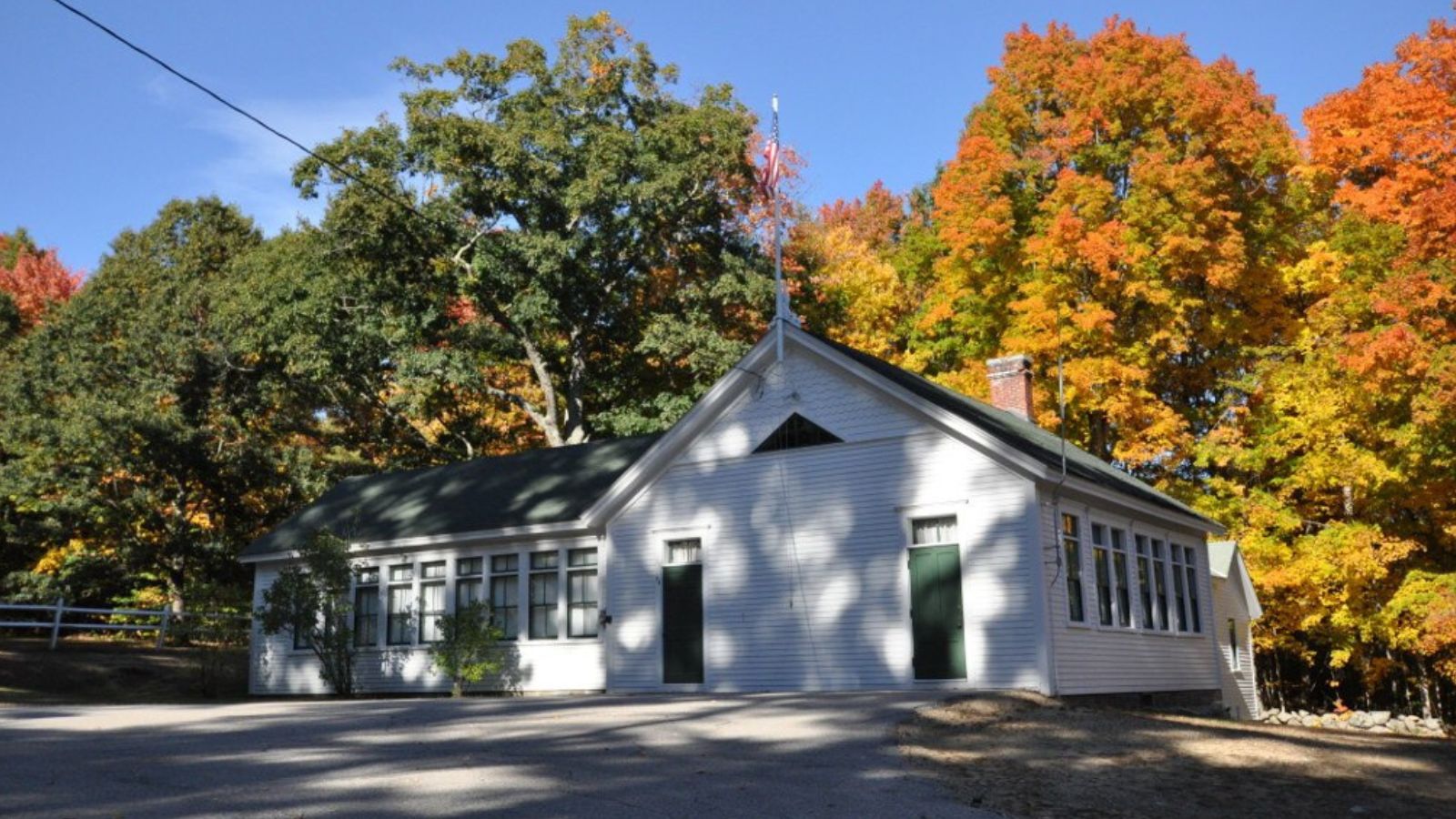
Why are people willing to pay so much to live here? What’s special about it?
Center Harbor provides access to both Lake Winnipesaukee and Squam Lake, offering unparalleled water recreation opportunities in the heart of New Hampshire’s Lakes Region. The town combines natural beauty with convenient location, providing easy access to mountain recreation and regional amenities. Residents enjoy pristine lake environments with excellent boating, fishing, and swimming opportunities.
The community maintains its small-town character while offering upscale amenities and services that appeal to affluent seasonal and year-round residents. Property values benefit from limited inventory and high demand for lake access properties in this premium location. Center Harbor attracts buyers seeking the ultimate Lakes Region lifestyle with access to multiple recreational opportunities.
How Center Harbor Rose to Prominence
Center Harbor’s prominence grew from its strategic location between New Hampshire’s two most famous lakes and its early development as a summer resort destination. The town attracted wealthy visitors in the 1800s who came by railroad and steamboat to enjoy the pristine lake environments. Grand hotels and summer cottages established the area’s reputation for luxury and natural beauty.
The town’s position at the geographical center of the Lakes Region made it a natural hub for tourism and seasonal residents. Modern transportation improvements maintained accessibility while the community preserved its historic character and natural setting. Center Harbor’s unique dual-lake access and careful development continue to attract premium buyers seeking the ultimate lake country experience.
3 Interesting Tidbits
- Dual Lake Access – Center Harbor is one of the few communities providing access to both Lake Winnipesaukee and Squam Lake, doubling recreational opportunities for residents.
- Movie Fame – The area gained national attention as a filming location for “On Golden Pond,” showcasing the natural beauty that attracts high-end buyers.
- Historic Inn – The historic Center Harbor Inn has been welcoming visitors since the 1800s, maintaining the town’s tradition of hospitality and tourism.
17. Auburn – 137% Home Price Increase Since 2010
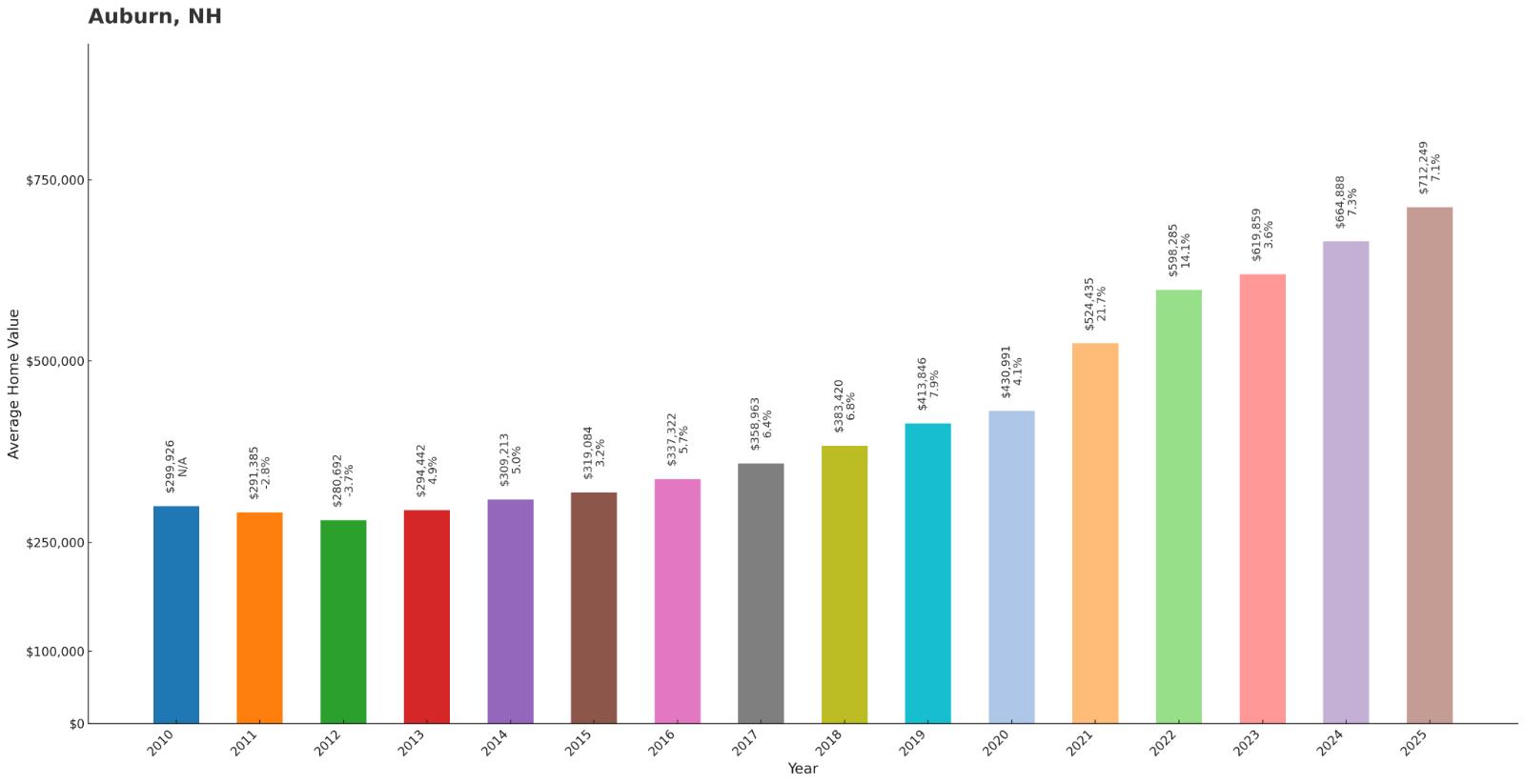
- 2010: $299,926
- 2011: $291,385
- 2012: $280,692
- 2013: $294,442
- 2014: $309,213
- 2015: $319,084
- 2016: $337,322
- 2017: $358,963
- 2018: $383,420
- 2019: $413,846
- 2020: $430,991
- 2021: $524,435
- 2022: $598,285
- 2023: $619,859
- 2024: $664,888
- 2025: $712,249
Auburn shows impressive growth of 137% since 2010, recovering from early-decade lows to show consistent appreciation. The town experienced steady growth through the 2010s with significant acceleration after 2020, jumping from $430,991 to current values of $712,249. This Manchester suburb benefits from convenient access to employment centers while maintaining rural character.
Why Auburn?
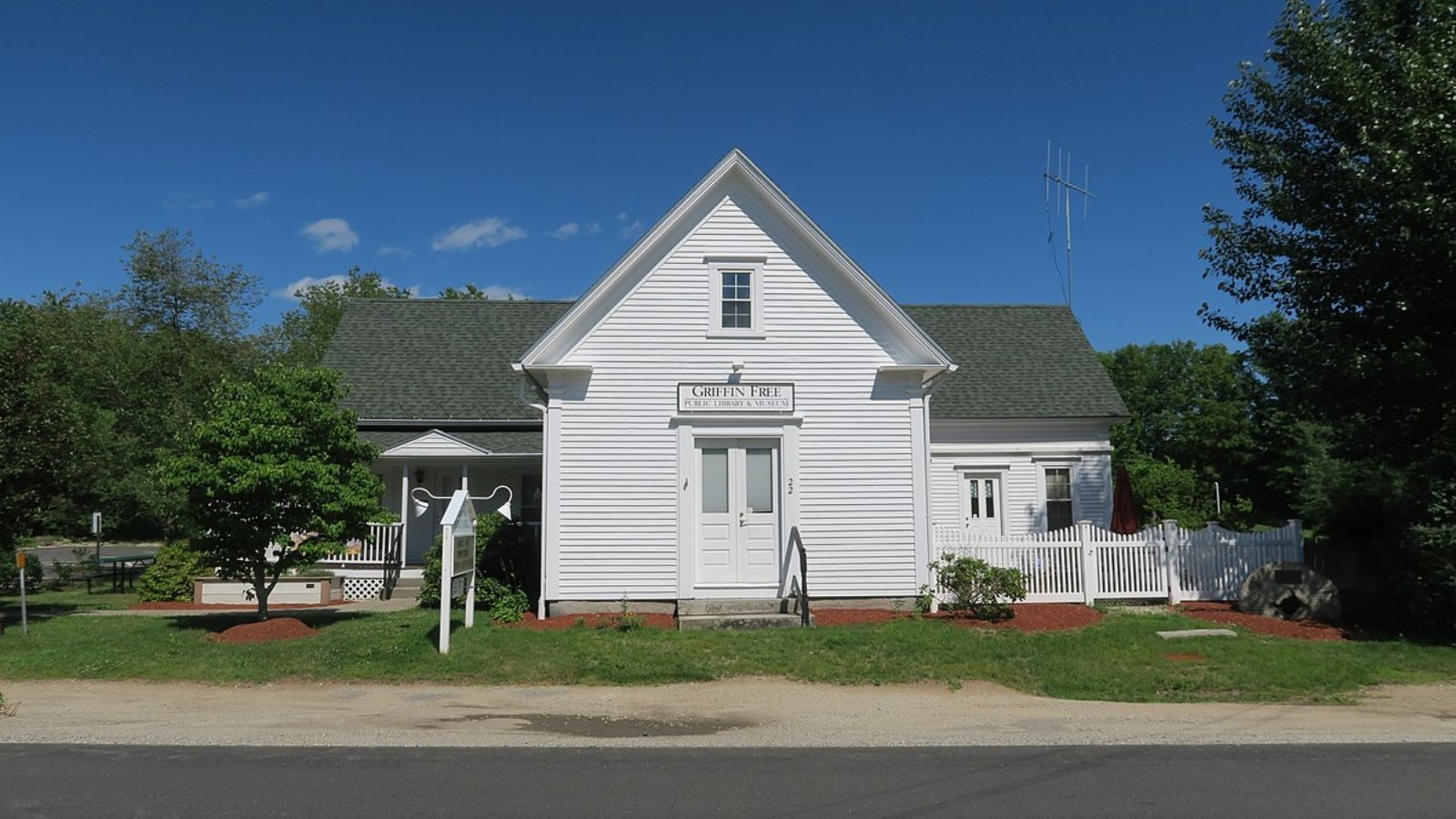
Why are people willing to pay so much to live here? What’s special about it?
Auburn provides the ideal suburban lifestyle for families seeking excellent schools, safe neighborhoods, and convenient access to Manchester employment while maintaining rural atmosphere. The town offers large lots, modern subdivisions, and strong community spirit that appeals to professionals and families. Residents enjoy low crime rates and well-maintained town services.
The community balances growth with preservation of open space and rural character, offering hiking trails and conservation areas alongside suburban amenities. Property values benefit from the town’s strategic location between Manchester and the Seacoast, providing multiple employment and recreational options. Auburn attracts buyers seeking suburban comfort with country atmosphere and regional accessibility.
How Auburn Rose to Prominence
Auburn’s development as a desirable suburban community accelerated in the 1970s and 80s as Manchester’s economy grew and families sought newer housing with larger lots. Originally an agricultural town settled in the 1700s, Auburn remained rural until suburban expansion reached the area. The town’s location provided convenient access to Manchester employment while offering space and privacy.
Careful planning and zoning helped Auburn accommodate growth while preserving its rural character and natural beauty. The construction of major highways improved access to employment centers throughout southern New Hampshire and Massachusetts. Auburn’s commitment to excellent schools and community services established its reputation as a premier family destination.
3 Interesting Tidbits
- School Excellence – Auburn Village School consistently ranks among New Hampshire’s top elementary schools, attracting families throughout the region.
- Conservation Success – The town has preserved hundreds of acres through conservation efforts, maintaining hiking trails and natural areas that enhance quality of life.
- Community Events – Auburn’s Old Home Day and other community celebrations reflect the strong civic engagement and small-town atmosphere that residents value.
16. Brentwood – 101% Home Price Increase Since 2010
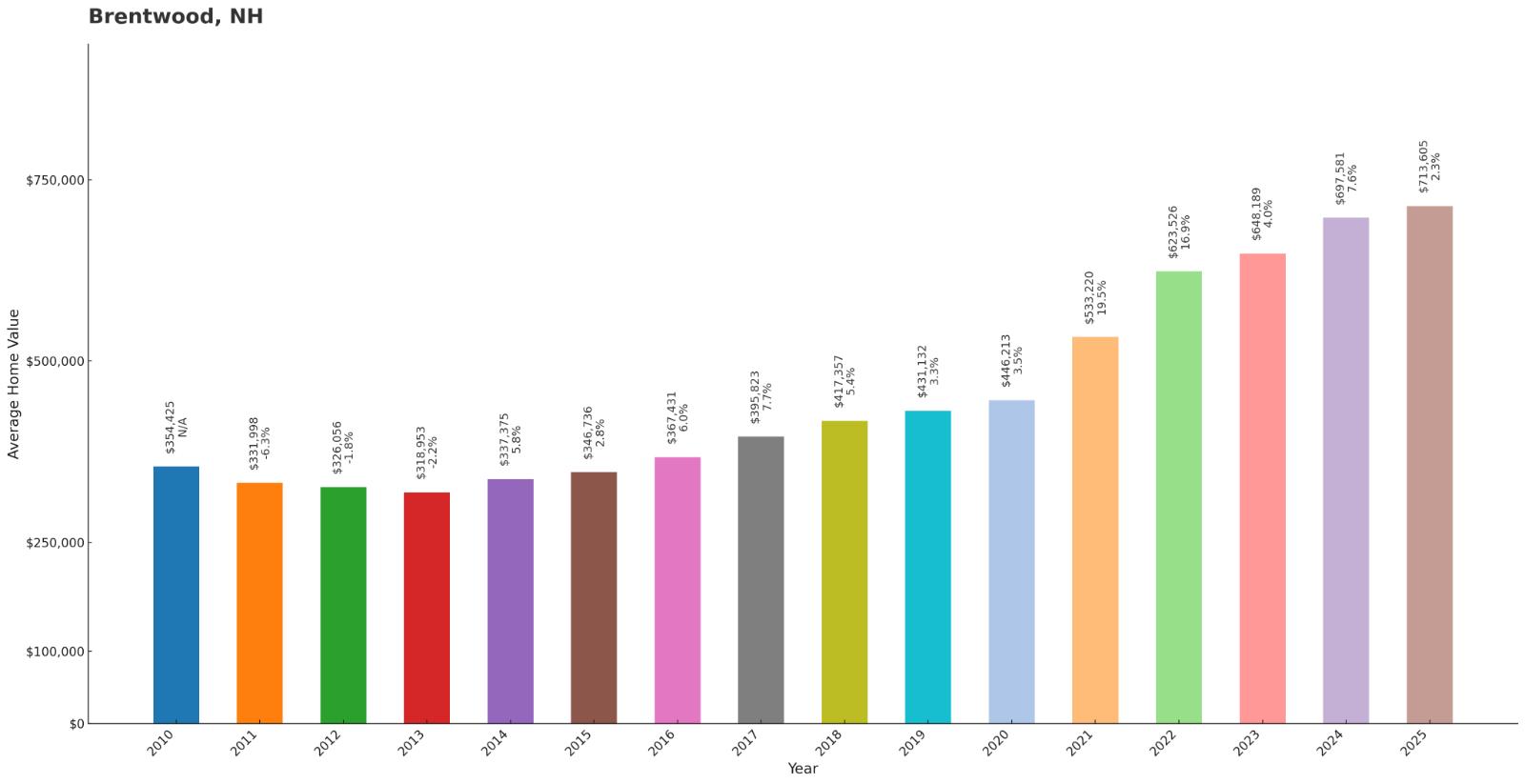
- 2010: $354,425
- 2011: $331,998
- 2012: $326,056
- 2013: $318,953
- 2014: $337,375
- 2015: $346,736
- 2016: $367,431
- 2017: $395,823
- 2018: $417,357
- 2019: $431,132
- 2020: $446,213
- 2021: $533,220
- 2022: $623,526
- 2023: $648,189
- 2024: $697,581
- 2025: $713,605
Brentwood has doubled since 2010, recovering from early-decade declines to show strong appreciation in recent years. The town experienced steady growth from 2014 onward with significant acceleration after 2020. Current median values of $713,605 reflect demand for this Seacoast community offering rural living with convenient access to Portsmouth and Boston areas.
Why Brentwood?
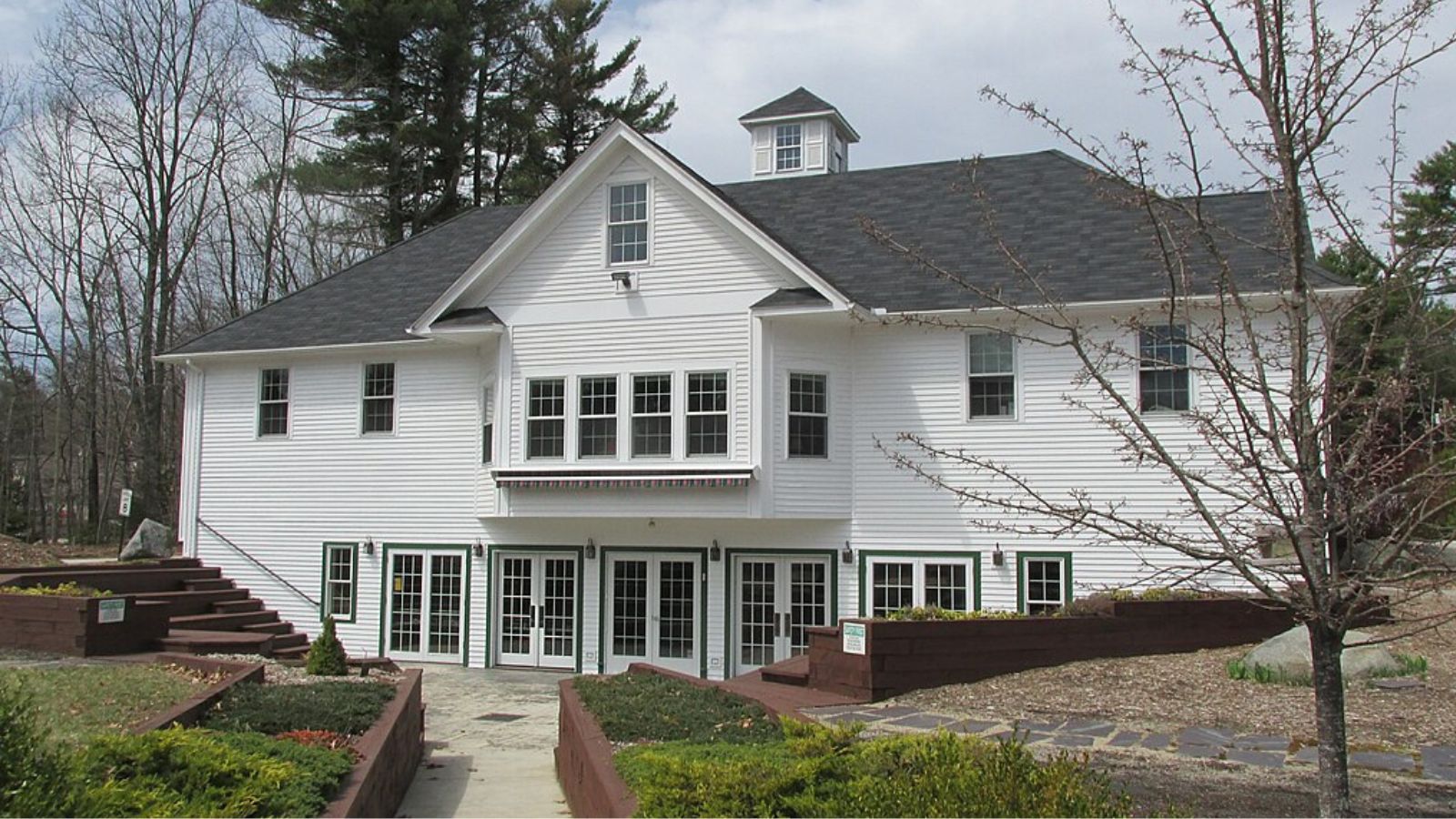
Why are people willing to pay so much to live here? What’s special about it?
Brentwood offers rural tranquility with convenient access to Seacoast employment and recreational opportunities, making it ideal for professionals seeking space and privacy. The town provides excellent schools, low crime rates, and strong community engagement that appeals to families. Residents enjoy large lots, wooded settings, and conservation areas while remaining connected to urban amenities.
The community maintains its agricultural heritage and small-town atmosphere while accommodating selective growth and modern conveniences. Property values benefit from the town’s strategic location providing access to Portsmouth, coastal recreation, and Boston-area employment. Brentwood attracts buyers who prioritize space, nature, and community while maintaining career flexibility.
How Brentwood Rose to Prominence
Brentwood’s transformation from agricultural community to desirable suburban destination began with improved transportation connections to the Seacoast and Boston areas. Originally settled in the 1740s, the town remained rural until the latter half of the 20th century when suburban growth reached the area. The town’s large size and varied landscape attracted families seeking privacy and space.
Careful planning helped Brentwood accommodate growth while preserving its rural character and agricultural heritage. The town’s commitment to conservation and large lot requirements maintained the open space and natural beauty that attract affluent buyers. Brentwood’s position between urban opportunities and rural lifestyle continues to drive demand from diverse buyers.
3 Interesting Tidbits
- Agricultural Heritage – Brentwood maintains active farms and agricultural traditions, including a popular farmers market and community supported agriculture programs.
- Conservation Leadership – The town has preserved thousands of acres through conservation easements and land protection efforts, maintaining its rural character.
- Historic Charm – Brentwood’s historic town center and 18th-century architecture provide authentic New England character that enhances property values.
15. Stratham – 138% Home Price Increase Since 2010
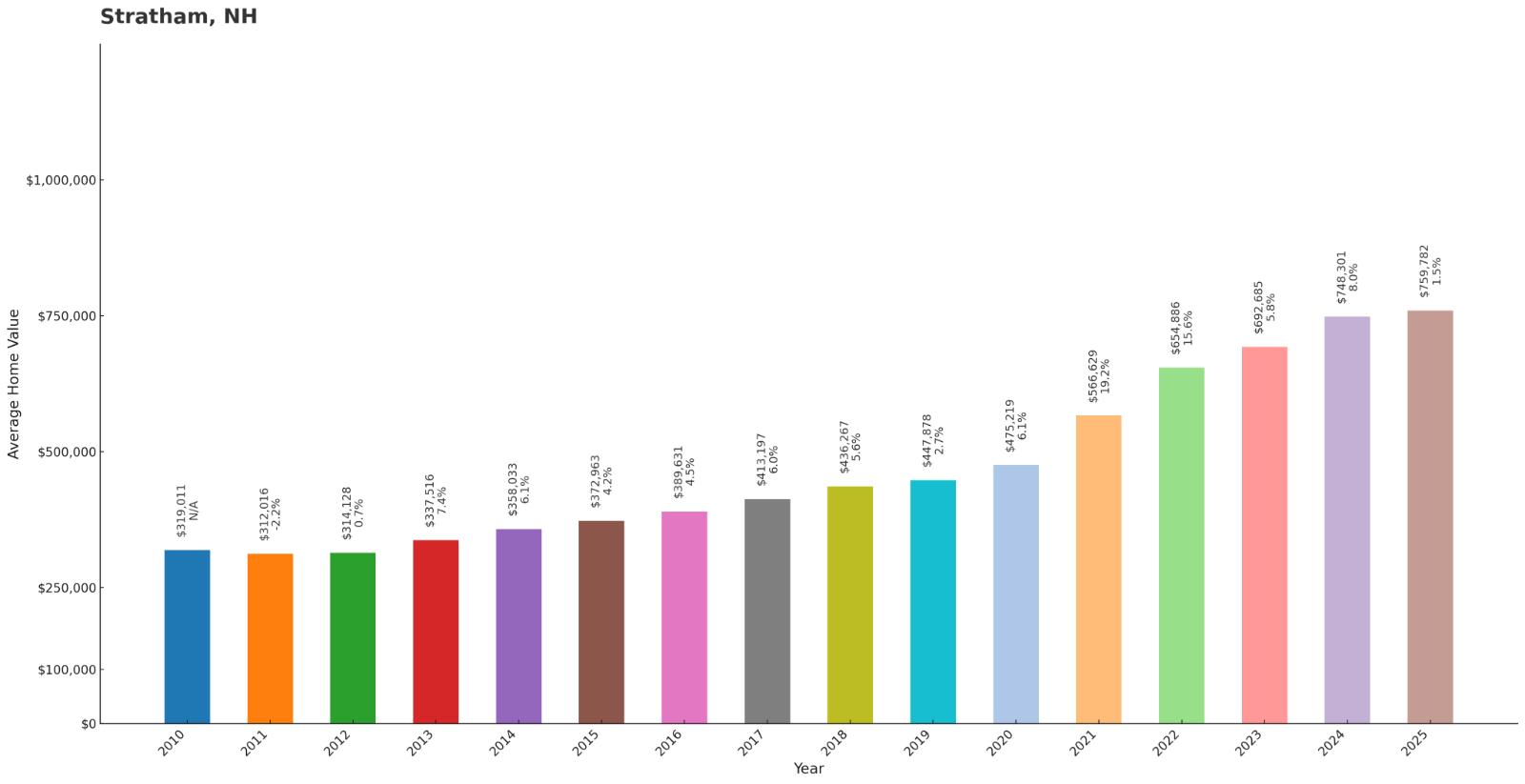
- 2010: $319,011
- 2011: $312,016
- 2012: $314,128
- 2013: $337,516
- 2014: $358,033
- 2015: $372,963
- 2016: $389,631
- 2017: $413,197
- 2018: $436,267
- 2019: $447,878
- 2020: $475,219
- 2021: $566,629
- 2022: $654,886
- 2023: $692,685
- 2024: $748,301
- 2025: $759,782
Stratham has grown by 138% since 2010, showing consistent upward movement with significant acceleration in recent years. The town demonstrated steady appreciation throughout the decade with dramatic growth after 2020, reaching current median values of $759,782. This Seacoast location combines rural charm with access to Portsmouth and Boston employment markets.
Why Stratham?
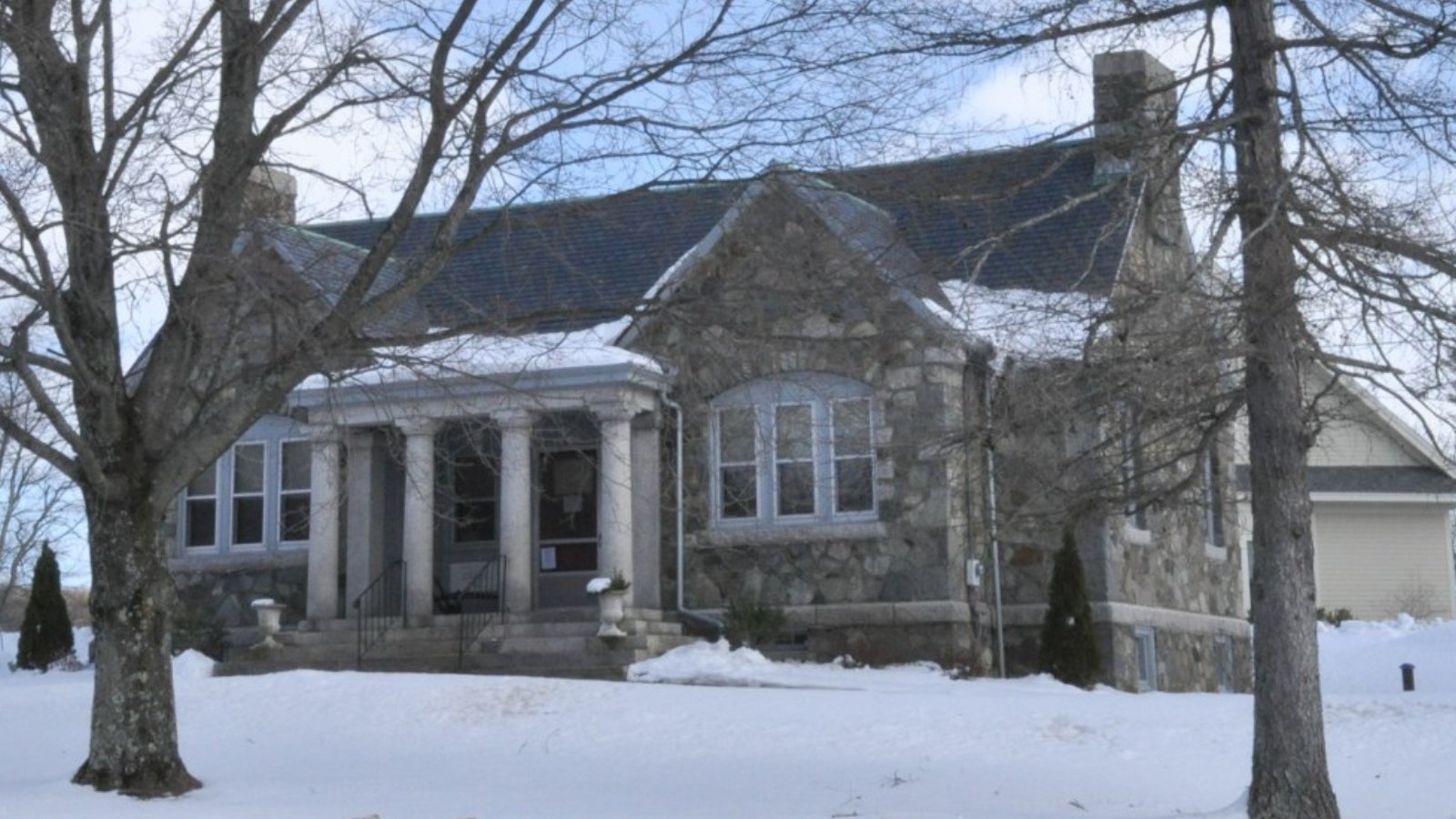
Why are people willing to pay so much to live here? What’s special about it?
Stratham provides the perfect balance of rural New Hampshire living with easy access to Seacoast employment and cultural opportunities. The town offers excellent schools, safe neighborhoods, and large properties that appeal to affluent families and professionals. Residents enjoy the benefits of small-town community while remaining connected to Portsmouth amenities and employment.
The community features well-preserved historic areas, conservation lands, and modern subdivisions that create diverse housing options while maintaining character. Property values benefit from the town’s strategic location providing access to both New Hampshire’s coast and Boston-area employment. Stratham attracts buyers seeking space, education quality, and convenient access to multiple employment and recreational centers.
How Stratham Rose to Prominence
Stratham’s development as a premier residential community grew from its location between Portsmouth and Exeter and its early settlement as an agricultural town in the 1600s. The town attracted wealthy merchants and sea captains who built grand homes that still contribute to the community’s historic character. Early prosperity from farming and timber provided the foundation for careful community development.
Modern transportation improvements made Stratham accessible to Portsmouth employment while preserving its rural atmosphere and historic charm. The town’s commitment to education, conservation, and careful growth planning attracted families throughout the region. Stratham’s balance of history, natural beauty, and convenience continues to drive demand from affluent buyers.
3 Interesting Tidbits
- Historic Wealth – Stratham’s historic district features grand 18th and 19th-century homes built by sea captains and merchants, reflecting the area’s early prosperity.
- Agricultural Preservation – The town maintains active farms and has preserved significant agricultural land, including the famous Tendercrop Farm known for its sweet corn.
- Strategic Location – Stratham’s position between major Seacoast employment centers makes it ideal for professionals seeking rural living with urban access.
14. Bedford – 112% Home Price Increase Since 2010
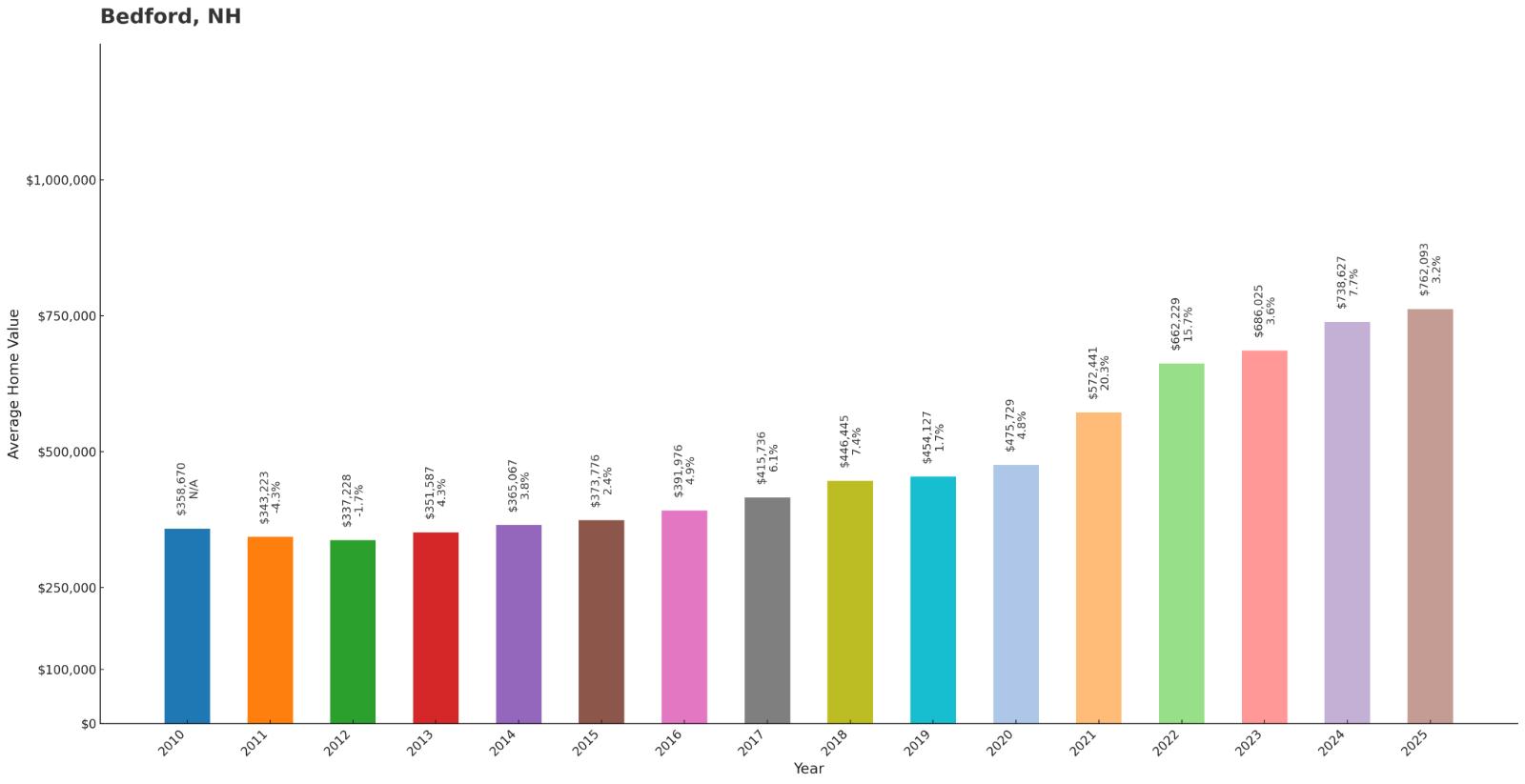
- 2010: $358,670
- 2011: $343,223
- 2012: $337,228
- 2013: $351,587
- 2014: $365,067
- 2015: $373,776
- 2016: $391,976
- 2017: $415,736
- 2018: $446,445
- 2019: $454,127
- 2020: $475,729
- 2021: $572,441
- 2022: $662,229
- 2023: $686,025
- 2024: $738,627
- 2025: $762,093
Bedford has more than doubled since 2010, showing consistent growth with acceleration in recent years. The town recovered from early-decade declines to demonstrate steady appreciation, with significant growth after 2020 bringing values to $762,093. This Manchester suburb has long been recognized as one of New Hampshire’s premier residential communities.
Why Bedford?
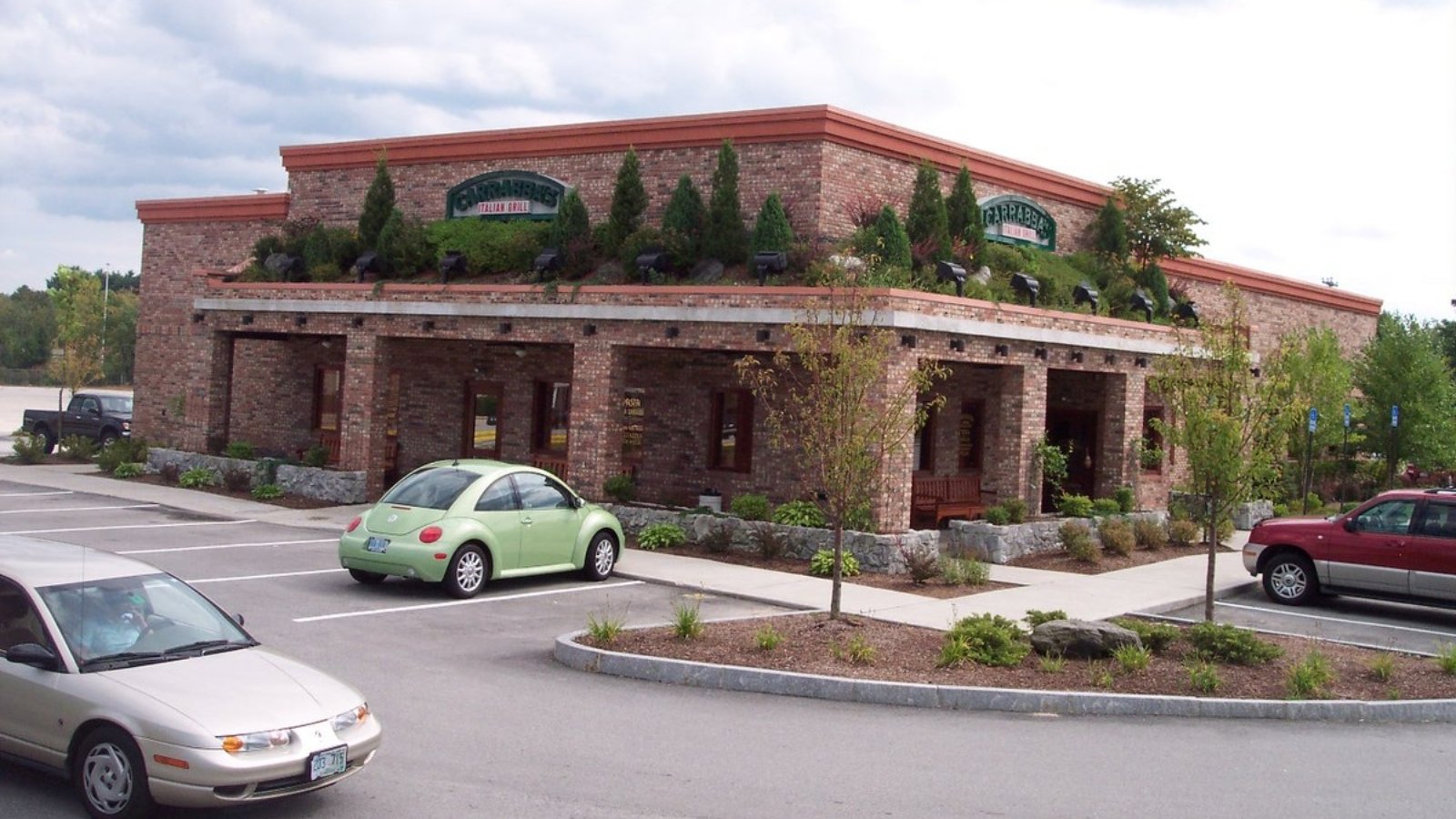
Why are people willing to pay so much to live here? What’s special about it?
Bedford represents the pinnacle of New Hampshire suburban living, offering excellent schools, upscale neighborhoods, and convenient access to Manchester and Boston employment centers. The town provides low crime rates, well-maintained infrastructure, and strong community services that appeal to affluent families and professionals. Residents enjoy the benefits of careful planning and quality development standards.
The community features diverse housing options from historic properties to luxury developments while maintaining its reputation for educational excellence and safety. Property values benefit from Bedford’s established reputation as a premium residential destination and its strategic location. The town attracts buyers who prioritize education, safety, and convenience while seeking suburban lifestyle with urban access.
How Bedford Rose to Prominence
Bedford’s reputation as a premier residential community began with its transformation from agricultural town to upscale suburb during Manchester’s economic growth in the mid-20th century. The town’s location south of Manchester provided convenient access to employment while offering space for large lots and quality development. Early suburban growth attracted professionals and business leaders who established high standards for community development.
The town’s commitment to excellent schools and careful planning created a reputation that attracted affluent families throughout the region. Bedford’s balance of historic preservation and modern development helped maintain character while accommodating growth. The community’s continued focus on quality education and municipal services has sustained its position as one of New Hampshire’s most desirable places to live.
3 Interesting Tidbits
- Educational Excellence – Bedford’s schools consistently rank among New Hampshire’s best, with McKelvie Middle School and Memorial Elementary receiving national recognition.
- Historic Preservation – The town has carefully preserved its historic village center while developing modern neighborhoods that maintain community character.
- Business Hub – Bedford is home to numerous corporate headquarters and professional services, creating local employment opportunities that enhance property values.
13. South Hampton – 65% Home Price Increase Since 2019
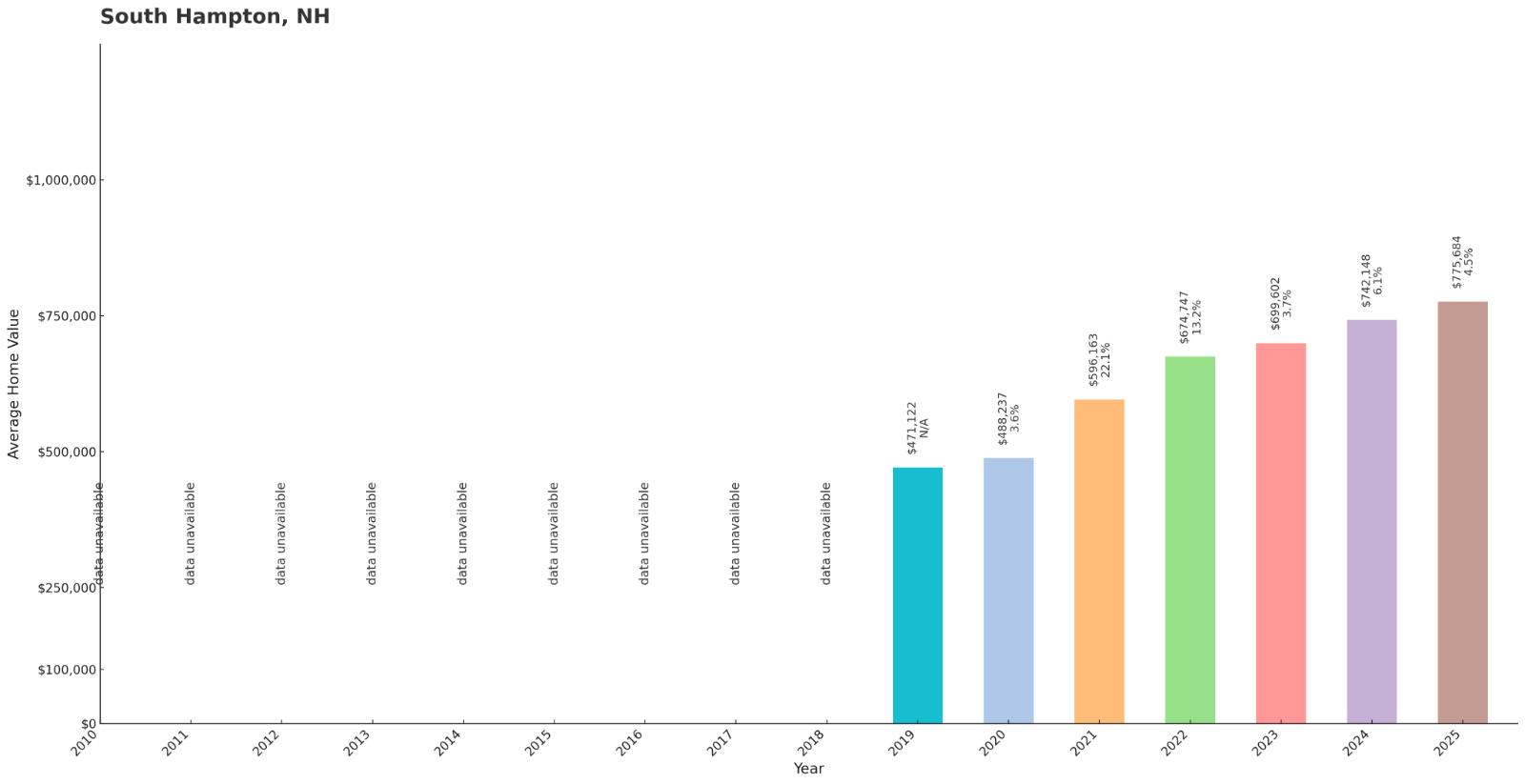
- 2010: N/A
- 2011: N/A
- 2012: N/A
- 2013: N/A
- 2014: N/A
- 2015: N/A
- 2016: N/A
- 2017: N/A
- 2018: N/A
- 2019: $471,122
- 2020: $488,237
- 2021: $596,163
- 2022: $674,747
- 2023: $699,602
- 2024: $742,148
- 2025: $775,684
South Hampton has grown by 65% since 2019, showing strong appreciation in a relatively short timeframe. The town experienced steady growth from its 2019 baseline with significant jumps between 2020-2021 and continued appreciation to current values of $775,684. This small Seacoast community benefits from proximity to Massachusetts employment while maintaining rural New Hampshire character.
Why South Hampton?
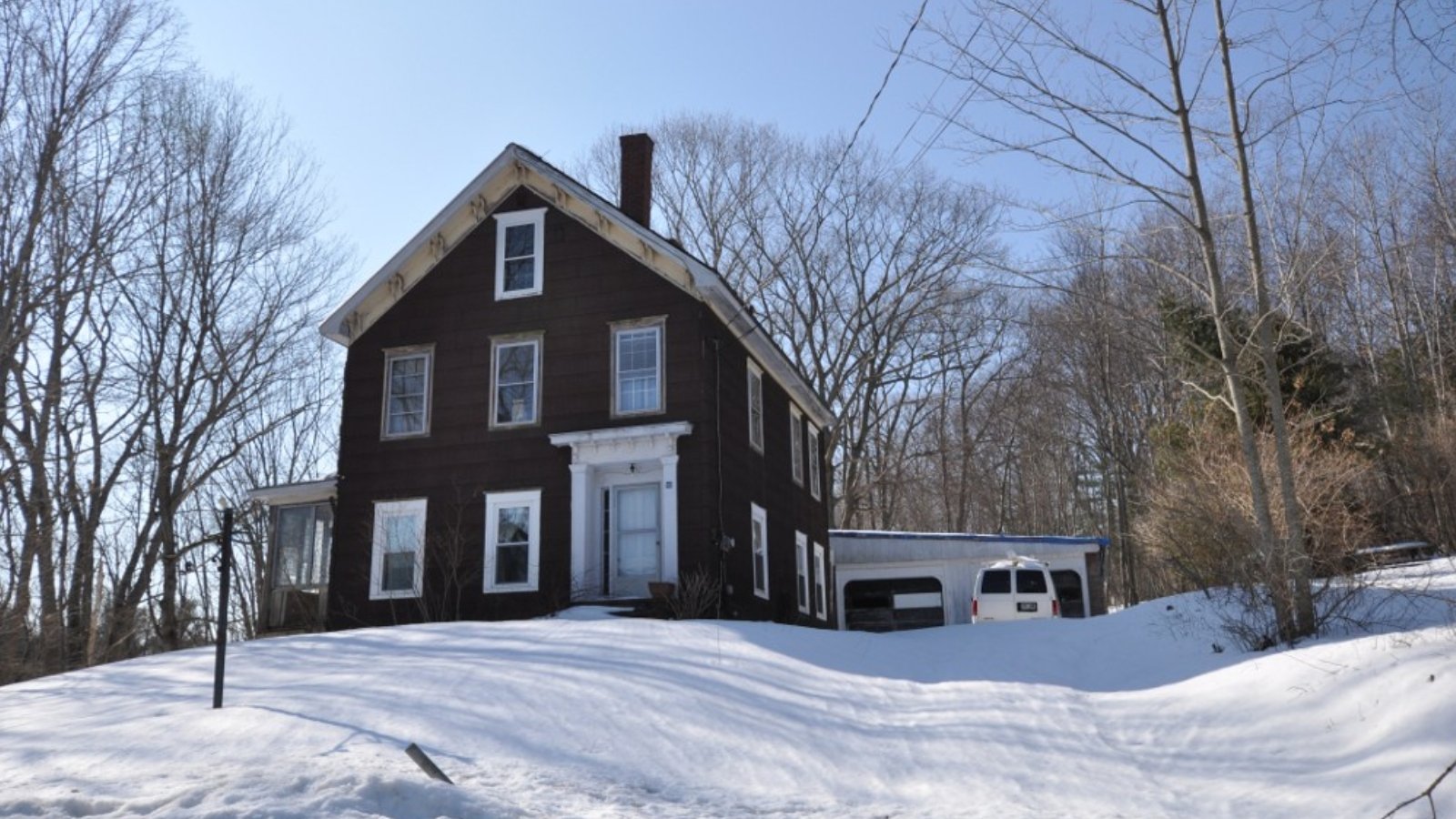
Why are people willing to pay so much to live here? What’s special about it?
South Hampton offers rural tranquility with convenient access to both New Hampshire Seacoast and Massachusetts employment opportunities. The small town provides large lots, conservation areas, and low population density that appeals to buyers seeking privacy and space. Residents enjoy the benefits of New Hampshire’s tax advantages while maintaining reasonable commuting distances to major job markets.
The community maintains its agricultural character and small-town atmosphere while providing modern conveniences and services. Property values benefit from limited inventory and high demand from Massachusetts residents seeking larger properties and lower taxes. South Hampton attracts buyers who prioritize space, privacy, and rural lifestyle while maintaining career flexibility.
How South Hampton Rose to Prominence
South Hampton’s development as a desirable residential area grew from its strategic location near the Massachusetts border and its preservation of rural character. Originally settled in the 1740s, the town remained agricultural until recent decades when improved transportation made cross-border commuting feasible. The area attracted families seeking larger properties and lower taxes than available in Massachusetts.
The town’s commitment to preserving its rural character through large lot requirements and conservation efforts helped maintain the natural beauty that attracts affluent buyers. South Hampton’s small size and limited development opportunities created scarcity that drives property values. The community’s balance of privacy, natural beauty, and accessibility continues to attract diverse buyers.
3 Interesting Tidbits
- Small Scale – With fewer than 1,000 residents, South Hampton maintains an intimate community atmosphere where neighbors know each other and civic participation is high.
- Conservation Focus – The town has preserved significant portions of its landscape through conservation efforts, maintaining the rural character that attracts buyers.
- Border Benefits – South Hampton’s location near Massachusetts provides access to employment and amenities while offering New Hampshire’s favorable tax environment.
12. Portsmouth – 132% Home Price Increase Since 2010

- 2010: $333,905
- 2011: $329,746
- 2012: $313,133
- 2013: $330,827
- 2014: $356,866
- 2015: $381,602
- 2016: $406,405
- 2017: $444,940
- 2018: $487,853
- 2019: $493,065
- 2020: $511,154
- 2021: $595,581
- 2022: $676,021
- 2023: $712,193
- 2024: $761,609
- 2025: $776,239
Portsmouth has grown by 132% since 2010, showing consistent appreciation with significant acceleration in recent years. The historic seaport recovered from early-decade declines to demonstrate steady growth, with dramatic increases after 2020 bringing values to $776,239. This coastal city combines maritime heritage with modern amenities and employment opportunities.
Why Portsmouth?
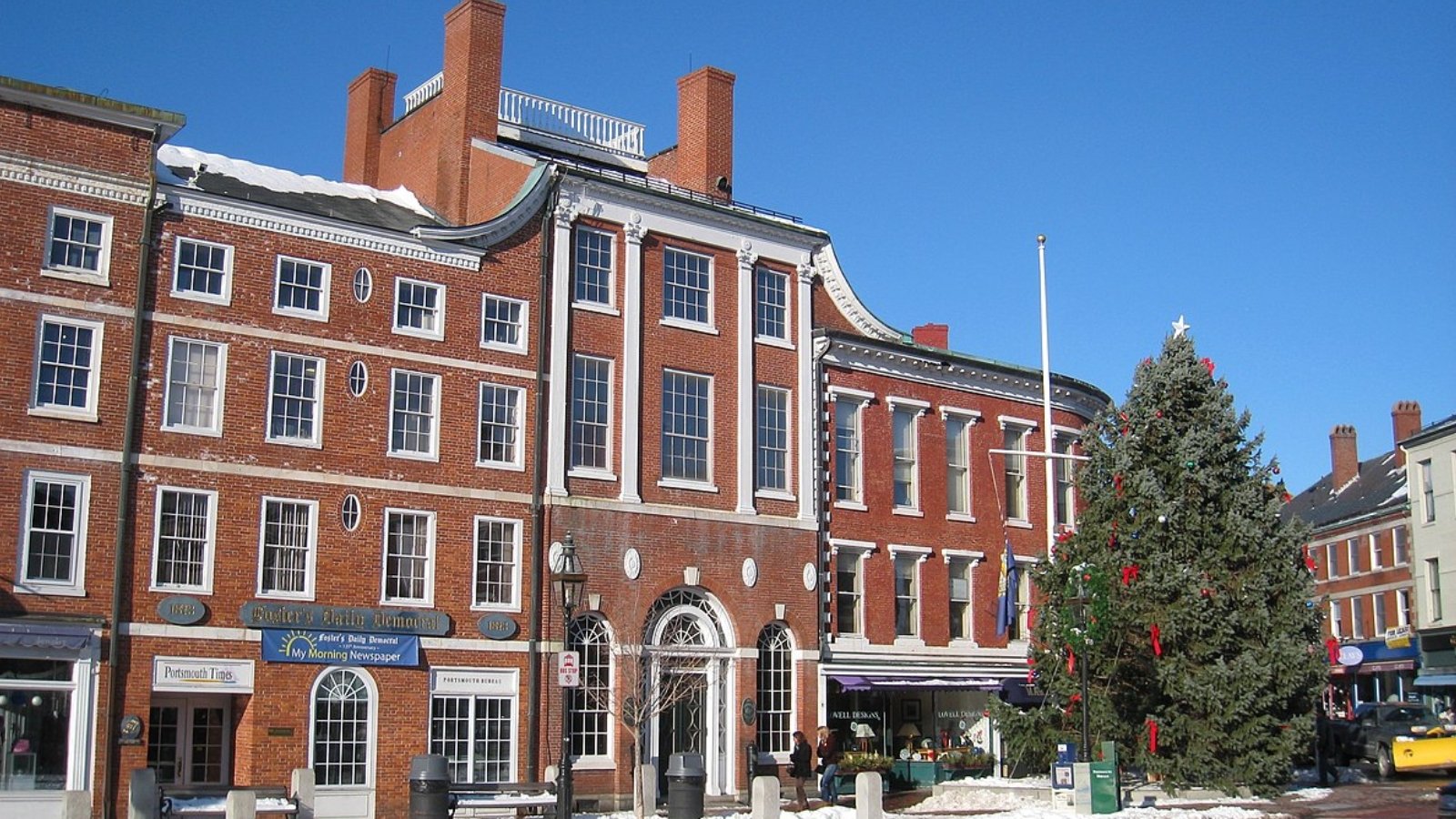
Why are people willing to pay so much to live here? What’s special about it?
Portsmouth offers the unique combination of historic seaport charm, coastal recreation, and urban amenities that attracts professionals, retirees, and cultural enthusiasts. The city provides walkable downtown areas, excellent restaurants, cultural events, and proximity to both mountains and ocean. Residents enjoy the benefits of city living while maintaining access to New Hampshire’s natural beauty.
The community features diverse neighborhoods from historic downtown properties to waterfront estates, creating options for various lifestyles and budgets. Property values benefit from Portsmouth’s position as the Seacoast’s economic and cultural center with strong employment opportunities. The city attracts buyers seeking sophisticated urban lifestyle with coastal recreation and historic character.
How Portsmouth Rose to Prominence
Portsmouth’s prominence dates to its founding in 1623 as one of New Hampshire’s first settlements and its development as a major colonial seaport. The city’s deep harbor and strategic location made it a center for shipbuilding, trade, and naval operations throughout American history. Wealthy merchants built grand homes that still contribute to the city’s historic character.
The establishment of Portsmouth Naval Shipyard provided stable employment and economic foundation that supported the city through various economic transitions. Modern revitalization efforts have transformed Portsmouth into a cultural and dining destination while preserving its maritime heritage. The city’s combination of history, amenities, and coastal location continues to attract diverse residents and visitors.
3 Interesting Tidbits
- Maritime Heritage – Portsmouth’s Strawbery Banke Museum preserves 400 years of neighborhood history, showcasing the city’s evolution from colonial settlement to modern seaport.
- Naval Legacy – The Portsmouth Naval Shipyard has been building and repairing submarines for the U.S. Navy since 1800, providing stable employment and economic foundation.
- Cultural Hub – The city hosts numerous festivals, concerts, and cultural events, including the prescott Park Arts Festival, making it a regional entertainment destination.
11. Kensington – 117% Home Price Increase Since 2010
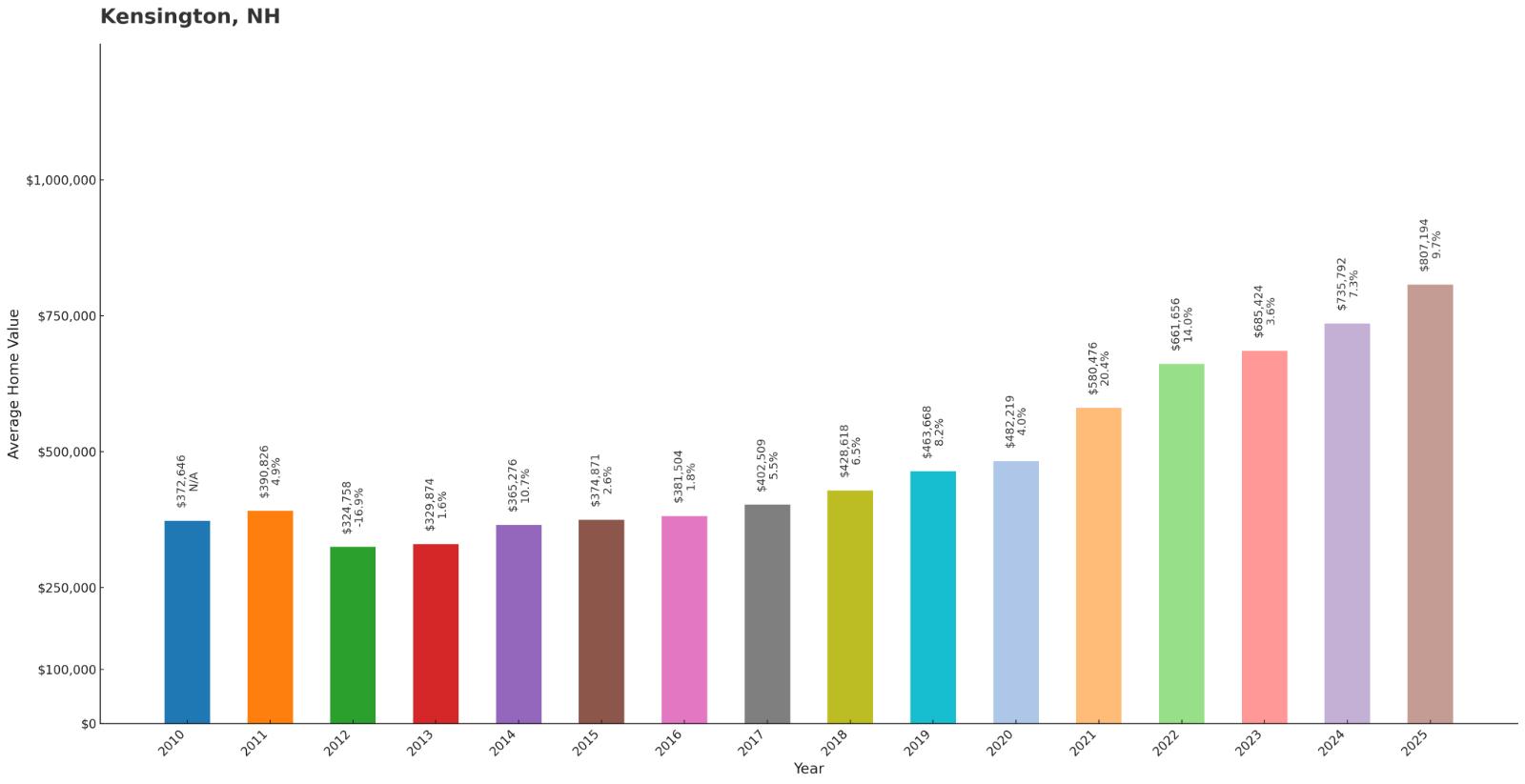
- 2010: $372,646
- 2011: $390,826
- 2012: $324,758
- 2013: $329,874
- 2014: $365,276
- 2015: $374,871
- 2016: $381,504
- 2017: $402,509
- 2018: $428,618
- 2019: $463,668
- 2020: $482,219
- 2021: $580,476
- 2022: $661,656
- 2023: $685,424
- 2024: $735,792
- 2025: $807,194
Kensington has grown by 117% since 2010, recovering from significant early-decade volatility to show strong appreciation. The town experienced a major dip in 2012-2013 before steady growth brought values to current levels of $807,194. This small Seacoast community benefits from proximity to Portsmouth and Massachusetts employment while maintaining rural character.
Why Kensington?

Why are people willing to pay so much to live here? What’s special about it?
Kensington provides rural tranquility with convenient access to Seacoast employment and recreational opportunities, making it ideal for professionals seeking space and privacy. The small town offers excellent schools, low crime rates, and strong community engagement that appeals to families. Residents enjoy large lots, conservation areas, and agricultural heritage while remaining connected to urban amenities.
The community maintains its small-town atmosphere and natural beauty while providing access to both New Hampshire coast and Massachusetts employment centers. Property values benefit from limited inventory and high demand from buyers seeking rural lifestyle with career flexibility. Kensington attracts families and professionals who prioritize community, space, and natural beauty.
How Kensington Rose to Prominence
Kensington’s development as a desirable residential community grew from its location in the Seacoast region and its preservation of rural character. Originally settled in the 1730s as an agricultural town, Kensington remained rural until modern transportation made it accessible to Portsmouth and Boston-area employment. The town attracted families seeking larger properties and small-town atmosphere.
The community’s commitment to preserving agricultural land and natural areas helped maintain the rural character that attracts affluent buyers. Kensington’s small size and careful growth management created scarcity that enhances property values. The town’s balance of rural lifestyle and accessibility continues to drive demand from diverse buyers seeking space and community.
3 Interesting Tidbits
- Agricultural Heritage – Kensington maintains active farms and agricultural traditions, including popular farm stands and seasonal agricultural activities.
- Small Community – With approximately 2,000 residents, Kensington maintains an intimate community atmosphere where civic participation is high and neighbors are engaged.
- Conservation Success – The town has preserved significant natural areas through conservation efforts, maintaining the rural character that enhances property values.
10. Windham – 132% Home Price Increase Since 2010
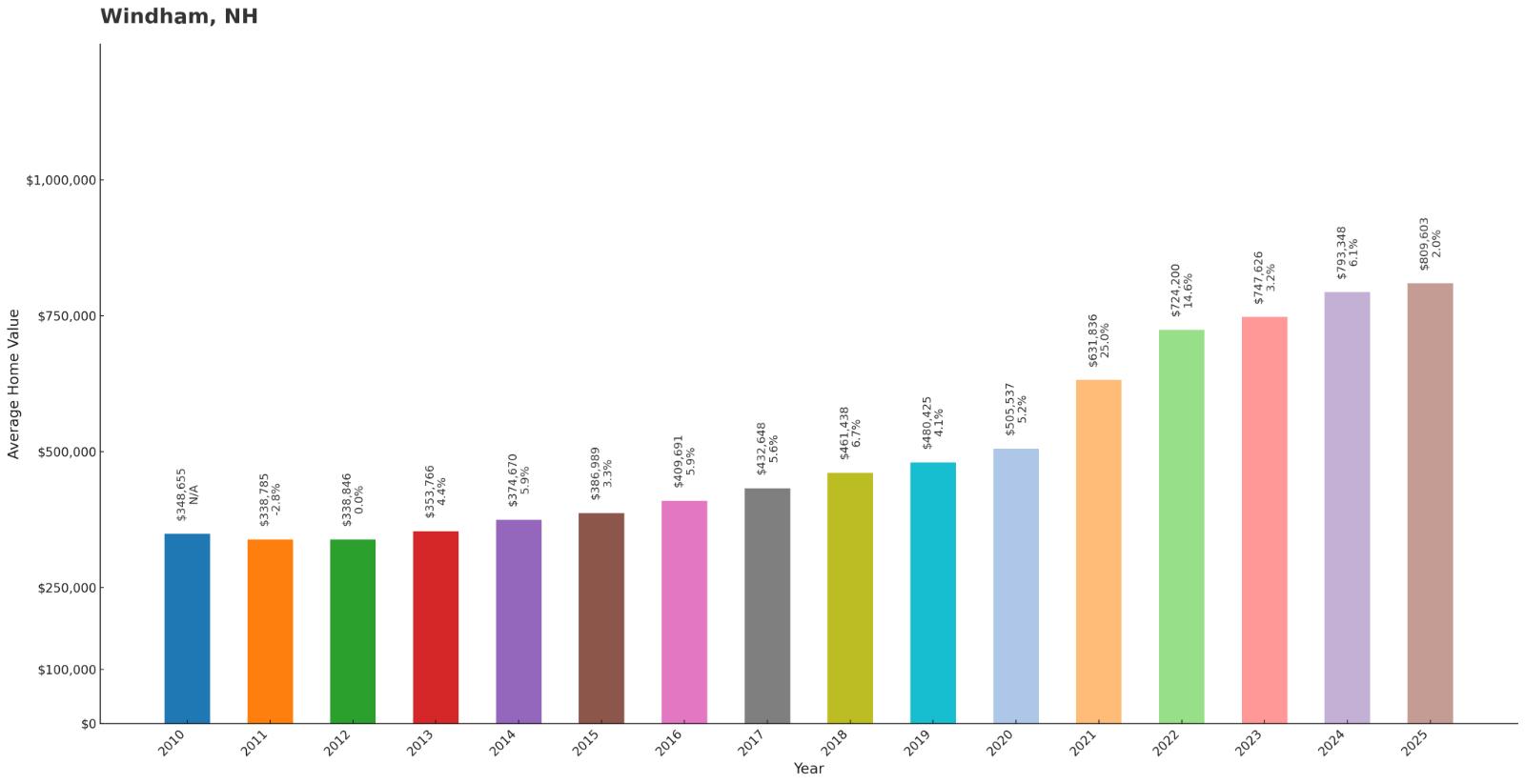
- 2010: $348,655
- 2011: $338,785
- 2012: $338,846
- 2013: $353,766
- 2014: $374,670
- 2015: $386,989
- 2016: $409,691
- 2017: $432,648
- 2018: $461,438
- 2019: $480,425
- 2020: $505,537
- 2021: $631,836
- 2022: $724,200
- 2023: $747,626
- 2024: $793,348
- 2025: $809,603
Windham has grown by 132% since 2010, showing steady appreciation with significant acceleration after 2020. The town demonstrated consistent growth throughout the decade with dramatic increases in recent years, reaching current values of $809,603. This southern New Hampshire community benefits from proximity to Massachusetts employment while maintaining suburban character.
Why Windham?
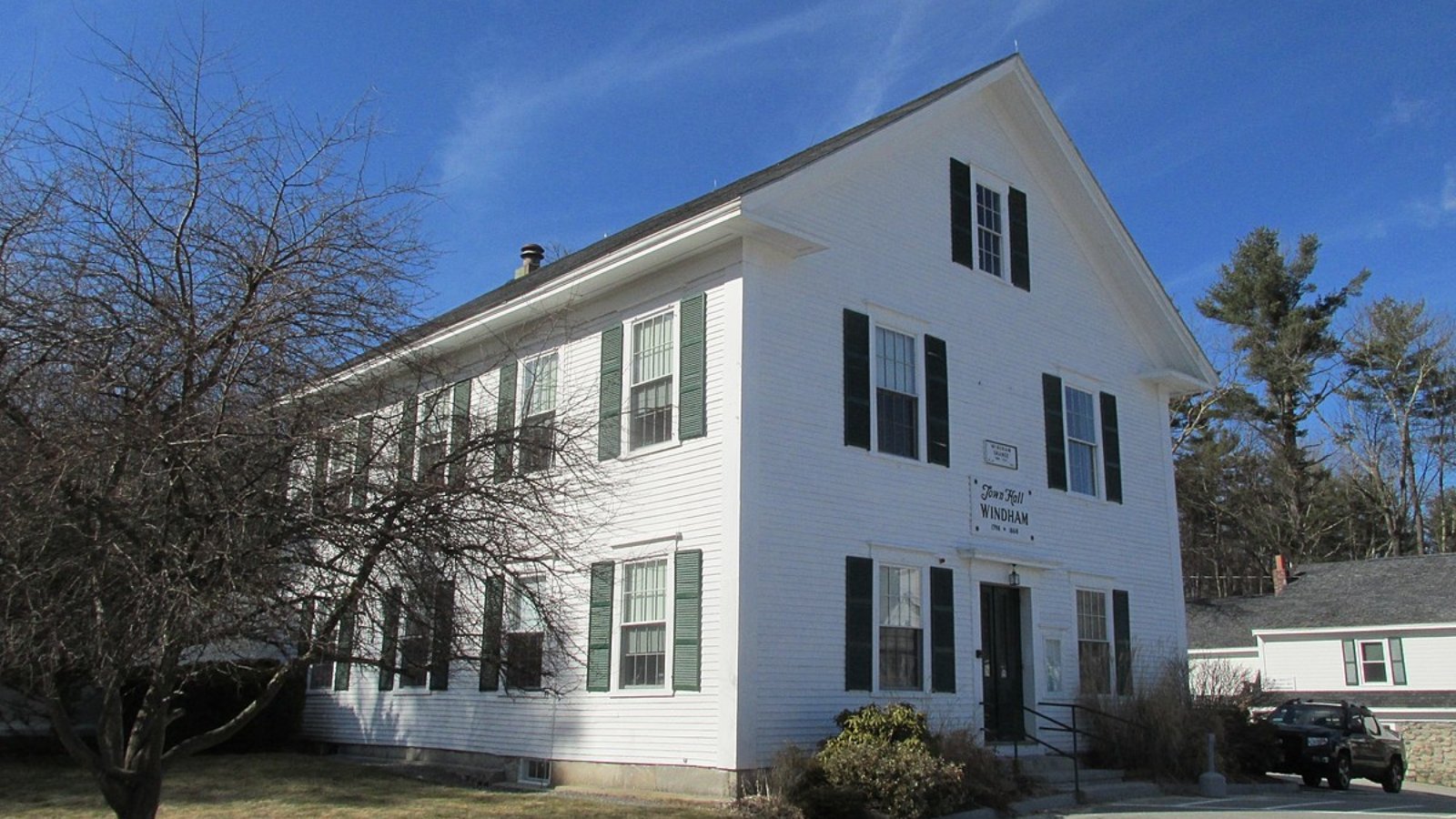
Why are people willing to pay so much to live here? What’s special about it?
Windham offers excellent schools, safe neighborhoods, and convenient access to both New Hampshire amenities and Massachusetts employment opportunities. The town provides suburban comfort with rural touches, including conservation areas and recreational facilities that appeal to active families. Residents enjoy the benefits of New Hampshire’s tax advantages while maintaining reasonable commuting distances.
The community features well-planned neighborhoods, modern amenities, and strong municipal services that create high quality of life. Property values benefit from the town’s strategic location and reputation for educational excellence and family-friendly atmosphere. Windham attracts professionals and families seeking suburban lifestyle with easy access to multiple employment and recreational centers.
How Windham Rose to Prominence
Windham’s development as a premier residential community accelerated in the 1970s and 80s as improved highways made commuting to Massachusetts feasible for families seeking larger properties and better schools. Originally settled in the 1740s, the town remained largely agricultural until suburban growth reached southern New Hampshire. The area attracted professionals seeking New Hampshire’s tax benefits.
The town’s commitment to excellent schools and recreational facilities established its reputation as a family destination throughout the region. Careful planning balanced growth with preservation of natural areas and community character. Windham’s strategic location between Salem’s shopping and Massachusetts employment centers made it attractive to diverse buyers seeking convenience and quality.
3 Interesting Tidbits
- Educational Excellence – Windham High School consistently ranks among New Hampshire’s top public high schools, attracting families throughout southern New Hampshire.
- Recreation Focus – The town offers extensive recreational facilities including golf courses, sports fields, and conservation areas that enhance quality of life.
- Economic Balance – Windham successfully balances residential growth with commercial development, providing local services while maintaining community character.
9. Hollis – 55% Home Price Increase Since 2010
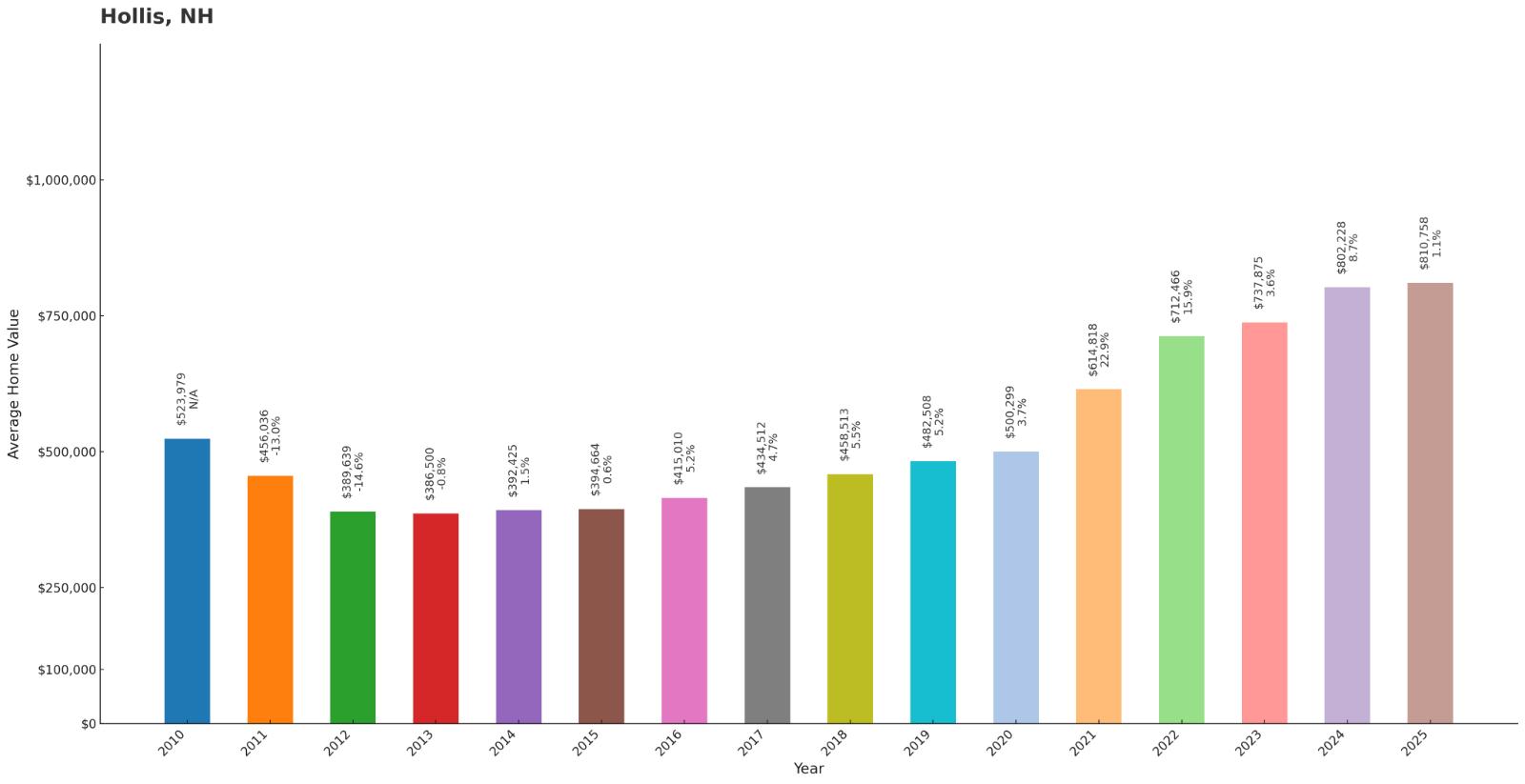
- 2010: $523,979
- 2011: $456,036
- 2012: $389,639
- 2013: $386,500
- 2014: $392,425
- 2015: $394,664
- 2016: $415,010
- 2017: $434,512
- 2018: $458,513
- 2019: $482,508
- 2020: $500,299
- 2021: $614,818
- 2022: $712,466
- 2023: $737,875
- 2024: $802,228
- 2025: $810,758
Hollis experienced significant volatility in the early 2010s, dropping from over $523,000 in 2010 to under $387,000 by 2013 before beginning steady recovery. Despite the dramatic early decline, the town has grown 55% from its 2010 baseline, reaching current values of $810,758. This upscale community has established itself as one of southern New Hampshire’s premier residential destinations.
Why Hollis?
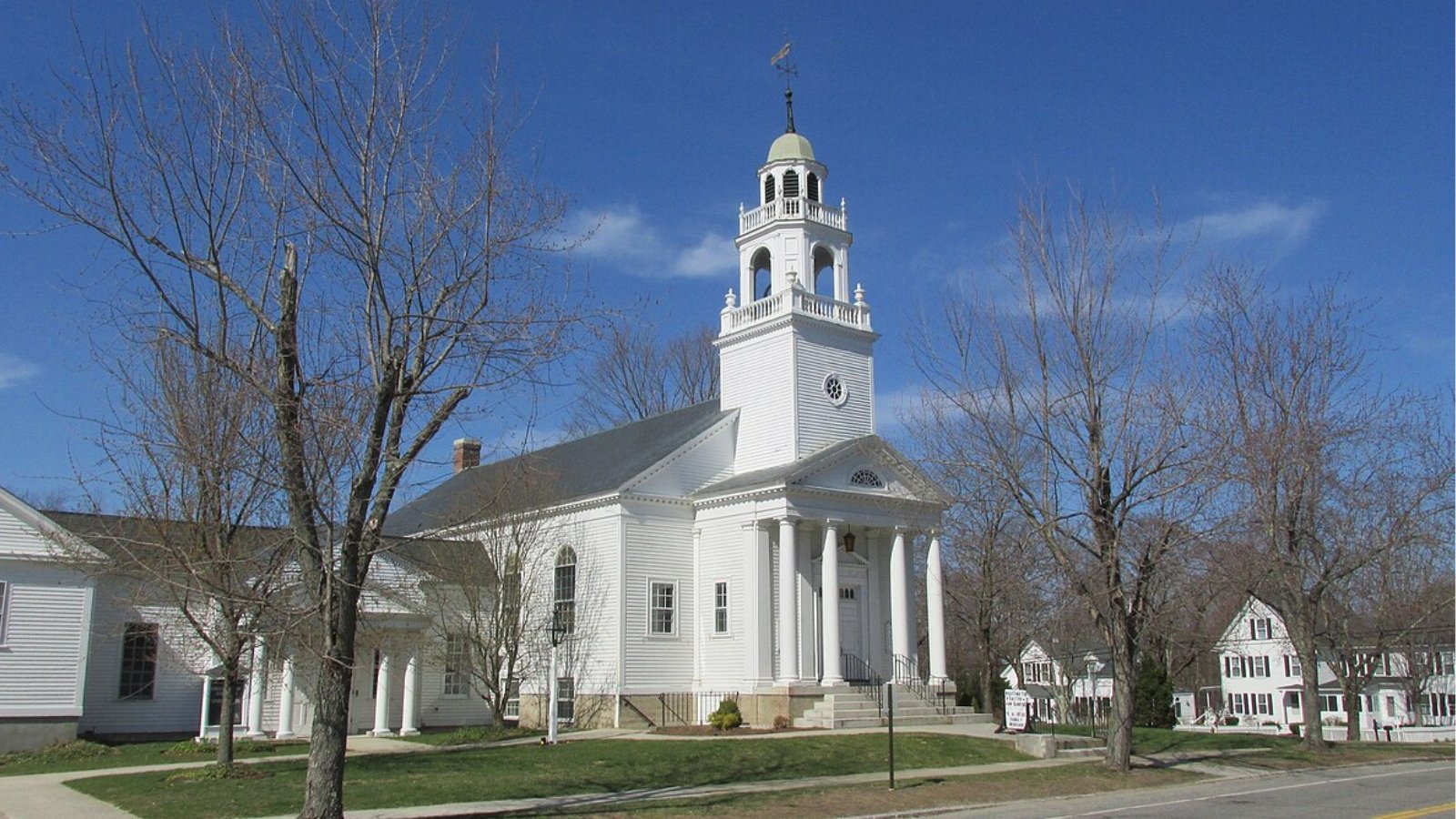
Why are people willing to pay so much to live here? What’s special about it?
Hollis represents the pinnacle of New Hampshire suburban living, offering excellent schools, upscale neighborhoods, and convenient access to Boston-area employment. The town provides large lots, luxury homes, and sophisticated amenities that appeal to affluent professionals and executives. Residents enjoy low crime rates, well-maintained infrastructure, and strong community services in an exclusive setting.
The community features historic charm combined with modern conveniences, including upscale shopping and dining options that rival urban centers. Property values benefit from Hollis’s established reputation as a premium destination and its strategic location for commuters. The town attracts successful professionals seeking the ultimate suburban lifestyle with educational excellence and luxury amenities.
How Hollis Rose to Prominence
Hollis’s reputation as an upscale residential community developed from its early prosperity as an agricultural and mill town combined with its strategic location for modern commuters. Founded in 1746, the town attracted wealthy residents who built grand homes that contributed to its prestigious character. The presence of quality schools and careful development standards established early foundations for exclusivity.
The town’s transformation accelerated with improved highway access that made Boston-area employment feasible while preserving rural character and educational excellence. Hollis’s commitment to maintaining large lots and high development standards attracted affluent families throughout New England. The community’s balance of luxury, education, and convenience continues to drive demand from successful professionals.
3 Interesting Tidbits
- Educational Prestige – Hollis Brookline High School consistently ranks among New Hampshire’s top public schools and sends graduates to prestigious universities nationwide.
- Historic Character – The town features well-preserved historic districts and buildings that provide authentic New England charm while supporting luxury property values.
- Executive Community – Hollis attracts corporate executives, entrepreneurs, and professionals who value both luxury living and convenient access to major business centers.
8. Greenland – 141% Home Price Increase Since 2010
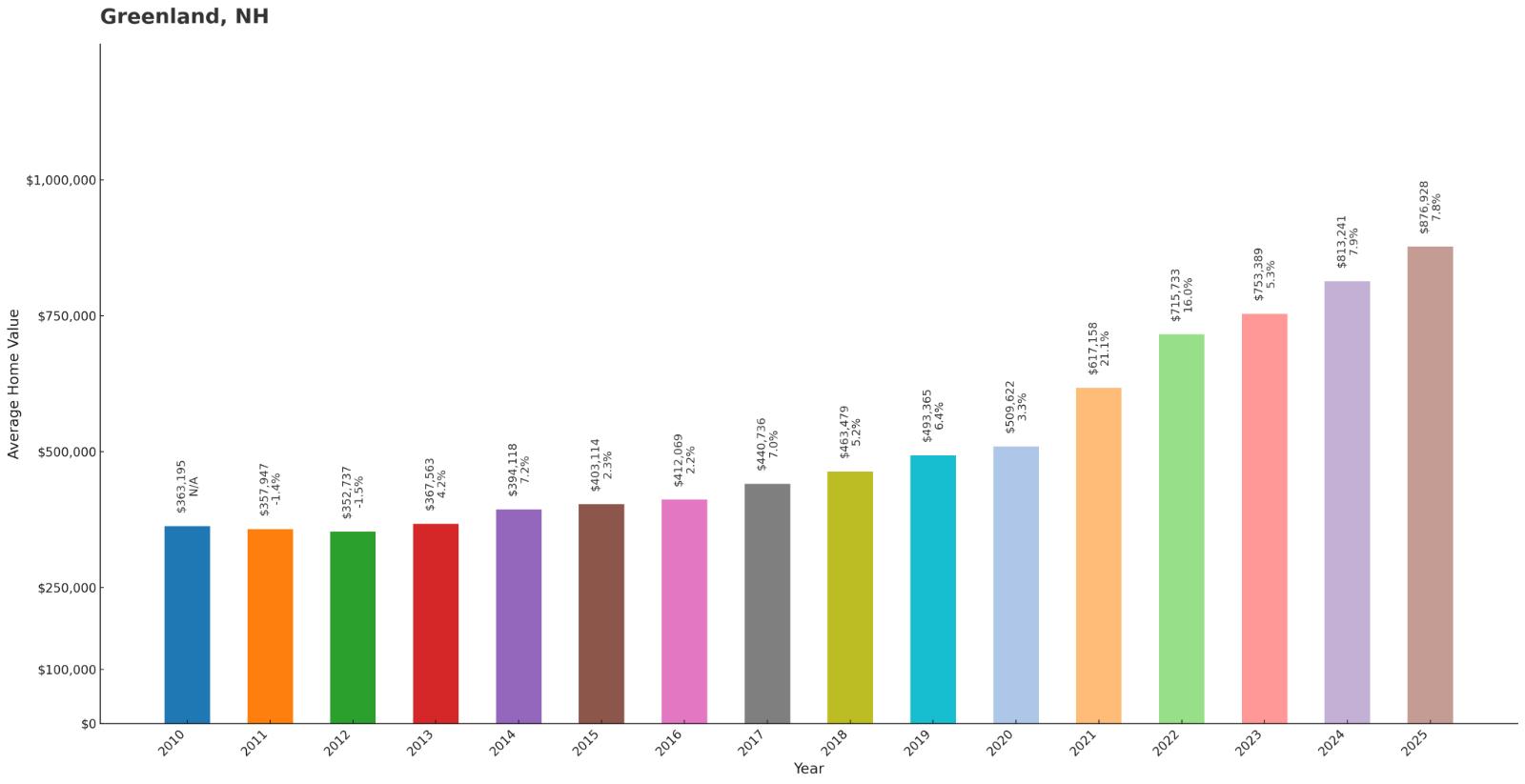
- 2010: $363,195
- 2011: $357,947
- 2012: $352,737
- 2013: $367,563
- 2014: $394,118
- 2015: $403,114
- 2016: $412,069
- 2017: $440,736
- 2018: $463,479
- 2019: $493,365
- 2020: $509,622
- 2021: $617,158
- 2022: $715,733
- 2023: $753,389
- 2024: $813,241
- 2025: $876,928
Greenland has grown by 141% since 2010, showing consistent appreciation with dramatic acceleration after 2020. The town demonstrated steady growth throughout the decade before jumping from $509,622 in 2020 to current values of $876,928. This small Seacoast community benefits from proximity to Portsmouth employment and coastal recreation.
Why Greenland?
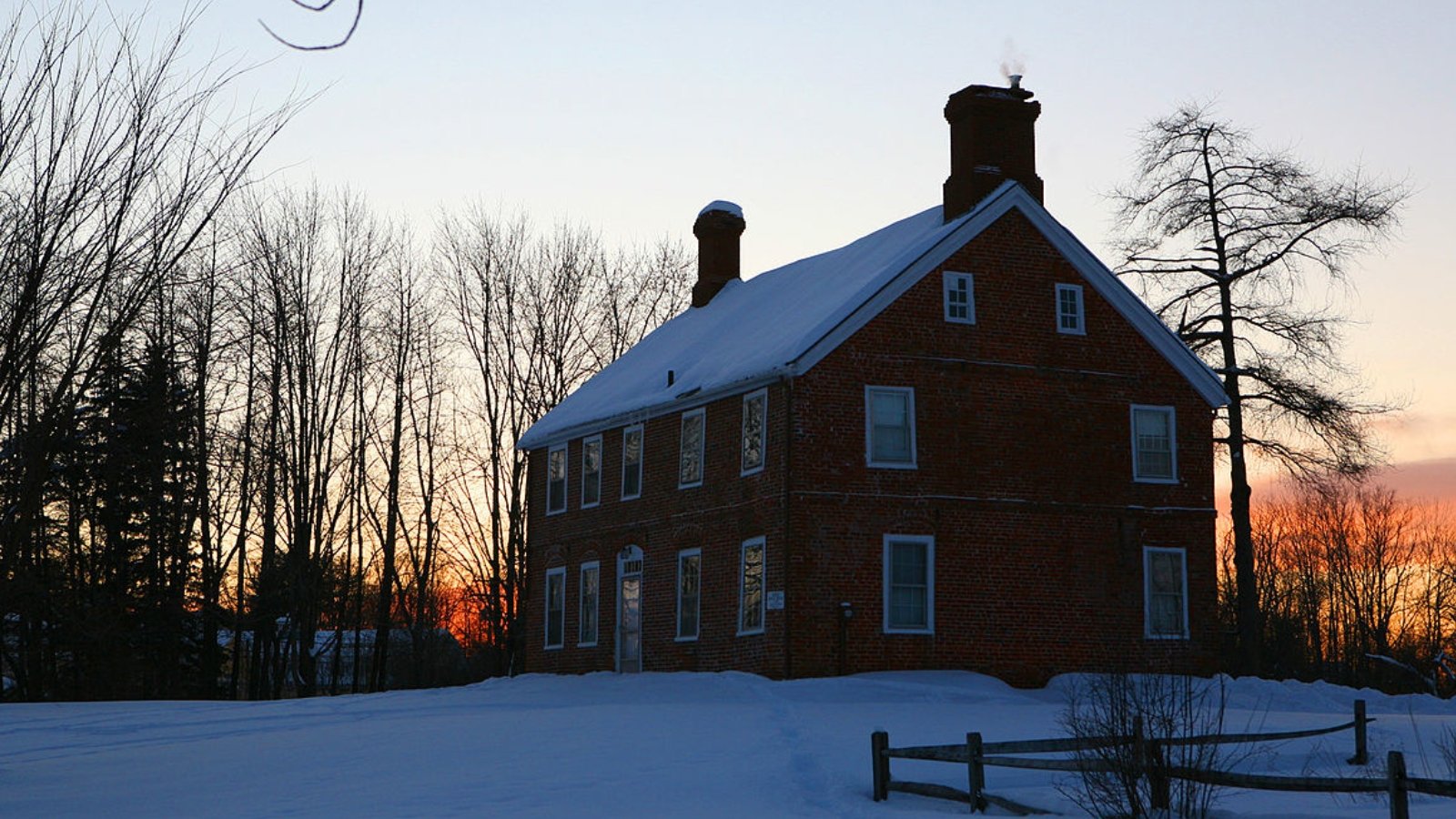
Why are people willing to pay so much to live here? What’s special about it?
Greenland offers the ideal combination of small-town atmosphere with convenient access to Portsmouth employment and coastal recreation. The town provides excellent schools, low crime rates, and well-maintained neighborhoods that appeal to families and professionals. Residents enjoy rural character with suburban conveniences and easy access to New Hampshire’s seacoast.
The community maintains its historic character while accommodating modern development, creating diverse housing options from historic properties to new construction. Property values benefit from Greenland’s strategic location and limited inventory in this desirable Seacoast area. The town attracts buyers seeking quality schools, community engagement, and coastal access.
How Greenland Rose to Prominence
Greenland’s development as a desirable residential community grew from its location in the heart of the Seacoast region and its preservation of small-town character. Originally settled in 1635, the town maintained its agricultural and residential character while neighboring communities became more urbanized. The area attracted families seeking tranquil living near coastal employment centers.
The town’s commitment to excellent schools and careful growth management helped establish its reputation as a premier family destination. Greenland’s strategic position between Portsmouth and other Seacoast communities made it attractive to professionals seeking small-town lifestyle with urban access. The community’s balance of character and convenience continues to drive strong property demand.
3 Interesting Tidbits
- Historic Roots – Greenland is one of New Hampshire’s oldest communities, founded in 1635, with well-preserved historic buildings and character throughout the town.
- Educational Excellence – Greenland Central School consistently ranks among the state’s top elementary schools, attracting families throughout the Seacoast region.
- Strategic Location – The town provides easy access to Portsmouth, coastal recreation, and major highways while maintaining its rural character and community atmosphere.
7. Newfields – 59% Home Price Increase Since 2010
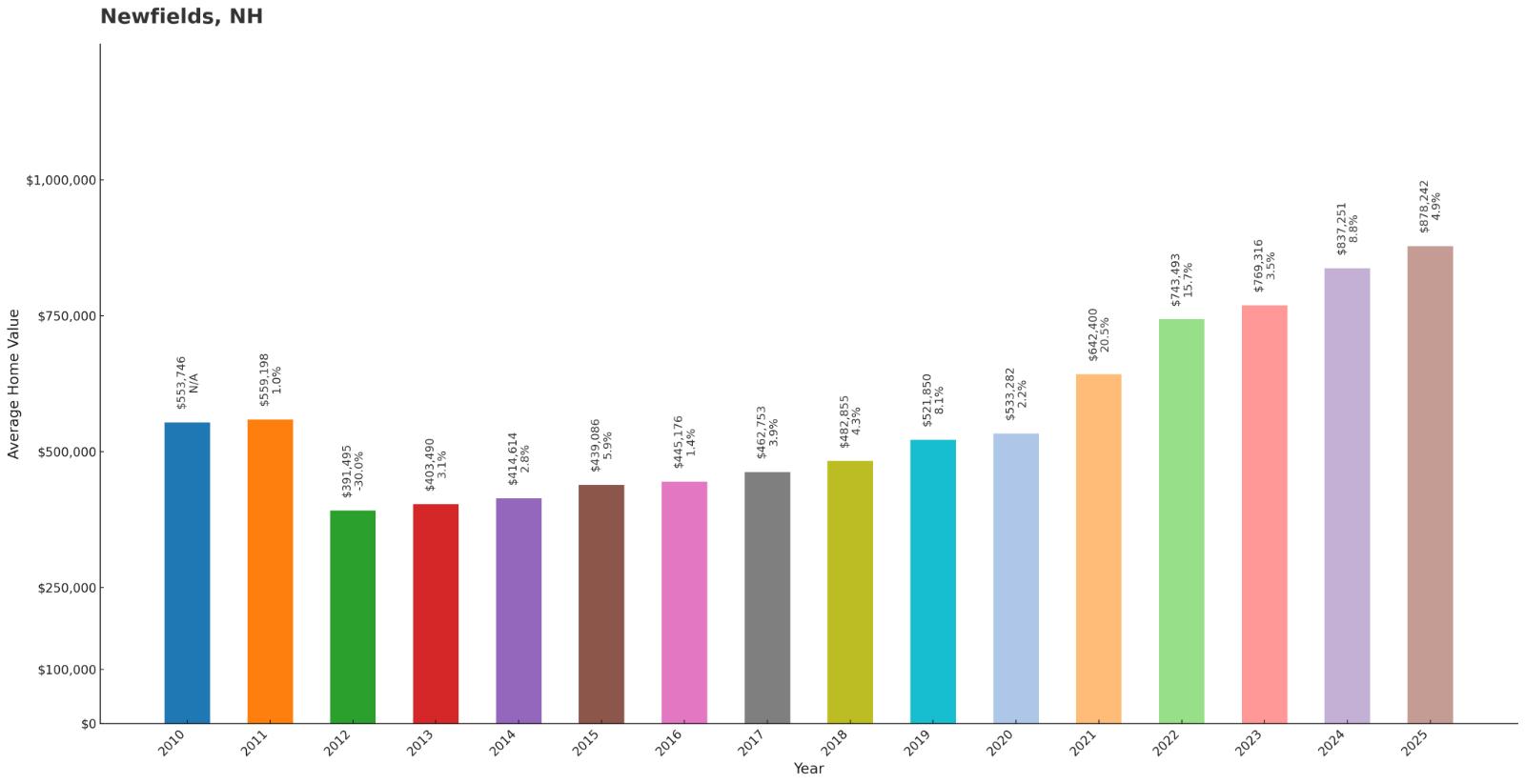
- 2010: $553,746
- 2011: $559,198
- 2012: $391,495
- 2013: $403,490
- 2014: $414,614
- 2015: $439,086
- 2016: $445,176
- 2017: $462,753
- 2018: $482,855
- 2019: $521,850
- 2020: $533,282
- 2021: $642,400
- 2022: $743,493
- 2023: $769,316
- 2024: $837,251
- 2025: $878,242
Newfields experienced dramatic volatility in the early 2010s, dropping from over $553,000 to under $392,000 before beginning recovery. Despite the early decline, the town has grown 59% from its 2010 starting point, reaching current values of $878,242. This small Seacoast community offers upscale rural living with convenient access to regional employment centers.
Why Newfields?

Why are people willing to pay so much to live here? What’s special about it?
Newfields provides sophisticated rural living in a small-town setting with convenient access to Seacoast employment and recreational opportunities. The town offers large lots, historic character, and low population density that appeals to affluent buyers seeking privacy and tranquility. Residents enjoy excellent schools and strong community engagement in an exclusive rural environment.
The community maintains its agricultural heritage and natural beauty while providing modern conveniences and services. Property values benefit from limited inventory and high demand from professionals seeking rural lifestyle with career flexibility. Newfields attracts buyers who prioritize space, privacy, and authentic New England character while maintaining access to employment centers.
How Newfields Rose to Prominence
Newfields’ development as an upscale residential community grew from its location in the Seacoast region and its preservation of rural character and historic charm. Originally settled in the 1600s, the town maintained its agricultural character while neighboring areas became more developed. The community attracted affluent residents seeking large properties and authentic New England atmosphere.
The town’s commitment to preserving historic buildings and rural character helped establish its reputation as an exclusive destination. Newfields’ strategic location between Portsmouth and Exeter made it attractive to professionals seeking rural tranquility with urban access. The community’s balance of exclusivity, character, and convenience continues to drive demand from affluent buyers.
3 Interesting Tidbits
- Historic Preservation – Newfields features well-preserved 18th and 19th-century architecture, including historic farms and houses that maintain authentic New England character.
- Rural Exclusivity – With fewer than 1,500 residents, Newfields maintains an intimate, exclusive atmosphere that appeals to affluent buyers seeking privacy.
- Agricultural Heritage – The town preserves active agricultural land and rural traditions, including historic farms that contribute to its authentic rural character.
6. Hampton Falls – 176% Home Price Increase Since 2010
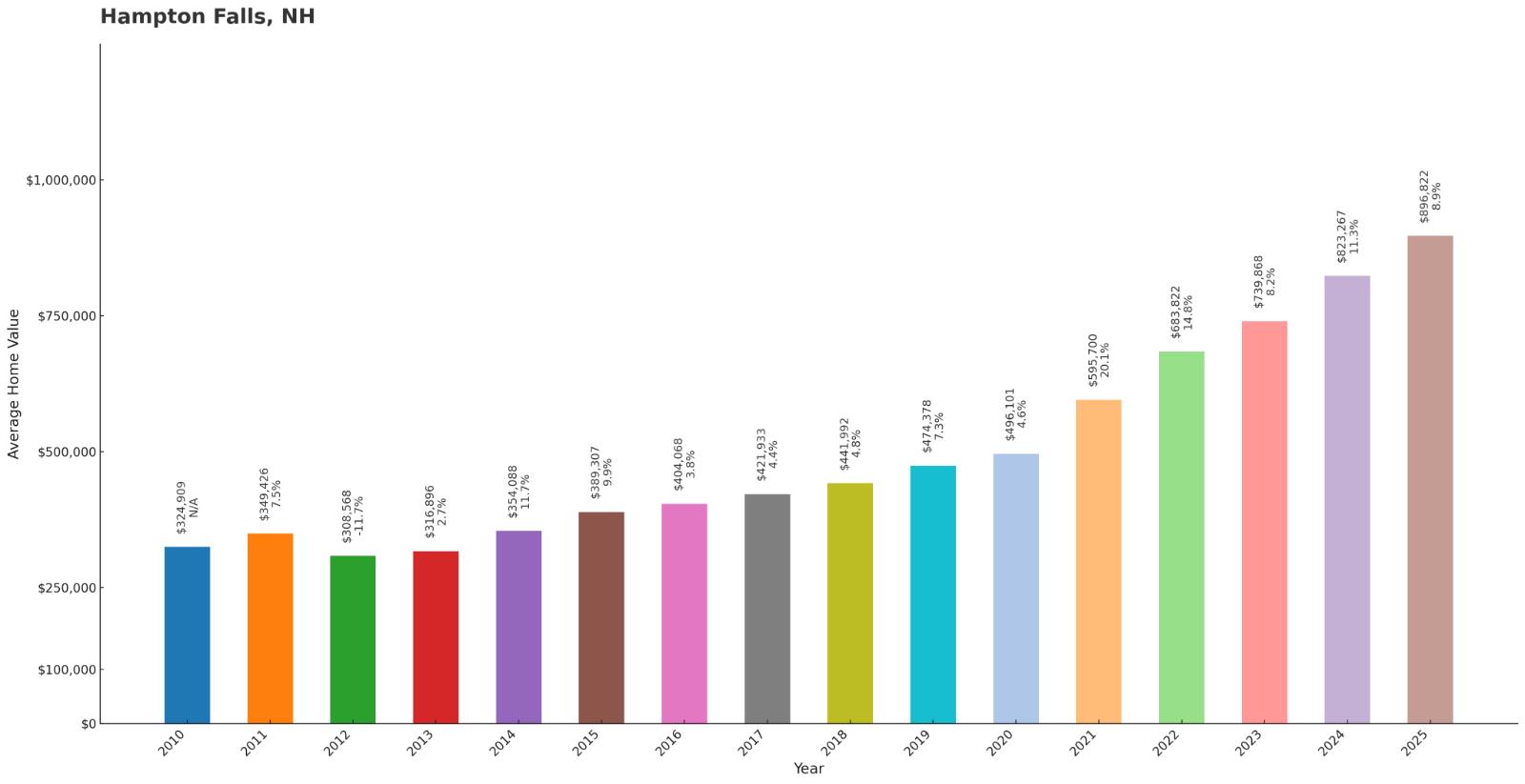
- 2010: $324,909
- 2011: $349,426
- 2012: $308,568
- 2013: $316,896
- 2014: $354,088
- 2015: $389,307
- 2016: $404,068
- 2017: $421,933
- 2018: $441,992
- 2019: $474,378
- 2020: $496,101
- 2021: $595,700
- 2022: $683,822
- 2023: $739,868
- 2024: $823,267
- 2025: $896,822
Hampton Falls has nearly tripled since 2010, showing the highest percentage growth among all communities on this list at 176%. The town recovered from early-decade volatility to demonstrate consistent appreciation, with significant acceleration after 2020 bringing values to $896,822. This small Seacoast community benefits from coastal proximity and rural character.
Why Hampton Falls?
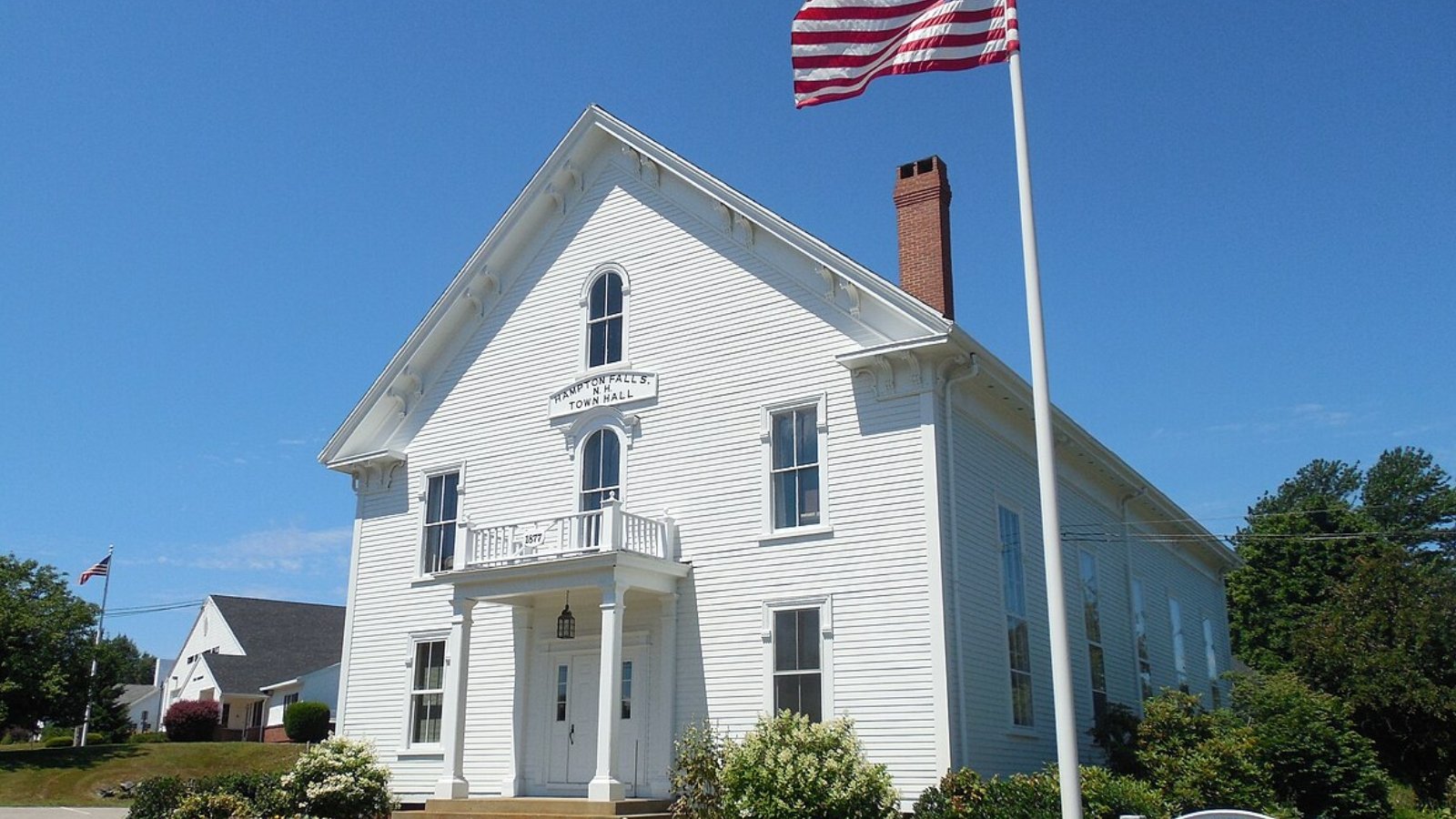
Why are people willing to pay so much to live here? What’s special about it?
Hampton Falls offers the perfect combination of coastal access and rural tranquility, providing easy reach to beaches while maintaining small-town atmosphere. The town features excellent schools, safe neighborhoods, and natural beauty that appeals to families and professionals. Residents enjoy the benefits of seacoast living without the density and crowds of larger coastal communities.
The community provides diverse recreational opportunities from beach access to hiking and conservation areas that create an active outdoor lifestyle. Property values benefit from the town’s unique position offering both coastal and rural amenities with limited development opportunities. Hampton Falls attracts buyers seeking the ultimate New Hampshire coastal lifestyle with space and privacy.
How Hampton Falls Rose to Prominence
Hampton Falls’ transformation from rural agricultural community to sought-after residential destination began with growing recognition of its coastal access and natural beauty. Originally settled in the 1600s as a farming community, the town remained largely rural until modern transportation made coastal living more accessible. The area attracted families seeking beach access with rural atmosphere.
The town’s commitment to preserving open space and managing growth carefully helped maintain the rural character that attracts premium buyers. Hampton Falls’ strategic location between major coastal attractions and employment centers made it attractive to diverse residents. The community’s balance of coastal access, rural beauty, and small-town atmosphere continues to drive strong demand.
3 Interesting Tidbits
- Coastal Access – Hampton Falls provides easy access to New Hampshire’s seacoast beaches while maintaining rural character and avoiding coastal development density.
- Conservation Success – The town has preserved significant natural areas and farmland, maintaining the rural beauty that enhances property values.
- Small Community – With approximately 2,300 residents, Hampton Falls maintains an intimate community atmosphere where civic engagement is high and neighbors are connected.
5. North Hampton – 156% Home Price Increase Since 2010
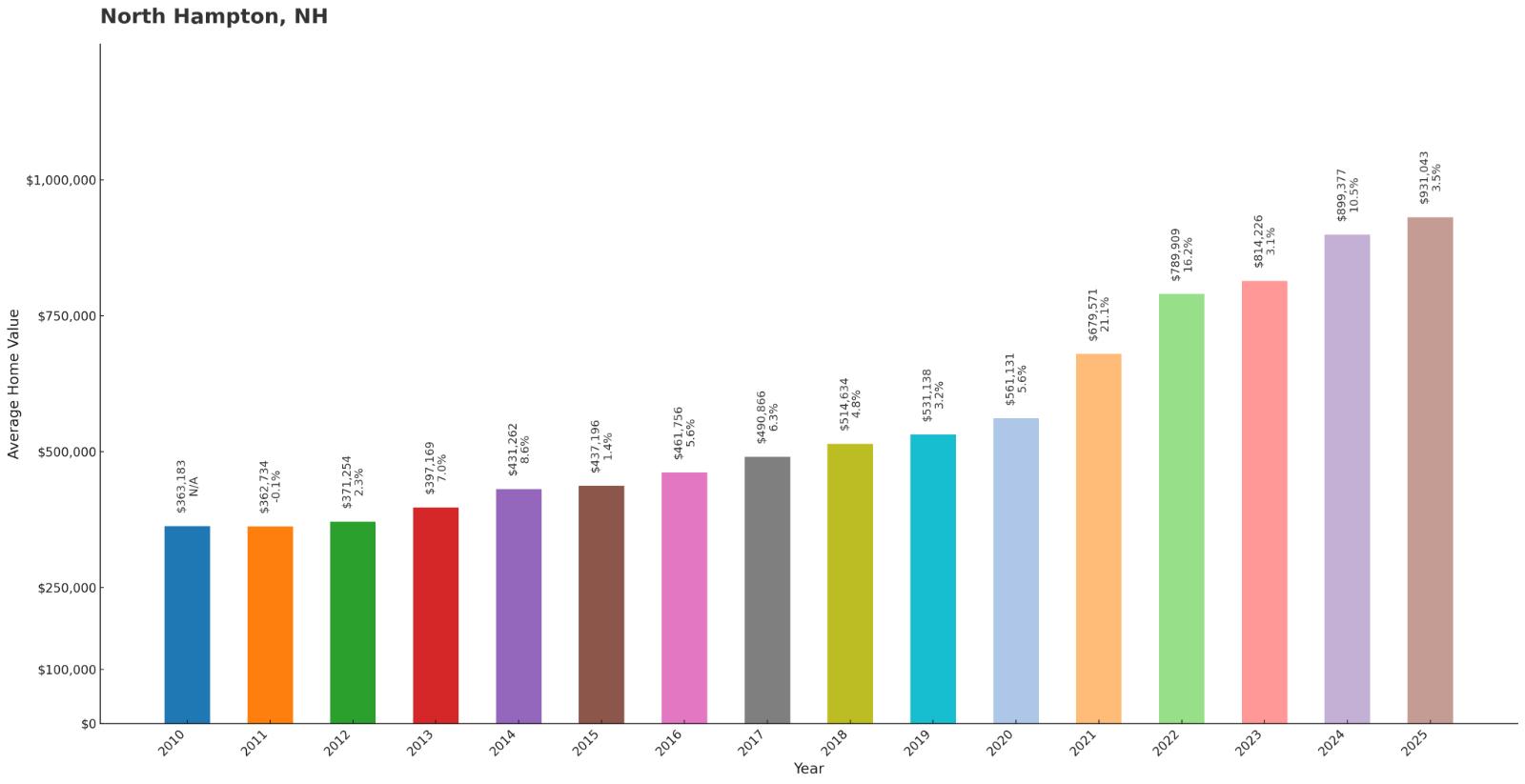
- 2010: $363,183
- 2011: $362,734
- 2012: $371,254
- 2013: $397,169
- 2014: $431,262
- 2015: $437,196
- 2016: $461,756
- 2017: $490,866
- 2018: $514,634
- 2019: $531,138
- 2020: $561,131
- 2021: $679,571
- 2022: $789,909
- 2023: $814,226
- 2024: $899,377
- 2025: $931,043
North Hampton has grown by 156% since 2010, showing consistent appreciation throughout the period with dramatic acceleration after 2020. The town demonstrated steady upward momentum with significant growth bringing values to $931,043. This coastal community benefits from beach access, rural character, and proximity to employment centers.
Why North Hampton?
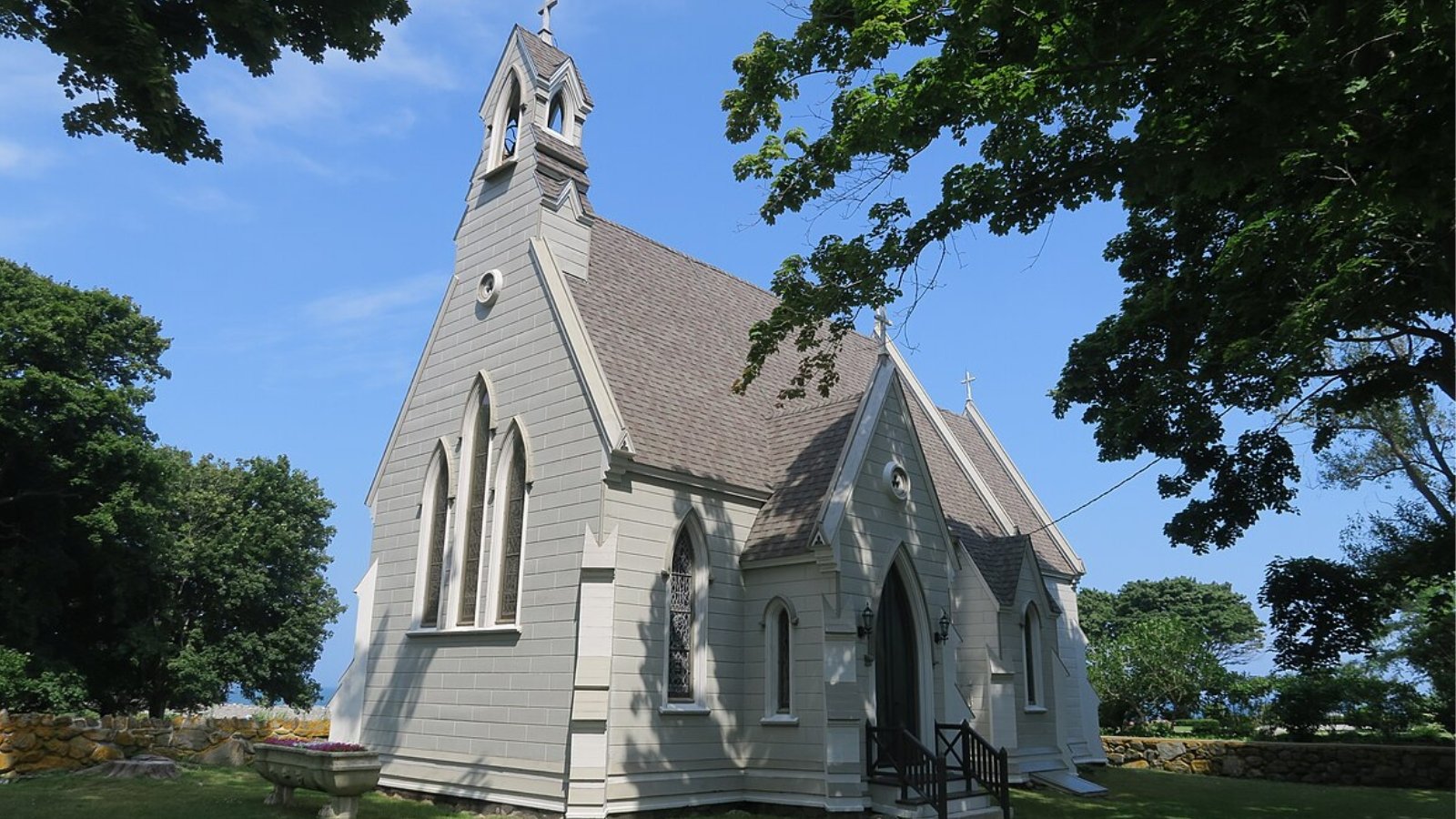
Why are people willing to pay so much to live here? What’s special about it?
North Hampton provides direct access to pristine Atlantic beaches while maintaining rural character and small-town atmosphere that appeals to affluent families and professionals. The town offers excellent schools, conservation areas, and recreational opportunities that create high quality of life. Residents enjoy coastal living without the commercialization and density of larger beach communities.
The community features diverse housing options from beachfront estates to rural properties, creating opportunities for various lifestyles while maintaining exclusivity. Property values benefit from limited coastal inventory and strong demand for beach access properties. North Hampton attracts buyers seeking the ultimate coastal New Hampshire lifestyle with privacy and natural beauty.
How North Hampton Rose to Prominence
North Hampton’s development as a premier coastal community grew from its pristine beaches and early recognition as a desirable summer destination. Originally settled in the 1630s, the town maintained its rural and coastal character while neighboring areas became more developed. The area attracted wealthy families seeking beach access with exclusivity and privacy.
The town’s commitment to environmental protection and careful development helped preserve the natural beauty that drives property values. North Hampton’s strategic location between major cities and coastal attractions made it attractive to affluent residents seeking the ultimate coastal lifestyle. The community’s balance of beach access, rural beauty, and exclusivity continues to attract premium buyers.
3 Interesting Tidbits
- Beach Excellence – North Hampton Beach offers some of New Hampshire’s most pristine and less crowded coastal areas, providing residents with exclusive beach access.
- Conservation Leadership – The town has preserved significant portions of its landscape through conservation efforts, maintaining the natural beauty that enhances property values.
- Historic Character – North Hampton features well-preserved historic buildings and rural character that create authentic coastal New England atmosphere.
4. Hanover – 125% Home Price Increase Since 2010

- 2010: $431,567
- 2011: $425,459
- 2012: $425,886
- 2013: $441,918
- 2014: $461,145
- 2015: $477,204
- 2016: $492,037
- 2017: $511,834
- 2018: $537,303
- 2019: $581,269
- 2020: $586,167
- 2021: $721,775
- 2022: $868,104
- 2023: $905,572
- 2024: $971,377
- 2025: $972,086
Hanover has more than doubled since 2010, showing steady appreciation with dramatic acceleration after 2020. The town demonstrated consistent growth throughout the decade with significant increases bringing current values to $972,086. This Upper Valley community benefits from Dartmouth College’s presence and sophisticated cultural environment.
Why Hanover?

Why are people willing to pay so much to live here? What’s special about it?
Hanover offers the unique combination of Ivy League sophistication and rural New England beauty, creating an intellectually stimulating environment with natural recreation opportunities. Dartmouth College provides cultural events, continuing education, and a stable economic base that attracts professors, professionals, and retirees. The town features excellent schools and walkable downtown areas with upscale amenities.
The community combines academic prestige with outdoor recreation, offering skiing, hiking, and Connecticut River activities alongside world-class education and cultural resources. Property values benefit from the college’s stability and the town’s reputation as one of New England’s most desirable places to live. Hanover attracts educated professionals and academics seeking intellectual community with natural beauty.
How Hanover Rose to Prominence
Hanover’s prominence dates to the founding of Dartmouth College in 1769, which established the town as an educational and cultural center in the Connecticut River Valley. The college attracted educated residents and created economic stability that supported community development. The town developed as both a college community and regional center for the Upper Valley.
The presence of Dartmouth-Hitchcock Medical Center further enhanced Hanover’s reputation and economic foundation, attracting medical professionals and researchers. The town’s commitment to preserving its character while accommodating growth has maintained its appeal to diverse residents. Hanover’s combination of educational excellence, cultural resources, and natural beauty continues to attract affluent buyers nationwide.
3 Interesting Tidbits
- Ivy League Anchor – Dartmouth College, founded in 1769, provides world-class education, cultural events, and economic stability that enhance property values throughout the region.
- Medical Excellence – Dartmouth-Hitchcock Medical Center is a leading academic medical center that attracts top medical professionals and provides advanced healthcare services.
- Outdoor Paradise – Hanover offers exceptional four-season recreation, from skiing at nearby resorts to hiking the Appalachian Trail, which passes through the town.
3. Newington – 137% Home Price Increase Since 2010
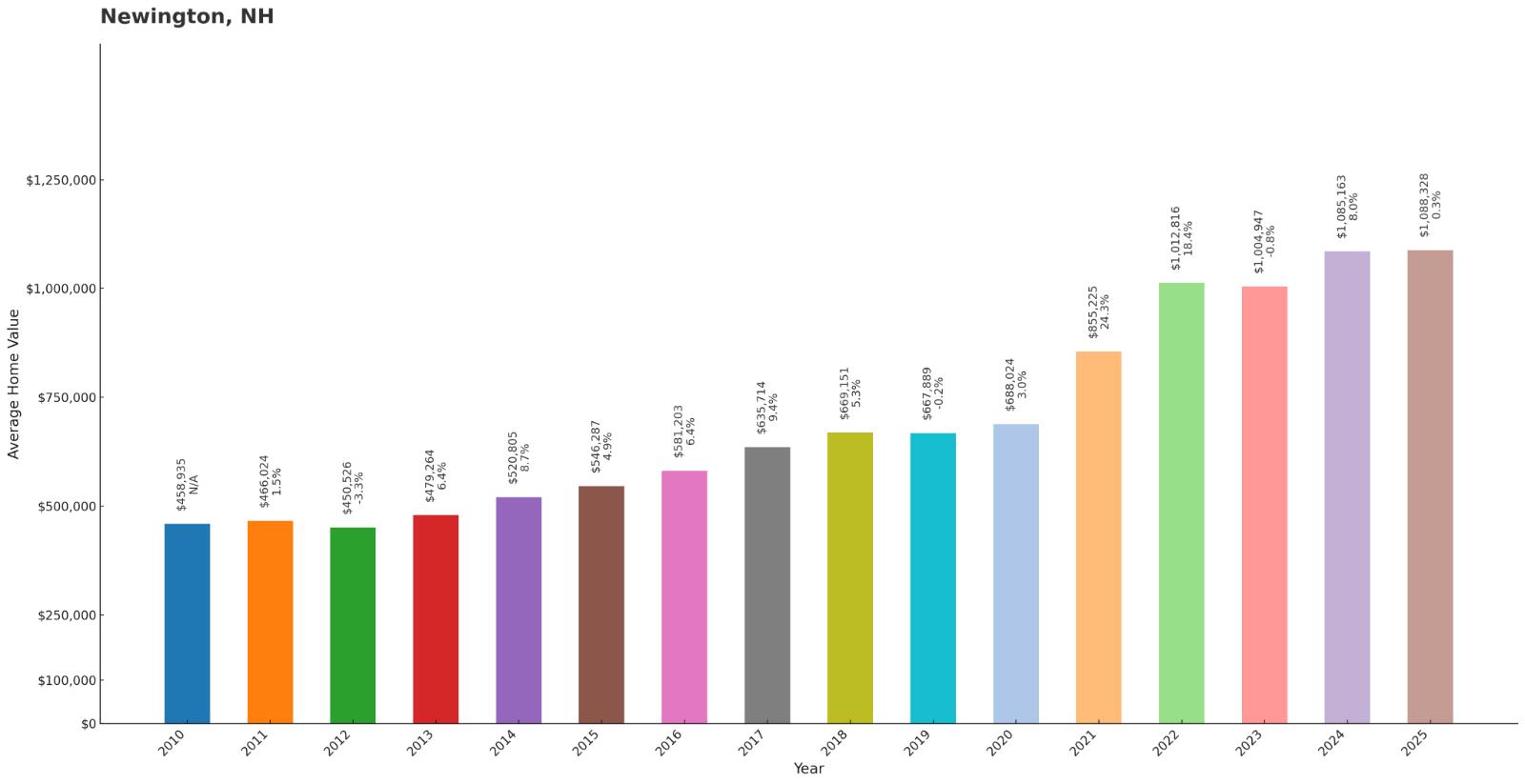
- 2010: $458,935
- 2011: $466,024
- 2012: $450,526
- 2013: $479,264
- 2014: $520,805
- 2015: $546,287
- 2016: $581,203
- 2017: $635,714
- 2018: $669,151
- 2019: $667,889
- 2020: $688,024
- 2021: $855,225
- 2022: $1,012,816
- 2023: $1,004,947
- 2024: $1,085,163
- 2025: $1,088,328
Newington has grown by 137% since 2010, showing consistent appreciation with dramatic acceleration after 2020 that pushed values above $1 million. The town demonstrated steady growth throughout the decade before jumping from $688,024 in 2020 to current values of $1,088,328. This small Seacoast community benefits from waterfront location and proximity to Portsmouth employment.
Why Newington?

Why are people willing to pay so much to live here? What’s special about it?
Newington offers exclusive waterfront living with direct access to the Piscataqua River and Great Bay, providing exceptional boating and water recreation opportunities. The small town maintains rural character with large lots and privacy while offering convenient access to Portsmouth employment and cultural amenities. Residents enjoy the benefits of coastal living with small-town atmosphere and low population density.
The community features some of New Hampshire’s most valuable waterfront properties and maintains strict development standards that preserve exclusivity and property values. Limited inventory and high demand for waterfront access create strong appreciation potential. Newington attracts affluent buyers seeking the ultimate waterfront lifestyle with privacy and convenience.
How Newington Rise to Prominence
Newington’s development as an exclusive waterfront community grew from its strategic location on the Piscataqua River and Great Bay, providing exceptional water access and scenic beauty. Originally settled in the 1630s, the town maintained its rural character while developing some of the region’s most valuable waterfront properties. The area attracted wealthy residents seeking privacy and water access near Portsmouth.
The town’s commitment to preserving large lots and limiting development helped maintain exclusivity and property values throughout the 20th century. Newington’s strategic location between Portsmouth and the ocean made it attractive to affluent professionals seeking waterfront lifestyle with urban access. The community’s balance of exclusivity, natural beauty, and convenience continues to drive demand from premium buyers.
3 Interesting Tidbits
- Waterfront Excellence – Newington offers some of New Hampshire’s most exclusive waterfront properties with direct access to the Piscataqua River and Great Bay estuary system.
- Historic Legacy – The town features historic properties and landscapes that reflect centuries of careful development and preservation of natural beauty.
- Privacy Premium – With fewer than 800 residents, Newington maintains an exclusive, private atmosphere that appeals to affluent buyers seeking waterfront tranquility.
2. Rye – 156% Home Price Increase Since 2010
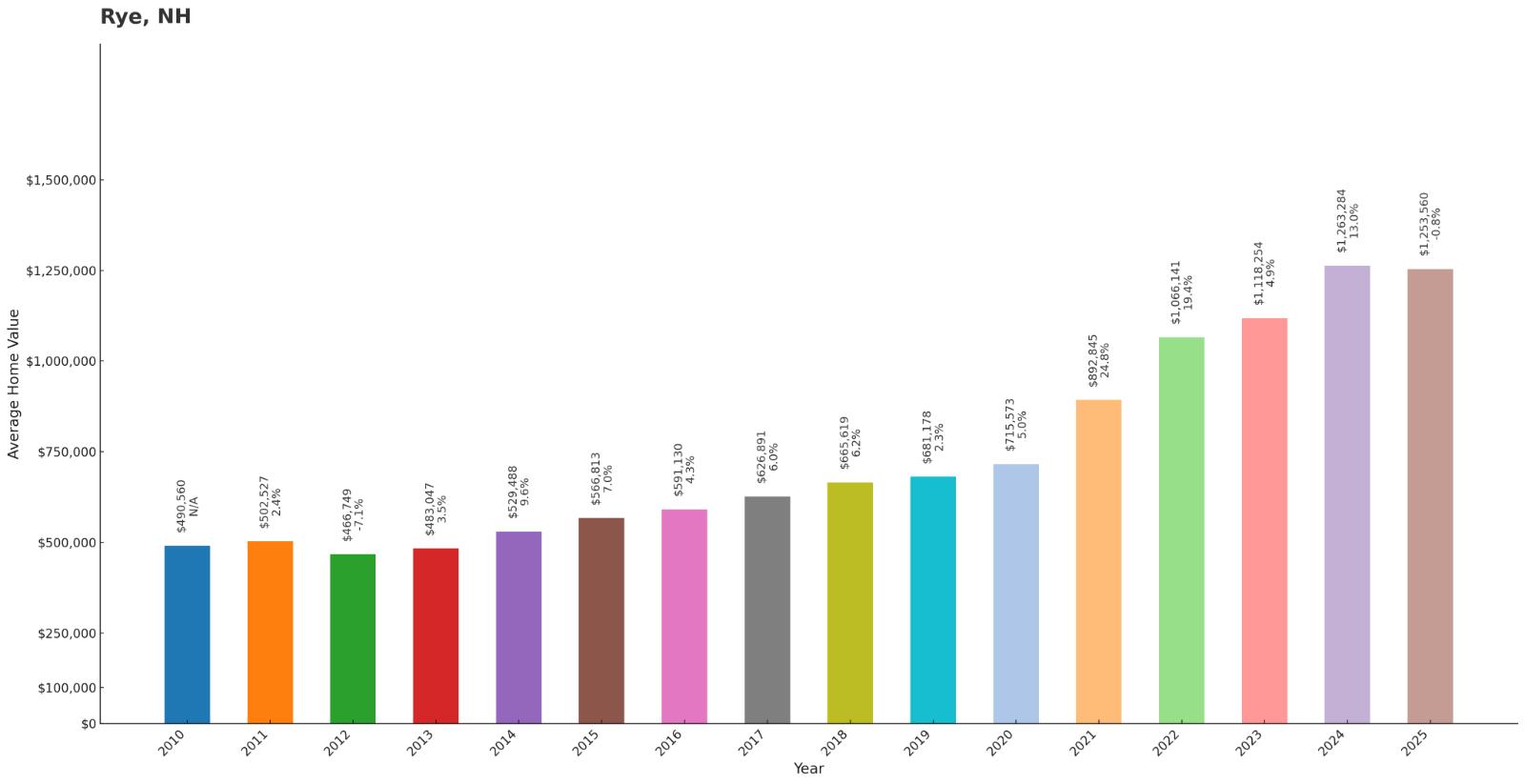
- 2010: $490,560
- 2011: $502,527
- 2012: $466,749
- 2013: $483,047
- 2014: $529,488
- 2015: $566,813
- 2016: $591,130
- 2017: $626,891
- 2018: $665,619
- 2019: $681,178
- 2020: $715,573
- 2021: $892,845
- 2022: $1,066,141
- 2023: $1,118,254
- 2024: $1,263,284
- 2025: $1,253,560
Rye has grown by 156% since 2010, showing consistent appreciation with dramatic acceleration after 2020 that pushed values well above $1.2 million. The town demonstrated steady growth throughout the decade with significant increases bringing current values to $1,253,560. This premier coastal community represents the ultimate in New Hampshire beachfront living.
Why Rye?
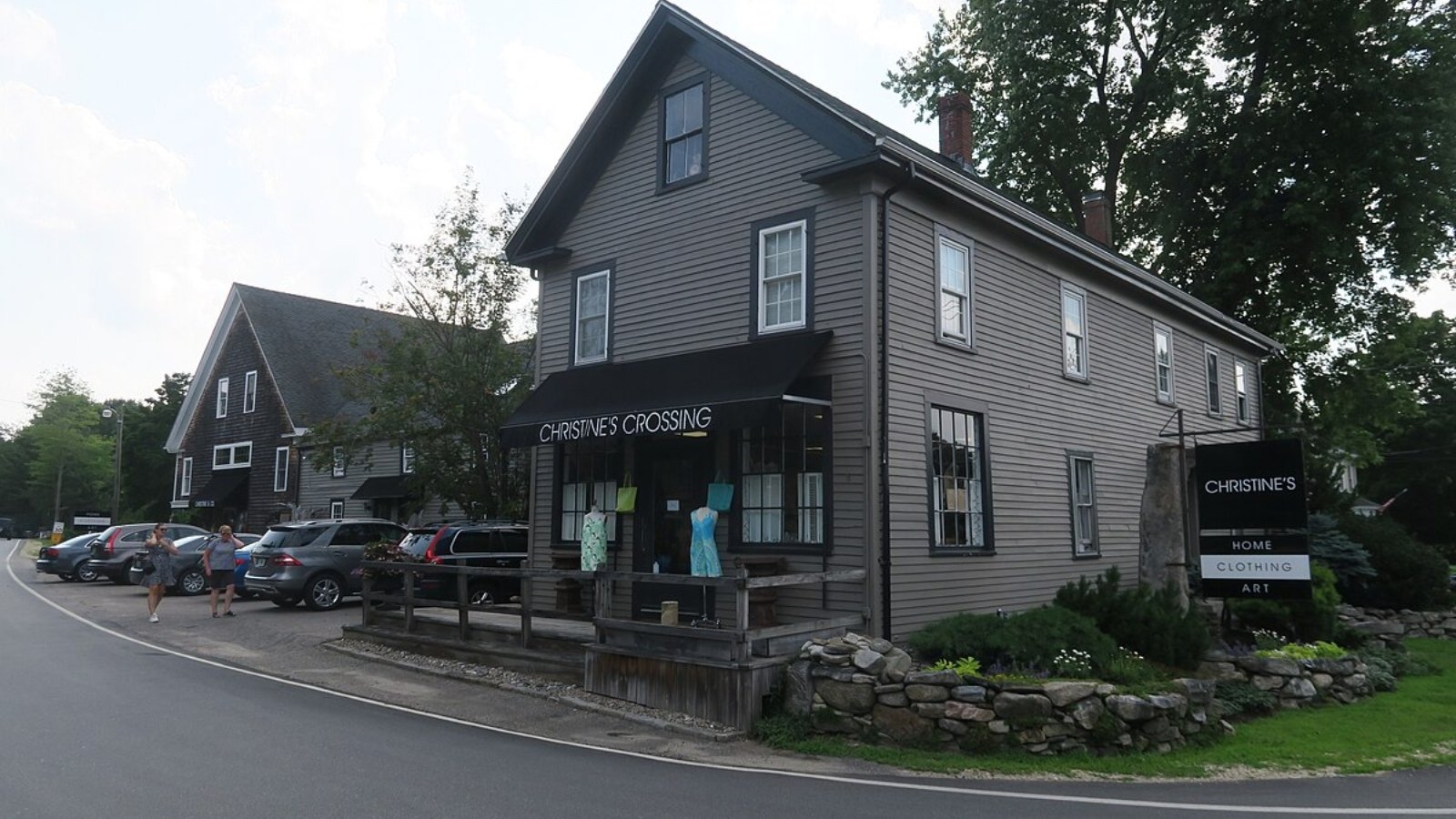
Why are people willing to pay so much to live here? What’s special about it?
Rye offers the most exclusive coastal living in New Hampshire, featuring pristine beaches, luxury homes, and direct Atlantic Ocean access that attracts the state’s most affluent residents. The town provides sophisticated amenities, excellent schools, and natural beauty that create the ultimate seaside lifestyle. Residents enjoy private beach access, world-class dining, and cultural events in an exclusive coastal setting.
The community features some of New England’s most valuable coastal properties with stunning ocean views and direct beach access that command premium prices. Limited inventory and exceptional natural beauty create strong appreciation potential and exclusivity. Rye attracts successful professionals, executives, and retirees seeking the pinnacle of coastal New England living.
How Rye Rose to Prominence
Rye’s development as New Hampshire’s premier coastal community began with its spectacular Atlantic coastline and early recognition as a summer destination for wealthy families. Originally settled in the 1620s, the town attracted affluent visitors who built grand summer estates along the pristine shoreline. The area became synonymous with exclusive coastal living and sophisticated seaside culture.
The town’s commitment to preserving its natural coastline and limiting development helped maintain the exclusivity and beauty that drive property values. Rye’s strategic location near Portsmouth and major cities made it attractive to successful professionals seeking the ultimate coastal retreat. The community’s balance of natural beauty, exclusivity, and sophistication continues to attract New England’s most affluent buyers.
3 Interesting Tidbits
- Coastal Crown Jewel – Rye features New Hampshire’s most exclusive beaches and coastal properties, with some of the highest property values in New England.
- Historic Elegance – The town preserves grand historic summer estates and coastal architecture that reflect generations of affluent residents and sophisticated development.
- Natural Protection – Rye maintains extensive conservation areas and protected coastline that preserve the natural beauty essential to its premium property values.
1. New Castle – 152% Home Price Increase Since 2010

- 2010: $901,398
- 2011: $902,911
- 2012: $867,687
- 2013: $898,464
- 2014: $977,048
- 2015: $1,014,069
- 2016: $1,017,197
- 2017: $1,112,621
- 2018: $1,156,502
- 2019: $1,192,005
- 2020: $1,213,414
- 2021: $1,523,440
- 2022: $1,868,641
- 2023: $1,874,340
- 2024: $2,212,788
- 2025: $2,273,282
New Castle stands alone as New Hampshire’s most expensive community, growing 152% since 2010 from an already premium baseline of over $900,000. The island town showed steady appreciation throughout the decade with dramatic acceleration after 2020, reaching extraordinary current values of $2,273,282. This exclusive coastal enclave represents the absolute pinnacle of New Hampshire luxury living.
Why New Castle?

Why are people willing to pay so much to live here? What’s special about it?
New Castle offers the ultimate in exclusive coastal living as New Hampshire’s only island community, providing complete privacy and luxury with stunning ocean views from every direction. The tiny town features historic charm, pristine beaches, and sophisticated amenities that attract the region’s most successful residents. Island living creates natural exclusivity with limited access and unmatched privacy that commands premium prices.
The community combines revolutionary history with modern luxury, offering residents a unique lifestyle that cannot be replicated elsewhere in New Hampshire. Property values reflect the absolute scarcity of island properties and the exceptional quality of life available in this exclusive setting. New Castle attracts ultra-affluent buyers seeking the ultimate coastal retreat with complete privacy and prestige.
How New Castle Rose to Prominence
New Castle’s prominence dates to its strategic military importance during colonial times, when Fort William and Mary protected Portsmouth Harbor from the island location. The community developed as home to wealthy merchants, sea captains, and political leaders who appreciated both the strategic advantages and natural beauty of island living. Historic grand estates established the area’s reputation for luxury and exclusivity.
The town’s unique geography as New Hampshire’s only island community created natural scarcity that enhanced property values throughout its history. Modern transportation improvements maintained accessibility while preserving the isolation and exclusivity that define island living. New Castle’s combination of history, natural beauty, and absolute uniqueness continues to attract the region’s most discerning buyers.
3 Interesting Tidbits
- Island Exclusivity – New Castle is New Hampshire’s only island town, creating natural scarcity and privacy that cannot be found anywhere else in the state.
- Revolutionary Legacy – Fort William and Mary on the island was the site of one of the first acts of rebellion against British rule, occurring months before the Boston Tea Party.
- Millionaire’s Row – The town features some of New England’s most valuable residential properties, with oceanfront estates commanding prices well above $2 million.


